Engineered Ceramics for Extreme Environments
Research Group:
- Designed Materials for the Energy and Environment
Catedráticos
Castro Arroyo, Miguel AngelCatedráticoUniversidad de Sevilla ✉ macastro@us.es ☎ 954 48 95 46 ✆ 446146 ORCID 0000-0001-6533-1343 Materiales de Diseño para la Energía y Medioambiente |
Jiménez Melendo, ManuelCatedráticoUniversidad de Sevilla ✉ melendo@us.es ☎ 954 55 97 36 ORCID 0000-0002-8423-5928 Materiales de Diseño para la Energía y Medioambiente |
Malet Maenner, María del PilarCatedráticaUniversidad de Sevilla ✉ malet@us.es Materiales de Diseño para la Energía y Medioambiente |
Martínez Fernández, JuliánCatedráticoUniversidad de Sevilla ✉ martinez@us.es ☎ 954 55 28 94 ORCID 0000-0002-1199-6638 Materiales de Diseño para la Energía y Medioambiente |
Ramírez de Arellano-López, AntonioCatedráticoUniversidad de Sevilla ✉ aral@us.es ☎ 954 55 97 32 Materiales de Diseño para la Energía y Medioambiente |
Ramírez Rico, JoaquínCatedráticoUniversidad de Sevilla ✉ jrr@us.es ☎ 954 55 97 58 ORCID 0000-0002-1184-0756 Materiales de Diseño para la Energía y Medioambiente |
Investigadores Científicos
Alba Carranza, María DoloresInvestigadora CientíficaCSIC ✉ alba@icmse.csic.es ☎ 954 48 95 46 ✆ 446146 ORCID 0000-0003-0025-3078 Materiales de Diseño para la Energía y Medioambiente |
Científicos Titulares
Benítez Jiménez, José JesúsCientífico TitularCSIC ✉ benitez@icmse.csic.es ☎ 954 48 95 51 ✆ 446147 ORCID 0000-0002-3222-0564 Materiales de Diseño para la Energía y Medioambiente |
Profesores Titulares
Bravo León, AlfonsoProfesor TitularUniversidad de Sevilla ✉ albravo@us.es ☎ 954 55 09 37 ORCID 0000-0001-7399-5190 Materiales de Diseño para la Energía y Medioambiente |
Pavón González, EsperanzaProfesora TitularUniversidad de Sevilla ✉ epavon@icmse.csic.es ORCID 0000-0002-4476-4403 Materiales de Diseño para la Energía y Medioambiente |
Doctores Contratados
Mesquita Coelho, Joao CarlosDoctor ContratadoUniversidad de Sevilla ✉ jmesquita@us.es ORCID 0000-0003-4217-3842 Materiales de Diseño para la Energía y Medioambiente |
Personal Investigador en Formación
Chaparro Barajas, Javier RamiroInvesigador en FormaciónUniversidad de Sevilla ORCID 0000-0001-6254-2962 Materiales de Diseño para la Energía y Medioambiente |
Thermochemical Energy storage materials enhanced by microstructural control

Investigador Principal: Luis Allan Pérez Maqueda / Pedro Enrique Sánchez Jiménez
Periodo: 01-09-2022 / 30-11-2024
Organismo Financiador: Ministerio de Ciencia e Innovación
Código: TED2021-131839B-C22
Componentes: Joaquín Ramírez Rico, José Manuel Valverde Millán, Antonio Perejón Pazo
Grupo de Investigación: Materiales de Diseño para la Energía y Medioambiente, Reactividad de Sólidos
The main objective of the MOTHERESE project is the development of a new concept of thermochemical energy storage based on the "Calcium-Looping" process. The novelty of the concept lies in scaling down the storage component and making it modular, easily integrated in power generation plants of different nature, storable and mobile. Subproject 2 focuses on aspects related to the development of materials suitable for these new operating conditions, as well as their optimization at this new scale.
The aim is to address the development of these materials with emphasis on preparation techniques that favor morphologies and microstructures that optimize (i) the kinetics of solid-gas reactions, in order to reduce residence times, (ii) multicyclic stability, minimizing deactivation by sintering and pore blocking, and (iii) active surface area, maximizing the amount of reagent available for conversion in each cycle. This will be achieved by using freeze casting and freeze granulation techniques, particularly suitable for the fabrication of ceramic structures with open porosity and directed morphology. The use of additives to improve the performance of the material is also considered. Finally, the integration of the active material and additives of high thermal conductivity in stable three-dimensional structures is contemplated, which not only improve the cyclability and efficiency of the active material but also ensure fast and efficient heat transfer, necessary for the modular system. Finally, new operating conditions compatible with the new scale will be explored, from low pressures to high pressures of up to 5 bar, always maintaining a closed cycle that avoids the need for gas separation.
MOTHERESE is committed to the circular economy, and therefore aims to use by-products and waste from other industries as a source of additives and even of the active material itself, CaO, favoring the use of waste. These include steel mill slag, biogenic carbonates (mollusks), cellulosic materials and rice husks (source of SiO2).
To address these objectives, the subproject has a multidisciplinary team of chemists, engineers, physicists and materials specialists with experience in the management and participation in national and international research projects, including relevant projects focused on thermochemical energy storage. In addition, the team has an international network of academic and industrial collaborators that would allow in the exploitation of the results obtained and the proposal of new international projects in this same line.
Upcycling of potato peel by-products into sustainable, multifunctional lacquers for food metal packaging (POP-UP)

Investigador Principal: José Jesús Benítez Jiménez / José Alejandro Heredia Guerrero (IHSM)
Periodo: 01-12-2022 / 30-11-2024
Organismo Financiador: Ministerio de Ciencia e Innovación
Código: TED2021-129656B-I00
Componentes: Eva María Domínguez Carmona (IHSM), Mª de la Montaña Durán Barrantes (IHSM), Antonio Heredia Bayona (IHSM), Jorge Rencoret Pazo (IRNAS), José Carlos del Río Andrate (IRNAS), Diego Francisco Romero Hinojosa (IHSM)
Grupo de Investigación: Materiales de Diseño para la Energía y Medioambiente
POP-UP project aims to provide, in terms of circular bioeconomy, sustainable, safe, and economically viable solutions to the massive use of petroleum-based BPA resins in food packaging through the fabrication of multifunctional, high-performance coatings for metal substrates from inexpensive, underutilized agro-food by-products. In particular, peels resulting from the industrial food processing of potatoes will be used as a bio-renewable resource of suberin monomers to fabricate biodegradable, bio-based lacquers by green and large-scalable technologies (i.e. spray from aqueous solutions and free-solvent, non-catalyzed melting polycondensation) for sustainable and innocuous food packaging. This suberin-based coating will offer same benefits and properties with respect to BPA resins, but it will be designed to be fully non-toxic and with antimicrobial properties. Hence, main objectives are related to improve food security, to contribute to an ecological transition from a linear fossil-based economy to a circular bioeconomy, and to increase agricultural productivity by upcycling plant residues.
Biomass for DEsalination via CApacitive Deionization and Energy Storage, “BioDECADES”

Investigador Principal: Joaquín Ramírez Rico
Periodo: 01-01-2022 / 31-12-2022
Organismo Financiador: Junta de Andalucía
Código: US-1380856
Componentes: Alfonso Bravo León, Manuel Jiménez Melendo, Julián Martínez Fernández
Grupo de Investigación: Materiales de Diseño para la Energía y Medioambiente
Water resources, global warming and the decline of fossil fuels are three of the main challenges that we as a society will have to address in the next decade. Solutions to these challenges rely on the development of new technologies that allow the efficient use and reuse of water resources, as well as on new, high power and high energy density storage systems to be coupled with renewable sources. These two seemingly unrelated topics currently rely on one technology: carbon adsorbents and electrodes. Both desalination and purification systems as well as supercapacitors and batteries use materials that are based on carbon, their structure modified through physical and/or chemical processes. Biomass is a cheap, widely available precursor for carbon materials, which can be obtained by pyrolysis. Both the choice of biomass as well as the actual process will determine the final properties of the carbon electrode, which can be tailored for targeted applications.
Capacitive deionization (CDI) is an emerging desalination technology with tunable salt removal levels, that uses a small voltage applied across two carbon electrodes to remove ions from solution by means of Electrosorption. The small amount of energy required means that such a system can be powered by a solar panel, making this technology useful in portable and deployable systems. Supercapacitors and batteries also rely on adsorption and/or intercalation mechanisms to store electric charge, in a process that is essentially the same but with a different final target as CDI. Both technologies rely on the use of carbon electrodes, with properties and structure tailored to each of the applications.
This proposal’s main objective is to use biomass residue as a precursor to develop tailored carbon electrodes for electrochemical applications related to energy and environmental technologies, with a focus on two main applications: energy storage in supercapacitor systems and batteries, and desalination via CDI. The main proposed synthesis approach for this electrodes will be the pyrolysis of biomass precursors, with a focus on biomass waste products such as grain husks, peels, pits and stones and other organic waste. In the case of monolithic electrodes, wood and wood-derived fiberboards will be the main focus. Chemical methods will be developed to functionalize the resulting carbons, to improve their capacitance or ion selectivity.
We will build a CDI testing rig to determine desalination behavior, and to correlate this with microscopic information obtained from advanced techniques such as electron microscopy, total scattering diffraction experiments, nitrogen adsorption isotherm, and others. We will test the electrochemical energy storage behavior and correlate it with structural properties and processing conditions. Our goal will be to optimize carbon electrodes derived from biomass for targeted applications, and to develop a menu of biomass derived carbon materials.
Biomorphic materials for energy storage (BioMatStor)

Investigador Principal: Joaquín Ramírez Rico
Periodo: 05-10-2021 / 31-03-2023
Organismo Financiador: Junta de Andalucía
Código: P20_011860 - PAIDI 2020
Componentes: María Dolores Alba Carranza, Alfonso Bravo León, Manuel Jiménez Melendo, Esperanza Pavón González
Grupo de Investigación: Materiales de Diseño para la Energía y Medioambiente
Biomass derived carbon materials will play a key role in several energy conversion and storage technologies in the future, with application in supercapacitors and batteries, power-to-X systems (fuel cells and electrolyzers), CO2 and H2 storage. Large amounts of biomass waste are generated in local agrofood industries. Among these wastes, the overall estimated production of olive stones in Spain is approximately 1,050,000–1,400,000 tons per year (campaign of 2017). The main use of this byproduct has been as solid biofuel for domestic applications, but given its abundance and low cost, this project presents an opportunity to convert what is considered waste into an added value product.
This proposal’s main objective is to develop tailored carbon materials for applications related to energy and environmental technologies, with a focus on three main applications: i) electrochemical energy storage; ii) catalyst supports in fuel cells and electrolyzers; iii) and gas storage and capture, with a focus on both hydrogen and carbon dioxide storage and separation processes. The main proposed synthesis approach for these materials will be the pyrolysis of biomass precursors, with a focus on biomass waste products such as grain husks, peels, pits and stones and other organic waste. A first objective will be to perform a survey of readily available biomass waste materials from regional agrofood industries. A second objective will be the investigation and optimization of pyrolysis and activation routes to obtain carbon materials with tailored properties for each of the applications targeted in this project. Lastly, a third objective is to assess the applicability and the potential for the application of these materials at commercial scale.
Extensive physical and chemical characterization of the obtained carbon materials will be performed and testing of the resulting materials for the targeted applications will allow us to tailor the processing parameters. A scale-up analysis, with definition of materials integration and systems configurations will be performed by means of simulations, as well as technological and industrial applicability evaluation and assessment of the feasibility of the proposed approach in the large scale. BioMatStor develops R&D at different levels of application: fundamental for materials science characterization and manufacturing, and applied science for energy storage systems modeling and characterization. This Project combines Materials Science and Energy Engineering with the goal of obtaining highly performing materials for a wide range of applications in energy production and storage. Such a proposal requires a multidisciplinary approach, as evidenced in the research team and collaborators. We propose a multidisciplinary approach which has its foundation in scientific excellence, responds to societal challenges and may result in a significant technology transfer to the industry. This project also addresses the socio-strategic goals of Horizon 2020 as it aims to contribute to the improvement of our environment through advanced science and multidisciplinary research. It is fully aligned with the objectives and policies of European Union, the Energy Union Energy, H2020, SET Plan and Andalucía region RIS3 objectives.
Proton conducting ceramics for high efficiency reversible electrolyzers and power to X applications

Investigador Principal: Joaquín Ramírez Rico / Ricardo Chacartegui Ramírez
Periodo: 01-06-2020 / 31-05-2023
Organismo Financiador: Ministerio de Ciencia e Innovación
Código: PID2019-107019RB-I00 "Retos de la Sociedad"
Componentes: Alfonso Bravo León, Manuel Jiménez Melendo, Julián Martínez Fernández, Miguel Torres García
Grupo de Investigación: Materiales de Diseño para la Energía y Medioambiente
PROCEX is aimed at the Social Challenge 3 “Secure, Clean and Efficient Energy”. It aims to open a new pathway for high-efficiency reversible electrolyzers for intermediate temperatures (around 500ºC). Its successful development would open a very promising pathway for energy storage systems in PV and Wind facilities with outstanding characteristics, round-trip efficiencies (75% or higher), and Energy Returned On Investment (>10). These values are much higher than those that can be reached with state of art of thermal energy storage systems. Besides, such a high efficiency concept electrolyzer would have a huge field of application for H2 production and application in the chemical industry. To develop such systems, several materials challenges need to be solved. In particular, novel electrolytes formulations with reduced electronic conductivities are needed.
The project is aimed at the identification and demonstration of new proton conducting ceramic materials that will have reduced electronic leakages in electrolysis operation, based on doping and co-doping strategies in barium cerate and zirconate systems. Emphasis will be placed not only in improving the efficiency but also the durability of such materials. The project will demonstrate the manufacturing of material and electrolyte at laboratory level and it will study the main reaction mechanisms developing models for their understanding and to support the pathways for concept application and scaling up. The project departs from results presented in literature this year that are fully aligned with capacities and previous experience of the participating R&D teams. The project will go further from these results extending the material compositions to develop, tailoring them to specific applications, widening the understanding of the reactions mechanisms and the effects of materials as well to the operation in the materials (i.e. degradation and aging effects). From this approach, within the project new models are expected to be developed and validated and the integration of the concept in different applications will be assessed. The ambition of the project requires a multidisciplinary approach that is developed by two R&D teams, from Material Science and Energy Engineering areas with all the capacities required for the successful development of the project: manufacturing, testing modelling and develop the new concepts and with expertise in materials processing and characterization, electrochemical models, and energy storage systems.
Unraveling the genetic and biophysical basis of tomato fruit cuticle formation

Investigador Principal: Eva María Domínguez Carmona (IHSM) / Rafael Muñoz Fernández (IHSM)
Periodo: 01-01-2019 / 30-06-2022
Organismo Financiador: Ministerio de Ciencia e Innovación
Código: RTI2018-094277-B-C22 "Retos de la Sociedad"
Componentes: José Jesús Benítez Jiménez, Manuel León Camacho (IG)
Grupo de Investigación: Materiales de Diseño para la Energía y Medioambiente
Waxes and phenolics are minor compounds of the tomato fruit cuticle that nevertheless play a significant role in determining several aspects related to fruit quality. Phenolics have been demonstrated to modulate fruit color appearance and cuticles stiffness, thus determining fruit sensitivity to cracking during ripening. They are not, however, the only contributors to the mechanical properties of the cuticle. In previous projects we located and validated five QTLs related to the amount of cuticle phenolics, identification of the genes responsible for these genomic regions will improve our understanding of this trait and how to modulate it in order to generate commercial lines with desirable combinations of fruit color and mechanical resistance. In this sense, a QTL analysis of the mechanical and thermal properties of the cuticle will be the first known approach to the genetic basis of a biophysical property. Cuticular waxes, on the other hand, are the major barrier to water permeability and, in this sense, regulate the hydric status of fruits during harvesting, post-harvest and storage. A preliminary analysis of wax content in the wild species related to the cultivated tomato, revealed two red-fruited species of potential interest for developing new varieties with tolerance to dehydrating environments. The analysis of water permeability and wax quality of the cuticle in this two species will be the first step towards this ultimate goal.
Bioceramic Materials for New Biomass Domestic Bolier Concept based on Porous Combustion for a Wide Biomass/Residues Feedstock

Investigador Principal: Joaquín Ramírez Rico
Periodo: 30-12-2016 / 31-12-2020
Organismo Financiador: Ministerio de Economía y Competitividad
Código: MAT2016-76526-R "Retos de la Sociedad"
Componentes: Julián Martínez Fernández, Manuel Jiménez Melendo
Grupo de Investigación: Materiales de Diseño para la Energía y Medioambiente
EU generates more than five tons of waste per person every year and about 60 % is organic waste. Current biomass domestic boiler technology does not allow the use of these residues with high efficiency, ultra-low emissions and high reliability operation. The main objective of this proposal is the development of a new concept of biomass domestic boiler technology able to combine these characteristics for operation with multiple biomass/residues blends. It is based on the integration of novel bioceramic porous materials matrices in combustion chamber and gases pathflow with functions as microporous combustors, particles filters and heat accumulators. These functions are simultaneous depending on the region of the boiler. Matrices of bioceramic materials are developed from wood precursors to obtain SiC elements through a process patented by the University of Seville. It uses local raw material, and produces parts with tailor made microstructure/properties, adequate for high temperature and reactive operation. Products with complex geometries can be obtained at relatively low cost compared with other materials of similar chemical and mechanical properties. The integration of components based on these materials allows new designs of biomass boilers with high control of combustion, temperature and particle emission. It avoids ash sintering and melting, acting on the formation and evolution mechanisms of ash and dioxins and activating the complete oxidation of CO and soots. The new concept allows the operation to a wider biomass/residues feedstock with low emissions and low maintenance even with fuels with high ash content, produced from many residues, solving main challenges for their extended use and increasing the European fuel resources for domestic heating. Domestic heating in Europe consumes 30% of the total energy. The proposal includes prototypes development, fuel supply characteristics and preparation (geometry, compactness, composition, etc.) and combustion products management. Biomass/residues blends from agriculture, forestry, olive oil industry among others will be tested both in laboratory .
Genetic basis of the composition and biophysical properties of tomato fruit cuticle: exploiting natural variability

Investigador Principal: Fafael Fernández Muñoz (IHSM)
Periodo: 01-01-2016 / 31-12-2018
Organismo Financiador: Ministerio de Economía y Competitividad
Código: AGL2015-65246-R
Componentes: José Jesús Benítez, Fernando Gallardo Alba (UMA), Antonio Heredia Bayona (IHSM)
Grupo de Investigación: Materiales de Diseño para la Energía y Medioambiente
Production of fruits with high quality and added value is currently an important challenge in agriculture. The cuticle that covers the outer epidermal cell walls plays a significant role in tomato fruit quality mainly in its external appearance (color, glossiness, texture, uniformity), in the occurrence of disorders of great economical importance such as fruit cracking, and also in the maintanance of fruit water status during postharvest. In previous projects (AGL2006-12494, AGL2009-12134 and AGL2012-32613) of which this can be considered a continuation, the important role of cuticle on fruit cracking and how changes in cuticle biomechanical properties affect cracking were highlighted. Moreover, it was shown that cuticle flavonoids, which are involved in the color of ripen fruits, play an important role in the regulation of cuticle synthesis and water permeability. Both a recombinant inbred (RIL) and an introgression line (IL) S. lycopersicum x S. pimpinellifolium populations will be used for validation and identification of QTLs and candidate genes involved in the deposition of different cuticle components (waxes, cutin, flavonoids, polysaccharides) and also for identification of QTL/genomic regions associated to unstudied cuticle traits such as thickness and density. This multidisciplinary approach, that includes cuticle biophysical analyses, will allow designing tomato cultivars with adequate biomechanical and hydrodinamical properties to reduce cracking, maintaining fruit water status during postharvest and avoiding skin traits undesirable for consumers. A collection of wild tomato species accessions will be studied and will provide insights in cuticle evolution within the Lycopersicon taxon. This evolutionary study could reveal different combinations of components and structures that will be useful to increase the current cuticle variability for future breeding programs.
Susteinable industrial waste treatment: designed adsorbent materials and bionanocomposites for inmobilizing heavy metals and fision products

Investigador Principal: Maria Dolores Alba Carranza
Periodo: 01-01-2016 / 30-06-2019
Organismo Financiador: Ministerio de Economía y Competitividad
Código: MAT2015-63929-R
Componentes: Miguel Angel Castro Arroyo, Ana Carmen Perdigón Aller, María del Mar Orta Cuevas
Grupo de Investigación: Materiales de Diseño para la Energía y Medioambiente
The focus of the project addresses the requirement of advanced environmental technology methodologies for removing pollutants. Recently, the interest and efforts to develop new technologies for more efficient treatments for the immobilization and the revaluation of hazardous waste are increasing in R & D plans. The overall object of the project is based on the design of a strategy of functionalization of highly charged swelling phyllosilicates and their later transformation on bionanocomposite for the effective retention and immobilization of hazardous waste, both cationic and anionic. This object represents a qualitative change in the work that is being nowdays developed in the field of model adsorbents systems with environmental applications that will improve the quality life of the population and the environmental conservation, because the designed functionalization of the synthetic silicates will allow the adsorption of a wide range of adsorbents in different oxidation states, cationic or anionic. The objectives are conformed to the Focus Area WASTE of the H2020 program and it is developed on the 2nd and 5th challenge of the H2020 program and on the 5th and 3rd challenge of the national research program.
The project has attracted interest from various observers companies, EPOs, (ENRESA and the Water and Local Energy Agency and Sustainability of the City of Seville), the public-private collaboration being promoted. Therefore, the research combines the basic principles of the National Strategy of Science and Technology: Putting the R&D&I at the service of citizens, social welfare and sustainable development, making the R&D&I a factor of improving business competitiveness (transfer of results to the private sector, see interest of EPOs) and recognize and promote R&D&I as an essential element for the generation of new excellence knowledge.
The viability of the proposal is ensured, first, because the research team, RT, has accomplished the synthesis of hydratable high charged phyllosilicates, with a novel and original method that allows setting the material desired charge, and, later, has successfully achieved their organofunctionalization (patent ES 2 362 597 B1). Second, the RT has developed the required methodology for the development of this project in closed scientific collaboration with other well recognized international groups (i.e. CNRS-University of Lille, University of Cambridge...). The RT enhances the clustering of their capabilities and scientific-technical skills which are essential to address this proposal with a remarkable transverse character.
Adsorption mechanisms study of harmful anionic pollutants by tailor-made aluminosilicates

Investigador Principal: Esperanza Pavón González
Periodo: 01-02-2015 / 28-02-2017
Organismo Financiador: Junta de Andalucía
Código: TAHUB-082. Programa Talent HUB
Componentes:
Grupo de Investigación: Materiales de Diseño para la Energía y Medioambiente
The scientific, technological and industrial development carried out in the second half of last century has caused an increasing pollution in the natural environment. Consequently, a widespread recognition of the need to develop technologies and strategies for pollution control has arisen in the recent times. The main objective of this Project is to design swelling layered silicates of high charge and their surface modification for an effective activity with respect to the retention and immobilization of toxic and dangerous anionic wastes.
The proposed methodology consists on the synthesis of high charge swelling mica with isomorphic substitution of Si4+ by Al3+ with a charge density in the range of brittle mica but with a cation exchange and swelling capacities unusual in these silicates. In order to enhance the anionic adsorption capacity, the mica will be functionalized in the surface with magnetite and with the inclusion of alkylammonium cations in their interlayer space.
An immobilization protocol of harmful anionic products like AsO42-, SO42- will be established, using the best adsorbent in function of both the structure and the funcionalization of the highly charged swelling mica. Afterwards, the applicability of these adsorption reactions will be tested in actual contaminated soils from Chili and Spain.
Development of processes for the catalytic combustion of hydrogen and study of the integration in devices for portable applications

Investigador Principal: Asunción Fernández Camacho
Periodo: 16-05-2014 / 15-05-2016
Organismo Financiador: Junta de Andalucía
Código: P12-TEp-862
Componentes: Julián Martínez, Gisela Arzac, Dirk Hufschmidt, Joaquín Ramírez, M.Carmen Vera, Vanda Godinho, Lionel Cervera, T.Cristina Rojas, Olga Montes, Mariana Paladini, Jaime Caballero-Hernández
Grupo de Investigación: Materiales Nanoestructurados y Microestructura, Propiedades mecánicas, modelización y caracterización de cerámicos avanzados
Hydrogen is an attractive candidate as a vector for storage and transport of energy in the context of an increased use of renewable and clean energies. The production and use of energy based on hydrogen technology is particularly important for small-scale portable (and potentially scalable for stationary) applications. In this project the process of catalytic (controlled) combustion of hydrogen will be investigated in the various aspects that could lead to a final integrated configuration with a H2 generation system for portable applications. For that the project will take advantage of the synergy of integrating two researcher groups from the PAI: i) The TEP217 group, specialists in storage and generation of hydrogen based on metal hydrides, complex hydrides and hydride composites reactive systems; and in the use of catalysts and additives to control and improve the kinetics of these processes. ii) The FQM342, specialist group for the fabrication of porous ceramics of high interest as catalyst supports for harsh combustion environments. Further collaboration is completed with the participation of the company Abengoa Hidrógeno SA that will be involved as sub-contractor as specialist in systems for the production and storage of hydrogen.
In particular we will work on this project in the following lines:
1.- Development of catalysts and supports for catalytic combustion. Typically porous biomorphic silicon carbide ceramics and classic noble metal catalysts, as well as new low cost catalysts to be developed in the project.
2.- Development of reactors needed for the study of the catalytic combustion. Typically hydrogen flows from a few ml/min to the scale of a H2 generator already available in the range 0.5 to 1.5 L/min.
3.- Coupling the catalytic combustion system with a portable hydrogen generation systems that we have developed in previous projects.
4.- Application of the sputtering technology in an exploratory manner in this project to deposit the catalyst materials for the H2 catalytic combustion on porous substrates.
5.- Microstructural and chemical characterization of the supports and catalysts in the nanoscale to follow the procedures of synthesis and evolution in operation.
Inmobilization of heavy metals by synthetic high-charged organomicas: Test at laboratory scale

Investigador Principal: María Dolores Alba Carranza
Periodo: 16-05-2014 / 16-02-2019
Organismo Financiador: Junta de Andalucía
Código: P12-FQM-567
Componentes:
Grupo de Investigación: Materiales de Diseño para la Energía y Medioambiente
The focus of the project addresses the environmental technological requirement to develop advanced methods for removing pollutants. The interest and efforts to develop new technologies aimed at more efficient treatment in detention and revaluation of hazardous waste is increasing in R & D plans. It is in this scenario where this project should be framed and in particular in the framework of the management of heavy metal cations, issue of high public interest in this decade.
Since the second half of the twentieth century, humanity has faced a huge scientific and technological development that is responsible for increased environmental pollution. As an example, we can mention two problems that are currently of concern and action of the Andalusian: Andalusian coastal pollution and urban wastewater. Therefore, this is a complex problem that pollutants sources are varied of origin and routes followed by various pollutants are diverse and, frequently, it is beyond the control necessary to avoid urban undesirable effects on the natural environment and. Therefore, a basic level research is demaned to implement the necessary mechanisms for the immobilization of such harmful cations.
The objectives and scope of this project are based on advances made by other research groups in the management of these types of contaminants and the latest research conducted by the research team that allowed design expandable high-charged layered silicates with special properties as precursors for the retention of harmful residues. Therefore, it is proposed in this project the organofunzionalization of such synthetic micas with thiol groups or alkylammonium cations of varying chain length and evaluation of its adsorption capacity and irreversible retention of heavy metals.
Bio-ceramics for diesel engine particulate filters

Investigador Principal: Julián Martínez Fernández / Ricado Chacartegui
Periodo: 01-01-2014 / 31-12-2016
Organismo Financiador: Ministerio de Economía y Competitividad
Código: MAT2013-41233-R (Programa Retos)
Componentes: José Antonio Becerra Villanueva, Alfonso Bravo León, Manuel Jiménez Melendo, Antonio Ramírez de Arellano López, Joaquín Ramirez Rico, Francisco Varela Feria
Grupo de Investigación: Materiales de Diseño para la Energía y Medioambiente
The importance of controlling particulate emissions from diesel engines is essential given its volume and the associated environmental and economic impact. Control systems based on modifications of the combustion process in the engine are not sufficient to meet the requirements of current regulations, less future ones, and therefore it must necessarily be employed post treatment systems such as filters. There is considerable scope for improving them both in reliability, degradation of control performance, durability, multifuel operation and cost reduction.
This project will assess the development and manufacturing of regenerative particulate filter for diesel engines to improve the current system specifications, based on a new generation of ceramic bio-derivated materials, with integrated systems for particle combustion. This objectives will be achieved integrating researchers synergies from: i ) Thermal Engines and Machines Group, GMTS , specialists in internal combustion engines ii ) Multifunctional Biomimetic Materials Group, MBM, specialists in obtaining bio-derivated porous ceramic as well as physical, chemical and microstructural characterization. In addition, the project is completed with the collaboration of companies in assessing technology and its industrial applicability.
The following research lines will be addressed:
- Determination of processing routes that enable the development of filter elements with suitable physical, and chemical properties, based on prior knowledge in bio-derivated materials and new technologies regarding the use of SiO2 gels.
- Identification of suitable catalysts and systems for its deposition.
- Manufacture of the filter elements consisting of porous support and catalyst.
- Thorough characterization of the physical, chemical and microstructural properties of interest for the application.
- Development of activation systems for the filter regeneration.
- Design and manufacturing of the filters with suitable geometry and prototype dimensions.
- Pilot unit design and study of the integration and operation of engine.
- Final design of the filter for industrial facility.Previous studies developed by MBM in these bio-derivated materials have demonstrated their potential as gas filter elements at high temperatures in coal gasification plants, which supports the likelihood of success of this project, which will address the improvements needed to develop the technology in the combustion conditions of diesel engines, under dynamic conditions in vehicles and regenerative filters.
A reduction of pollutant emissions from diesel engines would have a great environmental impact, health and economic development, with about 100 million diesel vehicles circulating in Europe and a related industry with over 2 million direct jobs and growing trend in market. This project addresses the Social Challenge 3 Horizon 2020, Secure, clean and efficient energy. In addition, using bioceramics allows replacement of metal components used today, which also aligns with the Social Challenge 5 of the Horizon 2020 in search of alternatives to essential raw materials in existing applications by reducing dependence on imports and sustainability of applications.
The obtention of fatty polyhydroxyalcanoate (PHA) bioplastics from peels residues of commercial fruits

Investigador Principal: José Jesús Benítez Jiménez
Periodo: 16-05-2013 / 15-05-2016
Organismo Financiador: Junta de Andalucía
Código: P11-TEP-7418 (Proyecto de Excelencia)
Componentes: Antonio Heredia Bayona, Miguel Angel San Miguel Barrera, Jaime Oviedo López, J. Alejandro Heredia Guerrero, Santiago Domínguez Meister, Daniel Aguilera Puerto, Francisco Javier Navas Martos, José Manuel de la Torre Ramírez
Grupo de Investigación: Materiales de Diseño para la Energía y Medioambiente
The main objective of this project is to evaluate the feasibility of scaling up a procedure to obtain fatty polyhydroxyalcanoate (PHA) bioplastics from a low-cost and abundant source like peels residues of commercial fruits. The strength of the proposal relies on the introduction of a new non-toxic and fully biodegradable polymeric material as a substitute for environmental-hostile petroleum-based plastics. The overall sustainability is extended to the use of a low-impact synthetic route and to the processing of a plant residue rather than crops intended for human or cattle feeding. The project is considered of additional interest in regions with an agricultural based economy like Andalusia and with an important environmental impact arising from the greenhouse activity. The proposal also covers the study of new and more specific applications of such bio-based fatty polyhydroxyalcanoates.
Fatty hydroxyacids molecular interactions as model for biomimetic polyester design

Investigador Principal: José Jesús Benítez Jiménez
Periodo: 01-01-2012 / 31-12-2014
Organismo Financiador: Ministerio de Ciencia e Innovación
Código: CTQ2011-24299
Componentes: Alejandro Heredia Guerrero, Miguel Angel San Mibuel Barrera, Jaime Oviedo López, Miguel Salmerón Batalle
Grupo de Investigación: Materiales de Diseño para la Energía y Medioambiente
The objective of this Project is to study and characterize the specific interactions between fatty carboxylic acids molecules arising from selective hydroxylation of the alkyl chain. To address this issue, molecular self-assembled systems showing a low interaction with an atomically flat support are proposed as models. The use of low binding energy supports is to ensure the packing structure to be mainly driven by the molecule to molecule interactions rather than the molecule to substrate adsorption. These self-assembled systems will be characterized by scanning probe microscopies such as AFM and STM and infrared spectroscopy. Results will be complemented with molecular dynamics atomistic simulations. Basic information obtained from self-assembled models will be used to design the in-vitro chemical synthesis of cutin mimetic polyesters. Cutin is a non toxic, fully biodegradable barrier biopolymer present at the skin of fruits, leaves and non lignified stems of higher plants. Physical (mechanical, water permeability, ionic transport, etc…) and chemical (ester yield, controlled chemical degradation rate, etc…) properties of synthetic polyesters will be determined. Material features will be related with both, the main structure arising from the ester bonds formation and the secondary network resulting from hydrogen bonding between spare non reacted hydroxyl groups. Structure-function patterns will be used to redesign the synthesis route to obtain polymeric esters with tailored properties. To achieve this goal, both the primary and secondary structural networks will be manipulated. In the first case non hydroxylated molecules will be used to prevent ester bonding propagation. To modify hydrogen bonding crosslinking, additives with selected hydroxylation (primary or secondary) will be employed. The final motivation of this research is to explore the applicability of such mimetic polyester as substitutes for the highly contaminant hydrocarbon based plastics.
Immobilization of cations in high-density charge confined spaces: management of harmful cations wastes

Investigador Principal: María Dolores Alba Carranza
Periodo: 01-01-2011 / 31-12-2013
Organismo Financiador: Ministerio de Ciencia e Innovación
Código: CTQ2010-14874/BQU
Componentes: Miguel Angel Castro Arroyo, Maria del Mar Orta Cuevas, Mery Carolina Pazos Zarama, Said ElMrabet, Esperanza Pavón González, Maria Villa Alfageme, Santiago Medina Carrasco, Ana Isabel Becerro Nieto, Alberto José Fernández Carrión
Grupo de Investigación: Materiales de Diseño para la Energía y Medioambiente
The central subject of this Project deals with the environmental technological exigency for development of advanced technologies for the elimination of polluting agents. The interest and the effort dedicated to the development of new technologies that allow more effective treatments of retention and new procedures of valorisation is increasing in numerous R&D plans in the last years. It is in this scene where the present proposal must be fitted and circumscribed into two experimental basic findings: designing expansible high layer charge silicates with a controlled distribution of active centres, which can be effective materials for the retention of hazardous and radioactive wastes, and obtaining insoluble disilicate phases in smooth conditions, appropriate for the immobilization of such species. This objective represents a qualitative change in the work that has been developed up to now in relation to the elimination of radioactive and toxic wastes as well as in the application of the methodology to silicate systems. The objectives are adapted, in general, to the high-priority lines of Basic Investigation of Chemistry, in the area of Inorganic Chemistry (Solid State Chemistry) and Environmental Chemistry in particular but, in spite of its basic character, the Project is adapted to diverse lines of investigation of Oriented Chemistry and it is supported by different EPOs (ENRESA, BEFESA and ALQUIMIA). These objectives, of eminent basic character, require the development of techniques of sophisticated analysis like advanced Solid State NMR, X-ray diffraction, under conditions of controlled pressure and temperature or gamma spectroscopy of low counts. This fact fits to the particular objective of the Chemistry Area of “using the instrumental and experimental technology for the study of materials” and with objective O2.5 (Enhance the availability of interdisciplinary infrastructures and sharing use of them) of the R+D+I National Plan 2008-2011. A guarantee of this proposal is that, in a first place, the Research Group (RG) has recently published the synthesis of expansible mica using a method that allows obtaining the desired layer charge in the material; secondly, the RG has a wide experience in the design of synthesis mechanisms of silicates as demonstrated by the number of papers published on this area during the last decade, and, finally, the RG has developed useful methodologies for the present Project in collaboration with other Groups with which it maintains a narrow scientific relationship.
Bioener: Aplicación de tecnologías biomiméticas a sistemas energéticos

Investigador Principal: Julián Martínez Fernández
Periodo: 01-01-2010 / 31-12-2012
Organismo Financiador: Junta de Andalucía
Código: P09-TEP-5152 (Proyecto de Excelencia)
Componentes: Manuel Jiménez Melendo, Antonio De Arellano-López, Alfonso Bravo León, F.M. Varela Feria
Grupo de Investigación: Materiales de Diseño para la Energía y Medioambiente
Technological advances have made possible to diversify and optimize energy produc-tion, which in turn has motivated the development of new ways to store energy. In particular, as production methods diversify, it is necessary to develop new materials for energy storage, both large scale and in consumer devices and transportation. This is especially important in the context of higher penetration of renewable energies, which often depend on climatological conditions and require ways to store excess energy at production peaks, so it can be used when production decreases. In parallel to this strategy and to reduce the share of fossil fuels in the overall energy production, it is necessary to increase the efficiency of conventional power generation sys-tems, for example by increasing material’s life and operating temperatures, for example in gas turbine systems, among others. The development of materials for high temperature applications, especially ceramics, has been traditionally linked to the search for increased efficiency of power generation systems. Ceramic materials, due to their high melting point, good creep resistance and resistance to corrosion, are seen as candidates for application in chemically aggressive environments at temperatures over 1000 ºC. Carbides and nitrides in particular are being studied extensively for this kind of applications. Porous ceramics are also of great interest in energy applications, such as heat exchangers or syngas filtration systems, among others. Among active research lines in the development of new materials for energy storage, electrochemical storage is expected to have the largest impact in the end consumer, as the design of high capacity batteries and electrochemical capacitors is key for the viability of tech-nologies such as plug-in electric cars. For this reason, research into new materials for electro-chemical storage has become a strong focal point among the scientific community and consti-tutes one to the great technological challenges of today. Biomorphic silicon carbide (bioSiC) is a ceramic material obtained by reactive infiltra-tion of carbon performs derived by pyrolysis of natural precursors. The precursor, usually wood, is rough-machined and then converted to carbon by pyrolysis in a controlled atmos-phere at high temperatures. The result is a macroporous carbon material (bioC) with a micro-structure that closely resembles that of the original precursor. This carbon template is then machined to near net shape and is melt reacted with silicon either in liquid or vapor phase to obtain a SiC composite with some residual Si that shows excellent thermomechanical proper-ties and a microstructure that closely mimics that of the original wood precursor. Tailoring the material’s properties is possible by adequate selection of the precursor, which determines the microstructure and thus the properties of the bioSiC. It is also possible to remove the remaining silicon through chemical etching to obtain a macroporous SiC material which can then be reinfiltrated to create novel composites and cermets, such as bioSiC/Al or bioSiC/Cu. The prospect of producing macroporous carbon materials with controlled nanoporosi-ty is interesting for electrochemical applications, as it would be possible to infiltrate or coat macropores with a second phase the provides additional function, for instance in three dimensional lithium batteries [3, 20] or carbon/oxide supercapacitors [4, 5]. In this way, the development of new carbon materials with controlled structure and porosity could open the door to novel architectures and designs for devices able to store larger amounts of energy. Most nanoporous carbon materials used nowadays are obtained through activation of carbons made from pyrolysis of synthetic precursors [21], although in the last years carbide-derived carbons have been the subject of great interest [22, 23, 24]. It is possible to obtain high-purity nanoporous carbon through high temperature chlorination of metallic carbides, which rank among the best carbon materials for electrochemical applications. In this direction, is has already been shown that carbides obtained from natural precursors, such as bioSiC are viable precursors to carbide-derived carbons [25]. This proposal’s aim is two-fold: on one side, the bioC processing will be studied in de-tail, paying special attention to precursor selection and to the possibility of introducing differ-ent atmospheres during the pyrolysis process, such as CO2 or water vapor, that promote nanoporosity in the material. The effect of processing parameter in the degree of crystallinity, nanoporosity, crystallite size and structure of the resulting carbon material will be assessed. The possibility of promoting carbon graphitization through the use of different catalysis in the pyrolysis process will be studied. The resulting carbon’s microstructure and physical properties will be studied and correlated to the processing parameters. On the other side, the effect of the aforementioned treatments on the bioSiC material will be studied, and the possibility of obtaining novel cermets in-situ, such as bioSiC/Al, bioSiC/Ti, through melt infiltration, will be assessed. In a last step, the possibility of obtained carbon materials with enhanced structure from the ceramic carbides will be explored.
Microestructura y deformación plástica a alta temperatura de óxidos eutécticos basados en Al2O3. Superplasticidad

Investigador Principal: Manuel Jiménez Melendo
Periodo: 01-01-2010 / 31-12-2012
Organismo Financiador: Ministerio de Ciencia y Tecnología
Código: MAT2009-13979-C03-01
Componentes: Julián Martínez Fernández, Antonio Ramírez De Arellano-López, Alfonso Bravo León, Caroline Clauss Klamp, F.M. Varela Feria, C. Vaquero Aguilar
Grupo de Investigación: Materiales de Diseño para la Energía y Medioambiente
This research addresses to produce binary and ternary oxide eutectics –specifically, Al2O3/ZrO2, Al2O3/Y3Al5O12(YAG), Al2O3/ZrO2/YAG and Al2O3/SiO2/ZrO2, zirconia being stabilized with different amounts of Y2O3– with well-controlled microstructures in the micro- to nanometric range for structural and thermal applications in efficient-enhanced power generation and conversion systems: fuel cells, chemical and high-temperature gas cooled reactors, thermal barriers of steels and super alloys in gas turbines and diesel engine components, etc. These materials are very attractive because of their excellent properties: high melting point, low density, thermal conductivity and chemical reactivity, and superior mechanical performance at both low and high temperature: mechanical strength close to 5 GPa at room temperature, and high creep, wear and erosion resistance. Very recently, superplasticity has been discovered in nanosized materials by the applicant team. Oxide eutectics will be produced by laser-assisted processing techniques in three configurations: bulk, plates (on ceramic and metallic substrates) and multilaminates. For the later configuration, microarquitectures with optimized residual stresses will be designed for enhanced mechanical and thermal performance. The residual stresses will be investigated by using piezo- and Raman spectroscopy, and the data compared to numerical predictions. Laser techniques will be also used to modify the microstructure of conventional ceramic coatings deposited on metallic engine components by Air Plasma Spray, and for machining of ceramic components to obtain a given functional geometry or to modify the external surfaces for improved wear behavior. One of the main goals of this Project is to produce materials with nanosized phases in order to achieve superplasticity (which contrasts with the superior creep resistance of mi-crosized materials). This capability opens the possibility of using superplastic joining and forming as processing methods for complex pieces with near net shape, recovering back its characteristic resistance after thermal treatments. The mechanical properties (flexural and compression resistance, elastic modulus, hardness, toughness and wear) will be evaluated from room temperature up to 1950 K in air as well as under other different environmental atmospheres in order to investigate their effect in the mechanical behavior or material degradation. A significant part of the Project is the structural and microstructural characterization of the as-received materials, and their evolution during mechanical tests. Such an investigation is critical to establish relationships between the experimental mechanical behavior (necessary for engineering designs) and the microstructural and processing parameters. To this end, techniques of optical (particularly confocal), electron (image, microanalysis and diffraction) and atomic force microscopy, and X-ray diffraction with texture facilities will be used. Mechanical and microstructural data will feedback the fabrication process in order to obtain materials with tailored properties for specific applications.
Structure, packing and tribology of Fatty Self-assembled monolayers of Alkylamines

Investigador Principal: José Jesús Benítez Jiménez
Periodo: 01-01-2009 / 31-12-2011
Organismo Financiador: Ministerio de Ciencia y Tecnología
Código: CTQ2008-00188
Componentes: Miguel Salmerón, Eduardo Garzón Garzón, Pedro J. Sánchez Soto, J. Alejandro Heredia Guerrero
Grupo de Investigación:
The aim of this research project is to study the contribution of molecular scale events to the tribological properties of self-assembled monolayers of alkyl molecules. The amount of topographic and frictional AFM data available on typical self-assembled systems such as thiols on gold and silanes on mica is very extensive. Here, we propose alkylamines on mica as a new self-assembled system. The reason is that the weaker interaction between the amino end group and mica, if compared with S-gold and silane-mica, leads to a less effective molecular packing. The ability to control the quality of molecular packing by tunning the preparation conditions is a good model to test the contribution of defects to friction. Molecular resolution using contact AFM is not possible on alkylamine self-assembled monolayers, so there is a lack of structural information on this system. The new methodology described in this project proposes the use of Scanning Polarization Force Microscopy (SPFM) to address this issue based on the high polarization signal contrast between mica and self-assembled layers. Furthermore, the high sensitivity of SPFM to the presence of water molecules filling vacancies, can be used to evaluate the quality of the molecular packing by monitoring the screening effect exerted by the self-assembled layer. Consequently, the study of both, the frictional and the SPFM properties of self-assembled monolayers of alquilamines, are complementary to describe the contribution of defects to friction.
Ceramic composites and low-dimensional phases to waste management

Investigador Principal: Miguel Angel Castro Arroyo
Periodo: 01-10-2007 / 30-09-2010
Organismo Financiador: Ministerio de Educación y Ciencia
Código: CTQ2007-63297
Componentes: Alba, M.D., Alvero, R., Becerro, A.I., Chain, P., Escudero, A., Naranjo, M., Trillo, J.M.
Grupo de Investigación: Materiales de Diseño para la Energía y Medioambiente
The main objective of this Project is obtaining composite materials from especially designed expansible and high layer charge laminar silicates containing low dimensional phases with effective activity for the retention and immobilization of toxic and dangerous wastes. The main innovating aspect of the Project arises, on one hand, from the confluence of the studies that the research team has performed with researchers from University of Cambridge (United Kingdom) within the development of the current national project. On the other hand, it arises from the action of reunification of the researchers who participate in a unique multidisciplinary project in the border of the basic chemistry of silicates in connection with the waste management. The proposed hypothesis, elaborated from the results obtained by the research team during the last decade, states that the effectiveness of the elimination of polluting agents by layered aluminosilicates is controlled by the structural disposition and the composition of the low dimensional phases originated during the treatments. Methodology is not limited to synthesis of the composite materials and its characterization, and it incorporates a measurement of the potential which they would represent in the treatment of wastes, essentially based on some organic polluting agents and heavy, toxic and radioactive cations. The development of the Project will affect the relations of the research team with Research Groups of the University of Bayreuth (Germany) and Cambridge (United Kingdom) and the multidisciplinary character of the Project and the noticeable academic and educational character of the team can be considered a guarantee of its high formative capacity.
Inmobilization of toxic and radioactive wastes by silicates

Investigador Principal: Miguel Angel Castro Arroyo
Periodo: 28-2-2007 / 1-3- 2010
Organismo Financiador: Junta de Andalucía
Código: P06-FQM-02179
Componentes: Alba, M.D., Alvero, R., Becerro, A.I., Chain, P., Escudero, A., Naranjo, M., Pavón, E., Trillo, J.
Grupo de Investigación: Materiales de Diseño para la Energía y Medioambiente
In The present Project tries to use high-charged silicates, which are designed under procedures that allow controling the quantity and distribution of the tetrahedral active centers. They will be submitted to a set of chemical soft treatments in order to inmobilize toxic elements. This project will be carried out in collaboration with BEFESA and ENRESA companies. Firstly, the effect that the experimental variables involved in the procedure of synthesis exert on the distribution of the active centers of the materials will be analyzed. In the second stage, the synthetic silicates will be treated under soft hydrothermal conditions with solutions containing carefully selected toxic and radioactive elements. Finally, the degree of retention of these elements in the new obtained phases will be estimated. The Research Team (R.T.) will incorporate an experimental methodology developed by itself that includes the combined employment of Nuclear Magnetic Resonance of Solids, X-ray Diffraction, X-rays Fluorescence and Microfluorescence, which will give information of the long range order and the local environment of the active centers of the residues, responsible of it dangerousness. It will have to give direct and not yet available information of the final mechanism of fixation, which is the main objective of this Project. The expected Results will bring basic useful information about the mechanisms of interaction of metallic ions with the framework of expansible aluminosilicates and its relation with the local arrangement of their atoms. Moreover, it will bring a useful knowledge allowing to develop new suitable procedures for immobilization of industrial waste, in collaboration with the companies of the sector, which marks the innovative character of the Project.
New Bio-ceramization processes applied to vegetable hierarchical structures

Investigador Principal: Julián Martínez Fernández
Periodo: 01-10-2006 / 30-09-2010
Organismo Financiador: Unión Europea
Código: STRP 033277 TEM-PLANT
Componentes: Ramírez de Arellano-López, A., Jiménez, M., Marrero, M., Clauss, M., Bravo, A., Quispe, J.J.
Grupo de Investigación: Materiales de Diseño para la Energía y Medioambiente
TEM-PLANT project focuses on the development and application of breakthrough processes to transform plant-derived hierarchical structures into templates for the exploitation of innovative biomedical devices with smart anisotropic performances and advanced biomechanical characteristics, designed for bone and ligament substitution. The TEM-PLANT project primary addresses the nano-biotechnologies area and will push the current boundaries of the state-of-the-art in production of hierarchical structured biomaterials. By combining biology, chemistry, materials science, nanotechnology and production technologies, new and complex plant transformation processes will be investigated to copy smart hierarchical structures existing in nature and to develop breakthrough biomaterials that could open the door to a whole new generation of biomedical applications for which no effective solution exists to date.
Starting from suitably selected vegetal raw material, ceramization processes based on pyrolysis will be applied to produce carbon templates, which will be either infiltrated by silicon to produce inert SiC ceramic structures or exchanged by electrophoresis deposition to produce bioresorbable ceramics. For ligament yielding two processes will be developed: pH-controlled and electrophoresis-controlled fibration to generate fibrous collagenous cords with high tensile strength and wear-resistance.
2023
2023
Materiales de Diseño para la Energía y Medioambiente
Plasticized, greaseproof chitin bioplastics with high transparency and biodegradability
Heredia-Guerrero, JA; Benitez, JJ; Porras-Vazquez, JM; Tedeschi, G; Morales, Y; Fernandez-Ortuno, D; Athanassiou, A; Guzman-Puyol, SFood Hydrocolloids, 145 (2023) 109072
Show abstract ▽
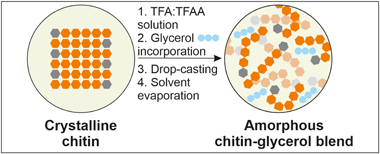
A mixture of trifluoroacetic acid:trifluoroacetic anhydride (TFA:TFAA) was used to dissolve chitin from shrimp shells. Free-standing films were prepared by blending the chitin solution and glycerol at different percentages, followed by drop-casting, and the complete evaporation of the solvents. After this process, the chitin matrix showed an amorphous molecular structure, as determined by X-ray diffraction. Optical, mechanical, thermal, and antioxidant properties were also thoroughly investigated. The incorporation of glycerol induced a plasticizing effect on the mechanical response of films and improved their transparency. In addition, hydrodynamic and barrier properties were determined by contact angle and water vapor/oxygen transmission rates, respectively, and revealed typical values of other polysaccharides. These bioplastics also presented an excellent greaseproof behavior with the highest degree of oil repellency as determined by the Kit test. Moreover, the overall migration was evaluated by using Tenax & REG; as a dry food simulant and levels were compliant with European regulations. Their antifungal properties were tested using Botrytis cinerea as a model. Biodegradability was also determined by measuring the biological oxygen demand in seawater. Degradation rates were high and similar to those of other fully-degradable materials.
December, 2023 | DOI: 10.1016/j.foodhyd.2023.109072
Materiales de Diseño para la Energía y Medioambiente
Incorporation of bioactive compounds from avocado by-products to ethyl cellulose-reinforced paper for food packaging applications
Acquavia, MA; Benitez, JEJ; Bianco, G; Crescenzi, MA; Hierrezuelo, J; Grife-Ruiz, M; Romero, D; Guzman-Puyol, S; Heredia-Guerrero, JAFood Chemistry, 429 (2023) 136906
Show abstract ▽
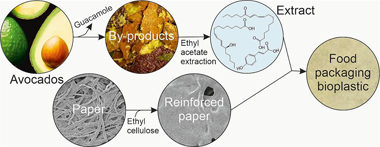
Reinforced films were fabricated by impregnating paper in ethyl cellulose solutions. After solvent evaporation, the infused ethyl cellulose acted as binder of the paper microfibres and occupied the pores and cavities, thus improving the mechanical and barrier properties. To prepare active films, avocado by-products from guacamole industrial production were extracted in ethyl acetate. Then, the extract (optimized to be rich in phenolic compounds and flavonoids and mainly composed by lipids) was incorporated to the paper reinforced with the highest content of ethyl cellulose. In general, the addition of the avocado by-products extract decreased the water uptake and permeability, improved the wettability, and increased the biodegradability in seawater and the antioxidant capacity. In addition, these films acted as barriers and retainers for Escherichia coli and Bacillus cereus. The potentiality of these materials for food packaging was demonstrated by low overall migrations and a similar food preservation to common low-density polyethylene.
December, 2023 | DOI: 10.1016/j.foodchem.2023.136906
Materiales de Diseño para la Energía y Medioambiente
A technological approach based on engineered nanoclay composites for cesium and iodine retention
Osuna, FJ; Pavon, E; Alba, MDChesmosphere, 341 (2023) 140128
Show abstract ▽
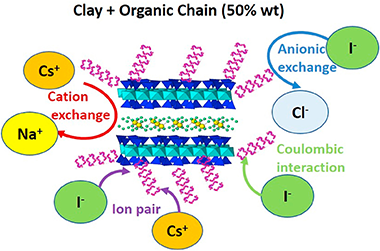
The development of effective and environmentally friendly methods for separating hazardous radionuclides from waste poses a significant technological challenge. 137Cs and 131I are among the most important radionuclides discharged into the environment by nuclear power plants. One of the best ways to eliminate them involves adsorption on clay minerals. In this regard, studies have demonstrated that organofunctionalized clay minerals are effective adsorbents. Thus, this study investigates the capability of organofunctionalized synthetic design clay minerals to jointly eliminate cesium and iodine. The adsorbents studied are a range of organofunctionalized clay minerals with alkylammonium cations of different alkyl chain lengths (2, 3 and 18) and some physical mixtures of raw clay minerals and octadecylammonium compounds. Organofunctionalized synthetic swelling highly charged micas are effective adsorbents for the simultaneous adsorption of cesium and iodine. In addition, the optimal system is a mixture of Na-M4 with octadecylammonium (50% w/w).
November, 2023 | DOI: 10.1016/j.chemosphere.2023.140128
Materiales de Diseño para la Energía y Medioambiente
Biodegradability Assessment of Prickly Pear Waste-Polymer Fibers under Soil Composting
Correa-Pacheco, ZN; Bautista-Baños, S; Benítez-Jiménez, JJ; Ortega-Gudiño, P; Cisneros-López, EO; Hernández-López, MPolymers, 15 (2023) 4164
Show abstract ▽
Nowadays, solving the problems associated with environmental pollution is of special interest. Therefore, in this work, the morphology and thermal and mechanical properties of extruded fibers based on polylactic acid (PLA) and poly(butylene adipate-co-terephthalate) (PBAT) added to prickly pear flour (PPF) under composting for 3 and 6 months were evaluated. The highest weight loss percentage (92 +/- 7%) was obtained after 6-month degradation of the PLA/PBAT/PPF/CO/AA blend, in which PPF, canola oil (CO), and adipic acid (AA) were added. Optical and scanning electron microscopy (SEM) revealed structural changes in the fibers as composting time increased. The main changes in the absorption bands observed by Fourier transform infrared spectroscopy (FTIR) were related to the decrease in -C=O (1740 cm-1) and -C-O (1100 cm-1) groups and at 1269 cm-1, associated with hemicellulose in the blends with PPF. Differential scanning calorimetry (DSC) showed an increase in the cold crystallization and melting point with degradation time, being more evident in the fibers with PPF, as well as a decrease in the mechanical properties, especially Young's modulus. The obtained results suggest that PPF residues could promote the biodegradability of PLA/PBAT-based fiber composites.
October, 2023 | DOI: 10.3390/polym15204164
Materiales de Diseño para la Energía y Medioambiente
Mechanical treatments on design powder ceramic materials: Insight into the textural and structural changes
Osuna, FJ; Fernández, M; Pavón, E; Sánchez, RMT; Alba, MDAdvanced Powder Technology, 34 (2023) 104189
Show abstract ▽
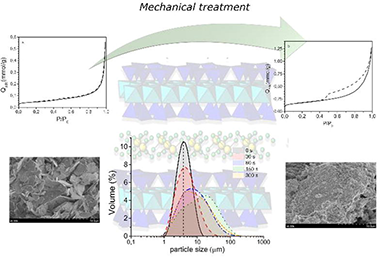
Mechanical treatment of porous ceramics, such as porous clay minerals, is a crucial step in ceramic processing. Among clay minerals, design swelling brittle micas have shown exceptional properties for further applications, although they exhibit low surface area and porosity. But, their mechanical activation could improve their textural properties and deserves to be investigated. Thus, the aim of this work was to evaluate the effects of gradual grinding in their surface and framework. At short grinding times, the surface area increases and mesoporous and microporous are generated. Long grinding time provokes particle agglomeration with the consequent change in their colloidal stability. At bulk level, framework defects are observed in both tetrahedral and octahedral sheets and increase with the total layer charge.
October, 2023 | DOI: 10.1016/j.apt.2023.104189
Materiales de Diseño para la Energía y Medioambiente
Sustainable Integration of Zinc Oxide Nanoparticles: Enhancing Properties of Poly(ε-Caprolactone) Electrospun Nanofibers and Cast Films
Abdullah, JAA; Benítez, JJ; Guerrero, A; Romero, ACoatings, 13 (2023) 1665
Show abstract ▽
This study investigated the impact of adding zinc oxide nanoparticles (ZnO-NPs) to electrospun membranes and cast films made of poly(epsilon-caprolactone) (PCL). The physicochemical, mechanical, and morphological properties of the samples were analyzed. Physicochemical parameters included water contact angle (WCA), water vapor transmission rate (WVTR), permeance, water vapor permeability (WVP), light transmission (T-600), and transparency (T). Mechanical properties, such as maximum stress (6(max)), elongation (epsilon(max)), and Young's modulus (MPa), were also evaluated. Morphological properties were analyzed in terms of thickness, dispersion, and surface roughness (measured by the arithmetic (Ra) and quadratic (Rq) averages). The crystallinity and melting point, as well as the functional DPPH center dot scavenging percentage (SP%), were also studied. The results showed that adding 1 wt% ZnO-NPs improved the water barrier properties of PCL membranes and films, increasing WCA by 1%-6% and decreasing WVTR by 11%-19%, permeance by 34%-20%, and WVP by 4%-11%, respectively. The T-600 values of PCL/ZnO-NPs membranes and films were 2-3 times lower than those of neat PCL samples, indicating improved optical properties. The mechanical properties of the composite membranes and films also improved, with 6(max) increasing by 56%-32% and Young's modulus increasing by 91%-95%, while epsilon(max) decreased by 79%-57%. The incorporation of ZnO-NPs also increased the thickness and surface roughness of the samples. The SP% of PCL/ZnO-NPs increased by almost 69%, demonstrating the beneficial effects of ZnO-NPs on the system. These findings suggest that incorporating ZnO-NPs into PCL membranes and films can enhance their properties, making them well suited for various applications, such as those within the realm of materials science and nanotechnology.
October, 2023 | DOI: 10.3390/coatings13101665
Materiales de Diseño para la Energía y Medioambiente
The Role of Protective Surface Coatings on the Thermal Stability of Delithiated Ni-Rich Layered Oxide Cathode Materials
Reissig, F; Ramirez-Rico, J; Placke, TJ; Winter, M; Schmuch, R; Gomez-Martin, ABatteries-Basel, 9 (2023) 245
Show abstract ▽
To achieve a broader public acceptance for electric vehicles based on lithium-ion battery (LIB) technology, long driving ranges, low cost, and high safety are needed. A promising pathway to address these key parameters lies in the further improvement of Ni-rich cathode materials for LIB cells. Despite the higher achieved capacities and thus energy densities, there are major drawbacks in terms of capacity retention and thermal stability (of the charged cathode) which are crucial for customer acceptance and can be mitigated by protecting cathode particles. We studied the impact of surface modifications on cycle life and thermal stability of LiNi0.90Co0.05Mn0.05O2 layered oxide cathodes with WO3 by a simple sol-gel coating process. Several advanced analytical techniques such as low-energy ion scattering, differential scanning calorimetry, and high-temperature synchrotron X-ray powder diffraction of delithiated cathode materials, as well as charge/discharge cycling give significant insights into the impact of surface coverage of the coatings on mitigating degradation mechanisms. The results show that successful surface modifications of WO3 with a surface coverage of only 20% can prolong the cycle life of an LIB cell and play a crucial role in improving the thermal stability and, hence, the safety of LIBs.
April, 2023 | DOI: 10.3390/batteries9050245
Materiales de Diseño para la Energía y Medioambiente
Effect of Mo and W interlayers on microstructure and mechanical properties of Si3N4-nickel-base superalloy joints
Singh, M; Fernandez, JM; Asthana, R; Ramirez-Rico, J; Valera-Feria, FMInternational Journal of Applied Ceramic Technology (2022)
Show abstract ▽
Si3N4/nickel-base superalloy (Inconel-625) and Si3N4/Si3N4 joints with refractory metal (W and Mo) interlayers were vacuum brazed using a Ti-active braze Cu-ABA (92.75Cu-3Si-2Al-2.25Ti) at 1317 K for 30 min with the following interlayered arrangements: Si3N4/Mo/W/Inconel and Si3N4/Mo/W/Si3N4. The joints exhibited Ti segregation at the Si3N4/Cu-ABA interface, elemental interdiffusion across the joint interfaces, and sound metallurgical bonding. Knoop microhardness profiles revealed hardness gradients across the joints that mimicked the interlayered arrangement. The compressive shear strength of Si3N4/Si3N4 joints both with and without W and Mo layers was similar to 142 MPa but the strength of Si3N4/Inconel joints increased from similar to 9 MPa for directly bonded joints without interlayers to 53.5 MPa for joints with Mo and W interlayers.
March, 2023 | DOI: 10.1111/ijac.14266
Materiales de Diseño para la Energía y Medioambiente
Bio-based lacquers from industrially processed tomato pomace for sustainable metal food packaging
Benitez, JJ; Ramirez-Pozo, MC; Duran-Barrantes, MM; Heredia, A; Tedeschi, G; Ceseracciu, L; Guzman-Puyol, S; Marrero-López, D; Becci, A; Amato, A; Heredia-Guerrero, JAJournal of Cleaner Production, 386 (2023) 1356836
Show abstract ▽

Bio-based lacquers prepared from an underutilized tomato processing residue such as pomace have been investigated as sustainable alternatives to bisphenol A (BPA)-based coatings for metal food packaging. The fabrication methodology consisted of a two-step process: spray-coating of a paste of the lipid fraction of tomato pomace with a mixture ethanol:H2O (3:1, v:v) on common metal substrates, used for food canning, such as aluminum (Al), chromium-coated tin-free steel (TFS), and electrochemically tin-plated steel (ETP), followed by the self melt-polycondensation of such lipid fraction. The polymerization reaction was conducted at 200 degrees C for different times (10, 20, 30, 40, 50, and 60 min) and was monitored by specular infrared spectroscopy, resulting in maximum degrees of esterification of-92% for Al and-85% for TFS and ETP substrates. The anticorrosion performance of the coatings was studied by electrochemical impedance spectroscopy at different immersion times (time intervals of 2-5 h during an overall stability test up to 170 h) in an aqueous solution of 1 wt% NaCl. The degree of polymerization and the physical properties of the coatings showed a strong dependence on the metal substrate used. In general, the best results were found for tomato pomace-based lacquers applied on aluminum, achieving higher mechanical strength (critical load of 1739 +/- 198 mN for Al, 1078 +/- 31 mN for ETP, and 852 +/- 206 mN for TFS), hydrophobicity (water contact angle-95 degrees for Al,-91 degrees for ETP, and-88 degrees for TFS), and improved anticorrosion performance (coating resistance of 0.7 M omega cm2 after 170 h of immersion for Al, 0.7 M omega cm2 after 70 h of immersion for TFS, and negligible coating resistance for ETP). In view of the technical innovation proposed in the present paper, the estimation of the environmental sustainability of the process has been considered relevant to fit the circular economy target. For this purpose, a life cycle analysis (LCA) was applied to the overall process, revealing multiple advantages for both the environment and human health.
February, 2023 | DOI: 10.1016/j.jclepro.2022.135836
Materiales de Diseño para la Energía y Medioambiente
Improved stability of design clay minerals at high temperature: A comparison study with natural ones
Osuna, FJ; Chaparro, JR; Pavon, E; Alba, MDCeramics International, 49 (2023) 5279-5291
Show abstract ▽
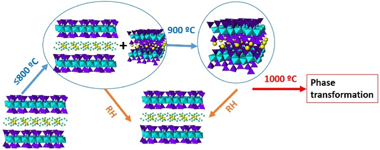
Clay minerals are ceramics materials that are involved in a wide range of economic uses. But, their structure and composition are modified by heating and, consequently, compromise their final applications. The actual tem-peratures at which changes occur vary greatly from one group to another group and even for different specimens within a given group. The aim of this research has been to evaluate the thermal behaviour of a set of design swelling micas, Na-Mica -n (Mn) and compare them with a set of natural smectites. All samples were heated in the range 200 degrees C to 1000 degrees C; afterwards, they were rehydrated thorough water suspension (0.4% wt). The results have shown that swelling micas have better property of hydration/dehydration than natural clay minerals and those with higher layer charge exhibited higher rehydration ability and dehydration temperature.
February, 2023 | DOI: 10.1016/j.ceramint.2022.10.046
Materiales y Procesos Catalíticos de Interés Ambiental y Energético
Revealing the Impact of Different Iron-Based Precursors on the ‘Catalytic’ Graphitization for Synthesis of Anode Materials for Lithium Ion Batteries
Frankenstein, L; Glomb, P; Ramirez-Rico, J; Winter, M; Placke, T; Gomez-Martin, AChemelectrochem, 10 (2023) e202201073
Show abstract ▽
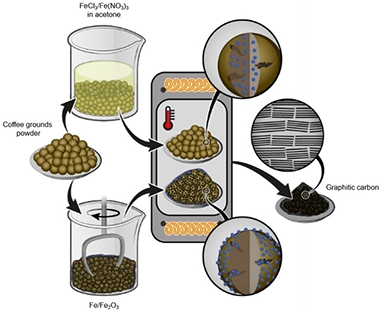
Low cost and environmentally friendly production of graphite anodes from naturally available biomass resources is of great importance to satisfy the increasing material demand for lithium ion batteries. Herein, graphitization of coffee ground was performed using four different iron-based activating additives, including iron (III) chloride, iron (III) nitrate, iron (III) oxide and pure iron, following either a wet or a dry mixing approach. The structural development regarding the type of activator used and the impact on the corresponding electrochemical performance are systematically investigated. A maximum degree of graphitization between 55 and 74 % (as determined by Raman spectroscopy) is attained using iron (III) chloride and iron powder, respectively. The graphitic anode material synthesized using iron powder reached a maximum reversible capacity of approximate to 320 mAh g(-1) at a rate of 0.1 C. This study provides significant insights into the impact of activators on the design of synthetic graphite from renewable sources.
| DOI: 10.1002/celc.202201073
2022
2022
Materiales de Diseño para la Energía y Medioambiente
Transparency of polymeric food packaging materials
Guzman-Puyol, Susana; Benitez, Jose J; Heredia-Guerrero, Jose AFood Research International, 161 (2022) 111792
Show abstract ▽
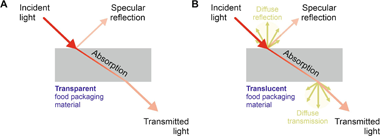
Transparency is a very important technical parameter to evaluate and validate certain food packaging materials. In the recent scientific literature, several methods (i.e. transmittance, opacity, haze, and absorbance) have been used and such variety hinders a direct comparison of results from different authors. In this Review, we describe and discuss the most widely employed methods to measure transparency, with special emphasis on two main parameters: transmittance and opacity. Moreover, a comparison of the different techniques is addressed and the typical values of transmittance and opacity of common transparent food packaging materials are provided. Our current opinion is that transparency should be expressed as transmittance in the visible range due to both the quickness and easiness of the measurement and the standardization of data. This information should be accompanied by the thickness value and a graphical image of the analysed samples for a useful and complete characterization.
November, 2022 | DOI: 10.1016/j.foodres.2022.111792
Materiales de Diseño para la Energía y Medioambiente
Insights into the Impact of Activators on the 'Catalytic' Graphitization to Design Anode Materials for Lithium Ion Batteries
Hanhart, V; Frankenstein, L; Ramirez-Rico, J; Diozios, V; Winter, M; Gomez-Martin, A; Placke, TChemelectrochem, 9 (2022) e202200819
Show abstract ▽
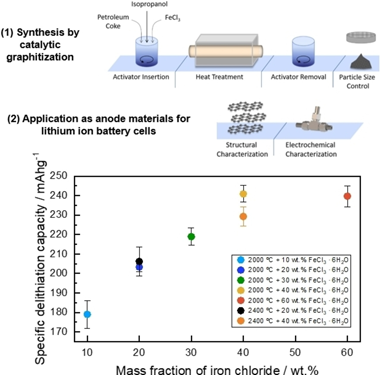
In this work, we systematically investigate the 'catalytic' graphitization of a biomass precursor (coffee ground) using 10-60 wt.% of the activator iron (III) chloride hexahydrate in a temperature range of 1000 degrees C-2400 degrees C. Special focus is put on the correlation of synthesis conditions, e.g., heat treatment temperature and mass fraction of iron chloride, with the electrochemical performance in carbon vertical bar vertical bar Li metal cells. The structural investigations of the materials reveal a positive impact of an increasing heat treatment temperature and/or mass fraction of inserted activator on the degree of graphitization and the delithiation capacity. However, a saturation point regarding the maximum degree of graphitization at 2000 degrees C and reversible capacity by the 'catalytic' graphitization approach using iron (III) chloride has been found. A maximum degree of graphitization of approximate to 69% could be reached by applying 2000 degrees C and 40 wt.% FeCl3 center dot 6H(2)O, resulting in a reversible capacity of 235 mAh g(-1).
November, 2022 | DOI: 10.1002/celc.202200819
Materiales de Diseño para la Energía y Medioambiente
Biopolymer-Based Films Reinforced with FexOy-Nanoparticles
Abdullah, JAA; Jimenez-Rosado, M; Benitez, JJ; Guerrero, A; Romero, APolymers, 14 (2022) 4487
Show abstract ▽
Nowadays, natural polymer-based films are considered potentially environmentally friendly alternatives to conventional plastic films, due to many advantageous properties, including their easy processability, high flexibility, non-toxicity, low cost, high availability, and environmental safety. However, they are limited in their application by a number of shortcomings, including their high water solubility and vapor permeability as well as their poor opacity and low mechanical resistance. Thus, nanoparticles, such as green FexOy-NPs, can be used to overcome the drawbacks associated with these materials. Therefore, the aim of this study was to develop three different polymer-based films (gelatin-based, cellulose acetate-based and chitosan-based films) containing green synthesized FexOy-NPs (1.0% w/w of the initial polymer weight) as an additive to improve film properties. This was accomplished by preparing the different films using the casting method and examining their physicochemical, mechanical, microstructural, and functional characteristics. The results show that the incorporation of FexOy-NPs into the different films significantly enhanced their physicochemical, mechanical, and morphological properties as well as their antioxidant characteristics. Consequently, it was possible to produce suitable natural polymer-based films with potential applications across a wide range of industries, including functional packaging for food, antioxidants, and antimicrobial additives for pharmaceutical and biomedical materials as well as pesticides for agriculture.
November, 2022 | DOI: 10.3390/polym14214487
Materiales de Diseño para la Energía y Medioambiente
Exploring the local environment of the engineered nanoclay Mica-4 under hydrothermal conditions using Eu(3+)as a luminescent probe
Martin-Rodriguez, R; Aguado, F; Alba, MD; Valiente, R; Pavon, E; Perdigon, ACJournal of Alloys and Compounds, 921 (2022) 166086
Show abstract ▽
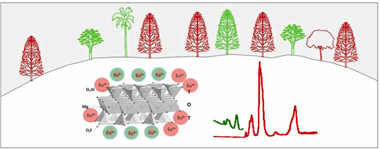
High charge mica Na4Al4Si4Mg6O20F4 , Mica-4, is a promising candidate as a filling material to immobilize high-level radioactive waste in deep geological repositories due to its extraordinary adsorption capacity. In contrast to traditional clay materials, the structural composition of this mica, with a high content of alu-minum in the tetrahedral sheet, enhances its chemical reactivity, favoring the formation of new crystalline phases under mild hydrothermal conditions, and thus providing a definitive isolation of the radionuclides in the engineered barrier. Moreover, this synthetic clay has some features that allow its use as an optical sensor by doping with luminescent rare earth cations such as Eu3+. In this paper we discuss the local structure of the nanoclay Mica-4 using Eu3+ as a local probe to track the physical and chemical modifica-tions under hydrothermal conditions. For that purpose, a set of hydrothermal experiments has been carried out heating Mica-4 and an aqueous Eu(NO3)(3) solution in a stainless steel reactor at different temperatures and times. Optical properties of the as-treated samples were characterized by spectroscopic measurements. The fine peak structure of emission and the relative intensity of different Eu3+ transitions as well as the luminescence lifetime have been correlated with the structure and composition of this nanoclay, and the interaction mechanisms between the lanthanide ions and the clay mineral at different temperatures and times. Special attention has been paid to understanding the role of the aluminum content, which may act as either an aggregating or dispersing agent, in the optical features and reactivity of the system.
November, 2022 | DOI: 10.1016/j.jallcom.2022.166086
Materiales de Diseño para la Energía y Medioambiente
Greaseproof, hydrophobic, and biodegradable food packaging bioplastics from C6-fluorinated cellulose esters
Guzman-Puyol, S; Tedeschi, G; Goldoni, L; Benitez, JJ; Ceseracciu, L; Koschella, A; Heinze, T; Athanassiou, A; Heredia-Guerrera, JAFood Hydrocolloids, 128 (2022) 107562
Show abstract ▽
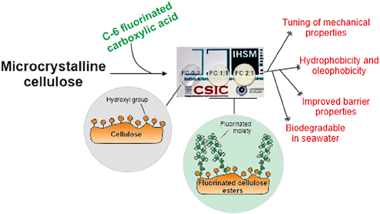
Tridecafluorononanoic acid (TFNA), a C6-fluorinated carboxylic acid, was esterified with cellulose at different molar ratios (0:1, 1:1, 2:1, and 3:1) in a trifluoroacetic acid (TFA):trifluoroacetic anhydride (TFAA):CHCl3 (2:1:1, v:v:v) solvent mixture. Free-standing films were obtained for all formulations and are presented as alternatives to composites and blends of paper with fluorinated molecules. Mechanical properties were investigated by tensile tests, and a plasticizer effect of fluorinated chains was observed. Interestingly, the wettability of these new cellulose derivatives was similar or even better than other common cellulose derivatives and fluorinated poly-mers employed in food packaging. Hydrodynamic properties were also improved by addition of TFNA, resulting in materials with water vapor permeability values comparable to other cellulose-based food packaging materials. In addition, films with the higher amounts of TFNA showed the required oil resistance for papers used in food packaging applications, as determined by the Kit Test. Finally, the biodegradation of these C6-fluorinated cel-lulose esters, assessed by biological oxygen demand (BOD) in seawater, was higher than typical bio-based polymers used in food packaging. The bioplastic synthesized at a molar ratio 1:1 (TFNA:cellulose) showed excellent performances in terms of greaseproof, hydrophobicity, ductility, and biodegradability, representing a sustainable alternative to typical plastics used in food packaging.
July, 2022 | DOI: 10.1016/j.foodhyd.2022.107562
Materiales de Diseño para la Energía y Medioambiente
Flame confinement in biomass combustion systems for particles abatement
Ciria, D; Orihuela, MP; Moreno-Naranjo, P; Chacartegui, R; Ramirez-Rico, J; Becerra, JAEnergy Conversion and Management, 264 (2022) 115706
Show abstract ▽
This work explores the use of open-pore, inert ceramic foams with different pore sizes as particle abatement systems in small biomass combustion systems. Porous foams made of silicon carbide with pore sizes 10 to 60 pores-per-inch were installed in an in-house designed combustion unit operated with wood pellets. Their effects on the temperature distribution inside the chamber, particulate and gases emissions were studied using different airflow rates in the reaction-limited regime (low equivalence ratio) to minimise stoichiometric factors. The influence of pore size, foam position with respect to the flame and space velocity were assessed. The confinement of the flame with inert foams was found to substantially modify the temperature distribution in the combustion chamber, improve the air-fuel mixture, and favour the thermal decomposition of the pellet, leading to a reduction in particulate emissions when compared to free-flame combustion at the same experimental conditions. In general, the amount of particulate matter was found to decrease by up to one order of magnitude as the pore size of the foam was reduced, while the temperature gradient in the combustion chamber was increased. Nitrogen oxides and carbon dioxide emissions were essentially unchanged, irrespectively of the pore size of the foam. It is expected that these values will be improved with longer residence times, as happens in operations with reduced excess air ratios. These results suggest that it is possible to control pollutants derived from domestic heating within the most restrictive current regulations on particulate emissions by integrating flame confinement designs with better operating practices and efficient abatement systems.
July, 2022 | DOI: 10.1016/j.enconman.2022.115706
Materiales de Diseño para la Energía y Medioambiente
Transparent, UV-blocking, and high barrier cellulose-based bioplastics with naringin as active food packaging materials
Guzman-Puyol, S; Hierrezuelo, J; Benitez, JJ; Tedeschi, G; Porras-Vazquez, JM; Heredia, A; Athanassiou, A; Romero, D; Heredia-Guerrero, JAInternational Journal of Biological Macromolecules, 209 (2022) 1985-1994
Show abstract ▽
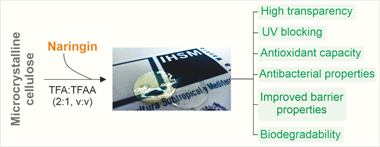
Free-standing, robust, and transparent bioplastics were obtained by blending cellulose and naringin at different proportions. Optical, thermal, mechanical, antioxidant, and antimicrobial properties were systematically investigated. In general, the incorporation of naringin produced important UV blocking and plasticizer effects and good antioxidant and antibacterial properties. Moreover, the barrier properties were characterized by determination of their water and oxygen transmission rates, finding that both parameters decreased by increasing the naringin content and reaching values similar to other petroleum-based plastics and cellulose derivatives used for food packaging applications. Finally, the biodegradability of these films was determined by measurement of the biological oxygen demand (BOD) in seawater, demonstrating an excellent decomposition in such conditions.
May, 2022 | DOI: 10.1016/j.ijbiomac.2022.04.177
Materiales de Diseño para la Energía y Medioambiente
High temperature mechanical properties of polycrystalline Y2SiO5
Cabezas-Rodríguez, R; Ciria, D; Martínez-Fernandez, J; Dezanneau, G; Karolak, F; Ramirez-Rico, JBoletin de la Sociedad Española de Ceramica y Vidrio, 61 (2022) S60-S68-228
Show abstract ▽
The high temperature mechanical properties of polycrystalline Y2SiO5 were studied in compression at temperatures in the range of 1200-1400 degrees C, both in constant strain rate and constant stress experiments. To examine the effect of grain size on the plastic deformation, two routes were used for the synthesis and sintering of Y2SiO5: one of solid state reaction followed by conventional sintering in air, and one of sol-gel synthesis followed by spark-plasma sintering, resulting in starting grain sizes of 2.2 and 0.9 mu m, respectively. Ceramics obtained by these routes exhibited different high-temperature compression behavior: while the conventionally processed ceramic exhibited grain growth during mechanical testing and a stress exponent close to one, compatible with diffusional creep, the spark-plasma sintered ceramic showed no grain growth but significant cavitation, a stress exponent close to two and partially superplastic behavior. These results have implications for the design and lifetime assessment of rare earth silicate-based environmental barrier coatings.
May, 2022 | DOI: 10.1016/j.bsecv.2021.09.008
Materiales de Diseño para la Energía y Medioambiente
Insight into the role of temperature, time and pH in the effective zirconium retention using clay minerals
Pavon, E; Alba, MDJournal of Environmental Chemical Engineering, 308 (2022) 114635
Show abstract ▽
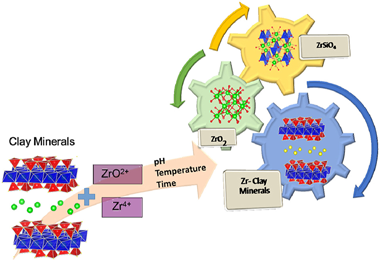
The use of zirconium in chemical industries generates a potential risk of Zr contamination in the environment, with particular concern for the decommissioning of uranium-graphite reactors. Among the natural adsorbents employed for the treatment of nuclear waste, clay minerals showed a very high affinity adsorption for radionuclides, but the influence of the chemical composition, pressure, temperature and time reaction have not yet been analysed on deep. Thus, the objective of this research is to explore several experimental conditions for an actual prediction of the behaviour of zirconium immobilization by clay minerals. The results have shown that factors such as zirconium cation nature (Zr4+ or ZrO2+), temperature, time and pH influence the extent of zirconium immobilization by clay minerals and the zirconium phases generated. At moderate conditions, zirconium tectosilicates are formed and evolve to zircon at high temperature and a longer time reaction.
April, 2022 | DOI: 10.1016/j.jenvman.2022.114635
Materiales de Diseño para la Energía y Medioambiente
Structural analysis of mixed alpha- and beta-amyrin samples
Gomez-Pulido, LDM; Gonzalez-Cano, RC; Benitez, JJ; Dominguez, E; Heredia, ARoyal Society Open Science, 9 (2022) 211787
Show abstract ▽
Little is known about the structure and molecular arrangement of alpha- and beta-amyrin, a class of triterpenoids found within the cuticle of higher plants. Blends of both amyrin isomers with different ratios have been studied taking into consideration a combined methodology of density functional theory (DFT) calculations with experimental data from scanning electron microscopy, differential scanning calorimetry and Raman vibrational spectroscopy. Results indicate that trigonal trimeric aggregations of isomer mixtures are more stable, especially in the 1 : 2 (alpha : beta) ratio. A combination of Raman spectroscopy and DFT calculations has allowed to develop an equation to determine the amount of beta-amyrin in a mixed sample.
April, 2022 | DOI: 10.1098/rsos.211787
Materiales de Diseño para la Energía y Medioambiente
Strength and thermal shock resistance of fiber-bonded Si-Al-C-O and Si-Ti-C-O ceramics
Vera, MC; Martinez-Fernandez, J; Singh, M; Ramirez-Rico, JInternational Journal of Applied Ceramic Technology, 19 (2022) 1126-1135
Show abstract ▽
Silicon carbide-based fiber-bonded ceramics, obtained from hot pressing of woven silicon carbide fibers, are a cost-effective alternative to ceramic-matrix composites due to their ease of fabrication, involving few processing steps, and competitive thermomechanical properties. In this work, we studied the high-temperature strength and thermal shock resistance of Si-Al-C-O and Si-Ti-C-O fiber-bonded SiC ceramics obtained from hot pressing of two types of ceramic fibers, by mechanical testing in four-point bending. The bending strength of Si-Al-C-O-based fiber-bonded ceramics at room temperature is similar to 250-260 MPa and remains constant with temperature, while the bending strength of Si-Ti-C-O increases slightly from the initial 220 to similar to 250 MPa for the highest temperature. Both materials retain up to 90% of their room temperature strength after thermal shocks of 1400 degrees C and show no reduction in elastic moduli. After thermal shock, failure mode is the same as in the case of as-received materials.
March, 2022 | DOI: 10.1111/ijac.13928
Materiales de Diseño para la Energía y Medioambiente
Iron-catalyzed graphitization for the synthesis of nanostructured graphitic carbons
Hunter, RD; Ramirez-Rico, J; Schnepp, ZJournal of Materials Chemistry A, 10 (2022) 4489-4516
Show abstract ▽
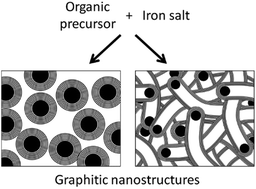
Carbons are versatile and diverse materials that have numerous applications across energy and environmental sciences. Carbons with a graphitic structure are particularly appealing due to their high chemical stability, large surface areas and high thermal and electronic conductivity. Numerous methods exist to produce nanostructured graphitic carbons but some of these can be energy-intensive and/or have problems with scalability. One option that is being increasingly explored is the process of iron-catalyzed graphitization. This simply involves the pyrolysis of carbon-rich precursors in the presence of an iron catalyst and has been used to produce carbons with a wide range of structures and properties. This review will examine the current field of iron-catalyzed graphitization, with a focus on molecular organic or biomass precursors. Bio-derived precursors are particularly attractive as a potential option for sustainable production of graphitic carbons. We start with a brief introduction to some key carbon structures, the current applications in which they are employed and some of the key methods that have been developed to produce nanostructured graphitic carbons. We will then review the history of catalytic graphitization before evaluating the wide range of conditions and precursors that have been employed in catalytic graphitization. Finally, this review will investigate the current challenges facing iron-catalyzed graphitization, looking particularly at the limitations of the current understanding of the mechanistic aspects of graphitization, with a view to outlining where research in this field might progress.
February, 2022 | DOI: 10.1039/d1ta09654k
Materiales de Diseño para la Energía y Medioambiente
The Response of Tomato Fruit Cuticle Membranes Against Heat and Light
Benitez, JJ; Moreno, AG; Guzman-Puyol, S; Heredia-Guerrero, JA; Heredia, A; Dominguez, EFrontiers in Plant Science, 12 (2022) 807723
Show abstract ▽
Two important biophysical properties, the thermal and UV-Vis screening capacity, of isolated tomato fruit cuticle membranes (CM) have been studied by differential scanning calorimetry (DSC) and UV-Vis spectrometry, respectively. A first order melting, corresponding to waxes, and a second order glass transition (T-g) thermal events have been observed. The glass transition was less defined and displaced toward higher temperatures along the fruit ripening. In immature and mature green fruits, the CM was always in the viscous and more fluid state but, in ripe fruits, daily and seasonal temperature fluctuations may cause the transition between the glassy and viscous states altering the mass transfer between the epidermal plant cells and the environment. CM dewaxing reduced the T-g value, as derived from the role of waxes as fillers. T-g reduction was more intense after polysaccharide removal due to their highly interwoven distribution within the cutin matrix that restricts the chain mobility. Such effect was amplified by the presence of phenolic compounds in ripe cuticle membranes. The structural rigidity induced by phenolics in tomato CMs was directly reflected in their mechanical elastic modulus. The heat capacity (Cp-rev) of cuticle membranes was found to depend on the developmental stage of the fruits and was higher in immature and green stages. The average Cp-rev value was above the one of air, which confers heat regulation capacity to CM. Cuticle membranes screened the UV-B light by 99% irrespectively the developmental stage of the fruit. As intra and epicuticular waxes contributed very little to the UV screening, this protection capacity is attributed to the absorption by cinnamic acid derivatives. However, the blocking capacity toward UV-A is mainly due to the CM thickness increment during growth and to the absorption by flavone chalconaringenin accumulated during ripening. The build-up of phenolic compounds was found to be an efficient mechanism to regulate both the thermal and UV screening properties of cuticle membranes.
January, 2022 | DOI: 10.3389/fpls.2021.807723
2021
2021
Materiales de Diseño para la Energía y Medioambiente
Mechanical Performances of Isolated Cuticles Along Tomato Fruit Growth and Ripening
Benitez, JJ; Guzman-Puyol, S; Vilaplana, F; Heredia-Guerrero, JA; Dominguez, E; Heredia, AFrontiers in Chemistry, 12 (2021) 787839
Show abstract ▽
The cuticle is the most external layer that protects fruits from the environment and constitutes the first shield against physical impacts. The preservation of its mechanical integrity is essential to avoid the access to epidermal cell walls and to prevent mass loss and damage that affect the commercial quality of fruits. The rheology of the cuticle is also very important to respond to the size modification along fruit growth and to regulate the diffusion of molecules from and toward the atmosphere. The mechanical performance of cuticles is regulated by the amount and assembly of its components (mainly cutin, polysaccharides, and waxes). In tomato fruit cuticles, phenolics, a minor cuticle component, have been found to have a strong influence on their mechanical behavior. To fully characterize the biomechanics of tomato fruit cuticle, transient creep, uniaxial tests, and multi strain dynamic mechanical analysis (DMA) measurements have been carried out. Two well-differentiated stages have been identified. At early stages of growth, characterized by a low phenolic content, the cuticle displays a soft elastic behavior. Upon increased phenolic accumulation during ripening, a progressive stiffening is observed. The increment of viscoelasticity in ripe fruit cuticles has also been associated with the presence of these compounds. The transition from the soft elastic to the more rigid viscoelastic regime can be explained by the cooperative association of phenolics with both the cutin and the polysaccharide fractions.
December, 2021 | DOI: 10.3389/fpls.2021.787839
Materiales de Diseño para la Energía y Medioambiente
Designed organomicaceous materials for efficient adsorption of iodine
Osuna, FJ; Pavon, E; Pazos, MC; Alba, MDJournal of Environmental Chemical Engineering, 9 (2021) 106577
Show abstract ▽
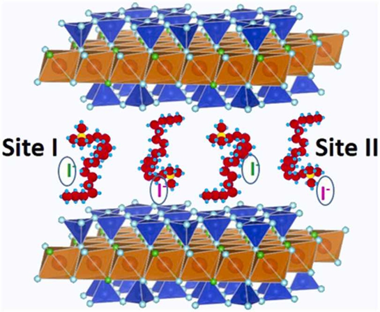
The anionic iodine I-129 has a significant contribution to overall long-term dose resulting from the nuclear waste storage and its immobilization by clay barrier is crucial. Organoclays have been tested as ideal adsorption materials, being the clay layer charge and the length and type of organic molecules the most relevant parameters affecting the adsorption. In this work, a family of designed organomicas are explored in term of iodine adsorption capacity. Their adsorption capacities were always higher than that of the traditional clays and organoclays. C-18-M4 shows a maximum monolayer adsorption capacity one order of magnitude higher than natural organoclays, with a free energy typical of physical adsorption and adsorption sites of high affinity. However, its surface is not homogeneous in terms of stability constant according to the Scatchard adsorption parameters. Hence, this study can provide a guidance for the design and construction of ultrahigh-capacity iodine adsorbents.
December, 2021 | DOI: 10.1016/j.jece.2021.106577
Materiales de Diseño para la Energía y Medioambiente
Waterproof-breathable films from multi-branched fluorinated cellulose esters
Tedeschi, G; Guzman-Puyol, S; Ceseracciu, L; Benitez, JJ; Goldoni, L; Koschella, A; Heinze, T; Cavallo, G; Dichiarante, V; Terraneo, G; Athanassiou, A; Metrangolo, P; Heredia-Guerrero, JACarbohydrate Polymers, 271 (2021) 118031
Show abstract ▽
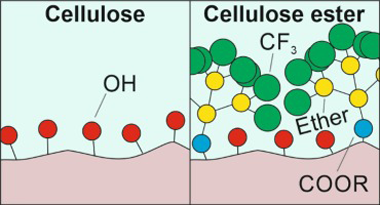
Cellulose ester films were prepared by esterification of cellulose with a multibranched fluorinated carboxylic acid, "BRFA" (BRanched Fluorinated Acid), at different anhydroglucose unit:BRFA molar ratios (i.e., 1:0, 10:1, 5:1, and 1:1). Morphological and optical analyses showed that cellulose-BRFA materials at molar ratios 10:1 and 5:1 formed flat and transparent films, while the one at 1:1 M ratio formed rough and translucent films. Degrees of substitution (DS) of 0.06, 0.09, and 0.23 were calculated by NMR for the samples at molar ratios 10:1, 5:1, and 1:1, respectively. ATR-FTIR spectroscopy confirmed the esterification. DSC thermograms showed a single glass transition, typical of amorphous polymers, at -11 degrees C. The presence of BRFA groups shifted the mechanical behavior from rigid to ductile and soft with increasing DS. Wettability was similar to standard fluoropolymers such as PTFE and PVDF. Finally, breathability and water uptake were characterized and found comparable to materials typically used in textiles.
November, 2021 | DOI: 10.1016/j.carbpol.2021.118031
Materiales de Diseño para la Energía y Medioambiente
Impact of flame confinement with inert ceramic foams on the particulate emissions of domestic heating systems
Ciria, D; Orihuela, MP; Becerra, JA; Chacartegui, R.; Ramirez-Rico, J.Fuel, 304 (2021) 121264
Show abstract ▽
Small solid biomass combustion systems are among the main contributors to the global particulate emissions share, and cheap, efficient abatement systems are not yet available for them. The placement of inert porous material to confine the combustion region is being recently explored as a possible mitigation system for this kind of pollution. However, given the complexity of biomass thermochemical decomposition processes, it is challenging to justify the performance of these systems on the basis of a physicochemical understanding. A foundational experiment-based study is carried out in this work to understand how combustion confinement affects the particulate emissions production mechanisms. A combustion unit was designed and built to systematically test ceramic foams with different porosities: keeping constant airflow and fuel feed rates. A comprehensive characterisation study was carried out on the solid biomass fuel, the temperature profile, the particulate emissions, and the remaining solid residue. The results evidenced that the use of foams has a substantial impact on the temperature distribution in the combustion chamber. The higher the cell density of the foam, the higher and more homogeneous are the temperatures reached in the combustion bed. This fact improved the thermal decomposition process of the pellets due to a better air-fuel mixture, leading to a reduction of the solid particulate matter emissions by more than 70%. These findings suggest that the use of an inert porous material above the combustion region might be a feasible solution for particulate emission control in small-size biomass combustion technology.
November, 2021 | DOI: 10.1016/j.fuel.2021.121264
Materiales de Diseño para la Energía y Medioambiente
By-products revaluation in the production of design micaceous materials
Mouchet, A; Raffin, F; Cota, A; Osuna, FJ; Pavon, E; Alba, MDAplied Clay Science, 214 (2021) 106292
Show abstract ▽
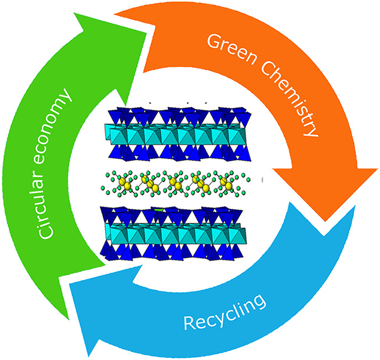
One of the main objectives of a sustainable development and circular economy is the recycling of by-products generated in industrial and agricultural production processes. One of the possible solution is the use of such by-product materials in the synthesis of environmental adsorbents. In the current research, we present the synthesis of a high charge swelling mica with enhance adsorbent properties from blast furnace slag and rice husk ash. Moreover, to ensure the sustainable synthesis a natural bentoniteis used as Si and Al source. Thus, the current study investigated the fabrication of swelling high charged micas, Na-Mn (n (layer charge) = 2 or 4), from FEBEX bentonite, blast furnace slag and rice husk ash thorough the NaCl melt method. The reaction yield, cation framework distribution and structural characteristic of micas have been studied thorough X-ray Diffraction and Solid State Nuclear Magnetic Resonance. The yields of Na-Mn synthesis and degree of purity of the mica depends on the nature of these precursors. Thus, a sustainable, non-expensive and environmental friendly process has been evaluated.
November, 2021 | DOI: 10.1016/j.clay.2021.106292
Materiales de Diseño para la Energía y Medioambiente
Zinc Polyaleuritate Ionomer Coatings as a Sustainable, Alternative Technology for Bisphenol A-Free Metal Packaging
Morselli, D; Cataldi, P; Paul, UC; Ceseracciu, L; Benitez, JJ; Scarpellini, A; Guzman-Puyol, S; Heredia, A; Valentini, P; Pompa, PP; Marrero-López, D; Athanassiou, A; Heredia-Guerrero, AACS Sustainable Chemistry & Engineering, 9 (2021) 15484-15495
Show abstract ▽
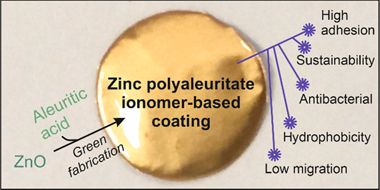
Sustainable coatings for metal food packaging were prepared from ZnO nanoparticles (obtained by the thermal decomposition of zinc acetate) and a naturally occurring polyhydroxylated fatty acid named aleuritic (or 9,10,16-trihydroxy-hexadecanoic) acid. Both components reacted, originating under specific conditions zinc polyaleuritate ionomers. The polymerization of aleuritic acid into polyaleuritate by a solvent-free, melt polycondensation reaction was investigated at different times (15, 30, 45, and 60 min), temperatures (140, 160, 180, and 200 degrees C), and proportions of zinc oxide and aleuritic acid (0:100, 5:95, 10:90, and 50:50, w/w). Kinetic rate constants calculated by infrared spectroscopy decreased with the amount of Zn due to the consumption of reactive carboxyl groups, while the activation energy of the polymerization decreased as a consequence of the catalyst effect of the metal. The adhesion and hardness of coatings were determined from scratch tests, obtaining values similar to robust polymers with high adherence. Water contact angles were typical of hydrophobic materials with values >= 94 degrees. Both mechanical properties and wettability were better than those of bisphenol A (BPA)-based resins and most likely are related to the low migration values determined using a hydrophilic food simulant. The presence of zinc provided a certain degree of antibacterial properties. The performance of the coatings against corrosion was studied by electrochemical impedance spectroscopy at different immersion times in an aqueous solution of NaCl. Considering the features of these biobased lacquers, they can be potential materials for bisphenol A-free metal packaging.
November, 2021 | DOI: 10.1021/acssuschemeng.1c04815
Materiales de Diseño para la Energía y Medioambiente
Pectin-cellulose nanocrystal biocomposites: Tuning of physical properties and biodegradability
Moreno, Ana Gonzalez; Guzman-Puyol, Susana; Dominguez, Eva; Benitez, Jose J.; Segado, Patricia; Lauciello, Simone; Ceseracciu, Luca; Porras-Vazquez, Jose M.; Leon-Reina, Laura; Heredia, Antonio; Heredia-Guerrero, Jose A.International Journal of Biological Macromolecules, 180 (2021) 709-717
Show abstract ▽
The fabrication of pectin-cellulose nanocrystal (CNC) biocomposites has been systematically investigated by blend-ing both polysaccharides at different relative concentrations. Circular free-standing films with a diameter of 9 cm were prepared by simple solution of these carbohydrates in water followed by drop-casting and solvent evaporation. The addition of pectin allows to finely tune the properties of the biocomposites. Textural characterization by AFM showed fibrous morphology and an increase in fiber diameter with pectin content. XRD analysis demonstrated that pectin incorporation also reduced the degree of crystallinity though no specific interaction between both poly-saccharides was detected, by ATR-FTIR spectroscopy. The optical properties of these biocomposites were character-ized for the first time and it was found that pectin in the blend reduced the reflectance of visible light and increased UV absorbance. Thermal stability, analyzed by TGA, was improved with the incorporation of pectin. Finally, pectin-cellulose nanocrystal biocomposites showed a good biodegradability in seawater, comparable to other common bioplastics such as cellulose and low-molecular weight polylactide, among others.
June, 2021 | DOI: 10.1016/j.ijbiomac.2021.03.126
Materiales de Diseño para la Energía y Medioambiente
New Trends in Nanoclay-Modified Sensors
Pavon, E; Martin-Rodriguez, R; Perdigon, AC; Alba, MDInorganics, 9 (2021) 43
Show abstract ▽
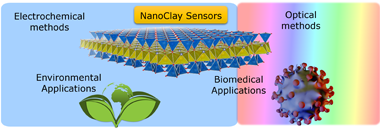
Nanoclays are widespread materials characterized by a layered structure in the nano-scale range. They have multiple applications in diverse scientific and industrial areas, mainly due to their swelling capacity, cation exchange capacity, and plasticity. Due to the cation exchange capacity, nanoclays can serve as host matrices for the stabilization of several molecules and, thus, they can be used as sensors by incorporating electroactive ions, biomolecules as enzymes, or fluorescence probes. In this review, the most recent applications as bioanalyte sensors are addressed, focusing on two main detection systems: electrochemical and optical methods. Particularly, the application of electrochemical sensors with clay-modified electrodes (CLME) for pesticide detection is described. Moreover, recent advances of both electrochemical and optical sensors based on nanoclays for diverse bioanalytes' detection such as glucose, H2O2, organic acids, proteins, or bacteria are also discussed. As it can be seen from this review, nanoclays can become a key factor in sensors' development, creating an emerging technology for the detection of bioanalytes, with application in both environmental and biomedical fields.
June, 2021 | DOI: 10.3390/inorganics9060043
Materiales de Diseño para la Energía y Medioambiente
Swelling layered minerals applications: A solid state NMR overview
Pavon, E; Alba, MDProgress in Nuclear Magnetic Resonance Spectroscopy, 124 (2021) 99-128
Show abstract ▽
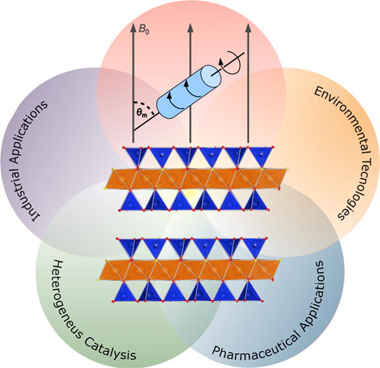
Swelling layered clay minerals form an important sub-group of the phyllosilicate family. They are characterized by their ability to expand or contract in the presence or absence of water. This property makes them useful for a variety of applications, ranging from environmental technologies to heteroge-neous catalysis, and including pharmaceutical and industrial applications. Solid State Nuclear Magnetic Resonance (SS-NMR) has been extensively applied in the characterization of these materials, providing useful information on their dynamics and structure that is inaccessible using other characterization methods such as X-ray diffraction. In this review, we present the key contributions of SS-NMR to the understanding of the mechanisms that govern some of the main applications associated to swelling clay minerals. The article is divided in two parts. The first part presents SS-NMR conventional applications to layered clay minerals, while the second part comprises an in-depth review of the information that SS-NMR can provide about the different properties of swelling layered clay minerals.
June, 2021 | DOI: 10.1016/j.pnmrs.2021.04.001
Materiales de Diseño para la Energía y Medioambiente
Structural Evolution in Iron-Catalyzed Graphitization of Hard Carbons
Gomez-Martin, A; Schnepp, Z; Ramirez-Rico, JChemistry of Materials, 33 (2021) 3087-3097
Show abstract ▽
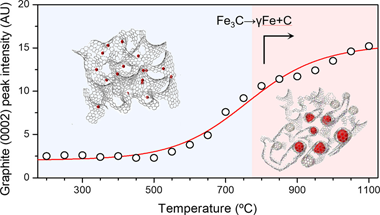
Despite the recent interest in catalytic graphitization to obtain graphite-like materials from hard-carbon sources, many aspects of its mechanism are still poorly unknown. We performed a series of in situ experiments to study phase transformations during graphitization of a hard-carbon precursor using an iron catalyst at temperatures up to 1100 degrees C and ex situ total scattering experiments up to 2000 degrees C to study the structural evolution of the resulting graphitized carbon. Our results show that upon heating and cooling, iron undergoes a series of reductions to form hematite, magnetite, and wustite before forming a carbide that later decomposes into metallic iron and additional graphite and that the graphitization fraction increases with increasing peak temperature. Structural development with temperature results in decreasing sheet curvature and increased stacking, along with a decrease in turbostratic disorder up to 1600 degrees C. Higher graphitization temperatures result in larger graphitic domains without further ordering of the graphene sheets. Our results have implications for the synthesis of novel biomass-derived carbon materials with enhanced crystallinity.
May, 2021 | DOI: 10.1021/acs.chemmater.0c04385
Materiales de Diseño para la Energía y Medioambiente
Organophilization of acid and thermal treated sepiolite for its application in BTEX adsorption from aqueous solutions
Varela, CF; Pazos, MC; Alba, MDJournal of Water Process Engineering, 40 (2021) 101949
Show abstract ▽
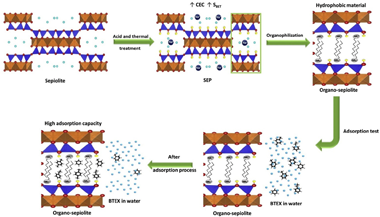
Acid and thermal treated sepiolite was organophilized by cationic exchange with several alkylammonium cations (octylammonium, hexadecylammonium, tetradecyltrimethylammonium, and hexadecyltrimethylammonium). The adsorption capacity of BTEX from aqueous solutions was evaluated through the adsorption isotherms performed in batch. The results were analysed using three isotherm models: Freundlich, Langmuir and Dubinin-Radushkevich (D-R model). The behaviour of adsorption isotherm suggested the multilayer coverage on a heterogeneous surface, which is according to the Freundlich isotherm model. The thermodynamic analyse using the D-R model show that physical mechanisms govern the process. The maximum adsorption capacity of BTEX on the obtained materials was in the range values of 81.19 mg g(-1) - 1448.42 mg g(-)(1), which are higher than those reported up to now. The organo-sepiolite materials exhibit a high potential in the adsorption of BTEX compounds from aqueous solutions.
April, 2021 | DOI: 10.1016/j.jwpe.2021.101949
Materiales de Diseño para la Energía y Medioambiente
Pb2+, Cd2+ and Hg2+ removal by designed functionalized swelling high-charged micas
Osuna, FJ; Pavon, E; Alba, MDScience of The Total Environment, 764 (2021) 142811
Show abstract ▽
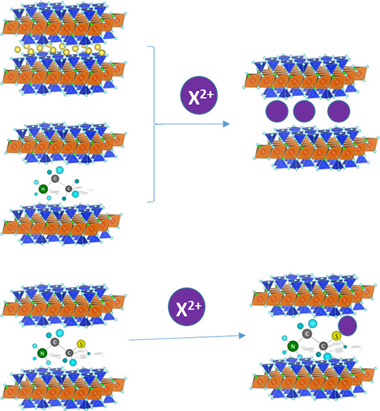
The increasing accumulation of toxic heavy metals in the environment has generated the need of efficient removal systems, being the adsorption method the most popular one applied in aqueous solutions. Of particular concern is the case of Pb2+, Cd2+ and Hg2+ due to their high potential hazard. In this paper, we describe the feasibility of a new family of nanomaterials, swelling high charge micas, in the removal of these cations from aqueous solutions. Batch adsorption experiments were carried out in the as-made micas, NaMn, and after functionalization with ethylammonium, EA-Mn, and mercaptoethylammonium, MEA-Mn. The results have demonstrated that all of them are efficient heavy metal adsorbents, being Na-M2 the best adsorbent for Pb2+ and Cd2+, and, MEA-M2 for Hg2+.
April, 2021 | DOI: 10.1016/j.scitotenv.2020.142811
Materiales de Diseño para la Energía y Medioambiente
Zirconium retention for minimizing environmental risk: Role of counterion and clay mineral
Montes, L; Pavon, E; Cota, A; AlbaChemosphere, 267 (2021) 128914
Show abstract ▽
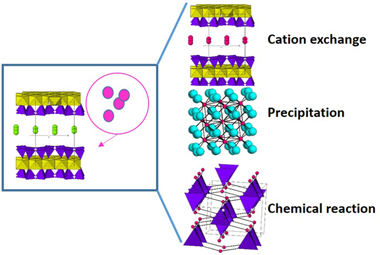
Zr(IV) together with U(IV) are the major components of high-level radionuclide waste (HLRW) and spent nuclear fuel (SNF) from nuclear power plants. Thus, their retention in the waste disposal is of great importance for the environmental risk control. Here, the influence of clay minerals on the retention of Zr(IV), as component of the nuclear waste and as chemical analogues of U(IV), has been evaluated. Three clay minerals, two bentonites and one saponite, were hydrothermally treated with three zirconium salts. A structural study at long-range order by X-ray diffraction and short-range order by NMR was performed to evaluate the generation of new zirconium phases and degradation of the clay minerals. Three immobilization mechanisms were observed: i) cation exchange of ZrO2+ or Zr4+ by clay minerals, ii) the precipitation/crystallization of ZrO2, and, iii) the chemical interaction of zirconium with the clay minerals, with the formation of zirconium silicates.
March, 2021 | DOI: 10.1016/j.chemosphere.2020.128914
2020
2020
Materiales de Diseño para la Energía y Medioambiente
Microstructure and thermal conductivity of Si-Al-C-O fiber bonded ceramics joined to refractory metals
Vera, MC; Martinez-Fernandez, J; Singh, M; Casalegno, V; Balagna, C; Ramirez-Rico, JMaterials Letters, 276 (2020) 128203
Show abstract ▽
We explore joining Si-Al-C-O fiber-bonded ceramics to Cu-clad-Mo using an Ag-Ti-Cu brazing alloy. A temperature of 900 degrees C and times in the range of 10-20 min are required to obtain sound joints irrespectively of the fiber orientation. The reaction layer is 1-2 mu m thick and free of pores and defects. The thermal conductivity of the joined samples is well described considering that the metal and the ceramic are in series for thermal resistance. This implies that the joint is highly conductive and forms an almost perfect
October, 2020 | DOI: 10.1016/j.matlet.2020.128203
Materiales de Diseño para la Energía y Medioambiente
Multiple pollutants removal by functionalized heterostructures based on Na-2-Mica
Pazos, MC; Bravo, LR; Ramos, SE; Osuna, FJ; Pavon, E; Alba, MDApplied Clay Science, 196 (2020) 105749
Show abstract ▽
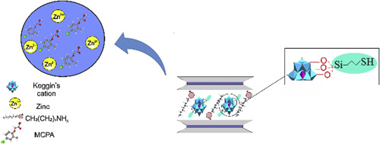
Organomica, C8-2-Mica, was obtained from a high charged synthetic mica, Na-2-Mica, by cation exchange reaction with octylammonium cations and these were used to host other bulky guest species such as polyhydroxy aluminium cations, Al(13)20. The hydrolization of 3-mercaptopropyltrimethoxysilane (MPTMS) allowed the covalent attachment with hydroxyl groups of the oligomeric cation, providing thiol groups that create specific adsorption sites, Al(13)20/SH. The structure of the adsorbents was analysed by XRD and Infrared spectroscopy and these were tested as an adsorbent for the removal of zinc and herbicide MCPA from aqueous solutions. C8-2-Mica was the best adsorbent for MCPA and thiol groups favoured the adsorption of Zn2+. Moreover, Al(13)20/SH showed excellent adsorptive properties for the simultaneous adsorption of MCPA and Zn2+.
October, 2020 | DOI: 10.1016/j.clay.2020.105749
Materiales de Diseño para la Energía y Medioambiente
Elucidating esterification reaction during deposition of cutin monomers from classical molecular dynamics simulations
Bueno, OVM; Benitez, JJ; San-Miguel, MAJournal of Molecular Modeling, 26 (2020) 280
Show abstract ▽
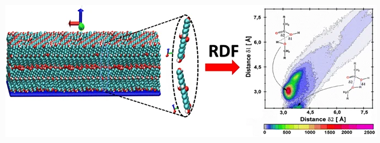
The structural behavior of some cutin monomers, when deposited on mica support, was extensively investigated by our research group. However, other events, such as esterification reaction (ER), are still a way to explore. In this paper, we explore possible ER that could occur when these monomers adsorb on support. Although classical molecular dynamics simulations are not able to capture reactive effects, here, we show that they become valuable strategies to analyze the initial structural configurations to predict the most favorable reaction routes. Thus, when depositing aleuritic acid (ALE), it is observed that the loss of capacity to form self-assembled (SA) systems favors different routes to occur ER. In pure ALE bilayers systems, an ER is given exclusively through the -COOH and primary -OH groups. In pure ALE monolayers systems, the ER does not happen when the system is self-assembled. However, for disorganized systems, it is able to occur by two possible routes: -COOH and primary -OH (route 1) and -COOH and secondary -OH (route 2). When palmitic acid (PAL) is added in small quantities, ALE SAMs can now form an ER. In this case, ER occurs mostly through the -COOH and secondary -OH groups. However, when the presence of PAL is dominant, ER can occur with either of both possibilities, that is, routes 1 and 2.
September, 2020 | DOI: 10.1007/s00894-020-04544-9
Materiales de Diseño para la Energía y Medioambiente
Novel procedure for laboratory scale production of composite functional filaments for additive manufacturing
Diaz-Garcia, A; Law, JY; Cota, A; Bellido-Correa, A; Ramirez-Rico, J; Schafer, R; Franco, VMaterials Today Communications, 24 (2020) 101049
Show abstract ▽
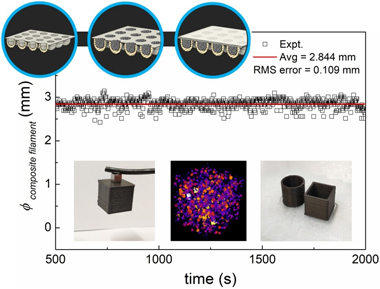
Successful 3D printing by material extrusion of functional parts for new devices requires high quality filaments. Uniform homogeneity and good dispersion of particles embedded in filaments typically takes several cycles of extrusion or well-prepared feedstock by injection molding, industrial kneaders or twin-screw compounding. These methods need specific production devices that are not available in many laboratories non-specialized in polymer research, such as those working on different material science and technology topics that try to connect with additive manufacturing. Therefore, laboratory studies are usually limited to compositions and filler concentrations provided by commercial companies. Here, we present an original laboratory scale methodology to custom-prepare the feedstock for extruding magnetic composite filaments for fused filament fabrication (FFF), which is attainable by a desktop single-screw extruder. It consists in encapsulating the fillers in custom made capsules that are used as feedstock and reach the melting area of the extruder maintaining the same concentration of fillers. Results have shown that our approach can create smooth and continuous composite filaments with good homogeneity and printability with fine level of dimensional control. We further show the good dispersion of the particles in the composite filament using X-Ray Tomography, which enabled a 3D reconstruction of the spacial distribution of the embedded magnetic particles. The major advantage of this new way of preparing the composite feedstock is that it avoids the hassle of multiple extrusion runs and industrial machinery, yet providing uniform filaments of well controlled filler concentration, which is predictable and reproducible. The proposed methodology is suitable for different polymer matrices and applicable to other functional particle types, not just limited to magnetic ones. This opens an avenue for further laboratory scale development of novel functional composite filaments, useful for any community. This democratization of complex filament preparation, including consumers preparing their own desired uniform novel filaments, will facilitate to unify efforts nearing 3D printing of new functional devices.
September, 2020 | DOI: 10.1016/j.mtcomm.2020.101049
Materiales de Diseño para la Energía y Medioambiente
An electrochemical evaluation of nitrogen-doped carbons as anodes for lithium ion batteries
Gomez-Martin, A; Martinez-Fernandez, J; Ruttert, M; Winter, M; Placke, T; Ramirez-Rico, JCarbon, 164 (2020) 261-271
Show abstract ▽

New anode materials beyond graphite are needed to improve the performance of lithium ion batteries (LIBs). Chemical doping with nitrogen has emerged as a simple strategy for enhancing lithium storage in carbon-based anodes. While specific capacity and rate capability are improved by doping, little is known about other key electrochemical properties relevant to practical applications. This work presents a systematic evaluation of electrochemical characteristics of nitrogen-doped carbons derived from a biomass source and urea powder as anodes in LIB half- and full-cells. Results show that doped carbons suffer from a continuous loss in capacity upon cycling that is more severe for higher nitrogen contents. Nitrogen negatively impacts the voltage and energy efficiencies at low charge/discharge current densities. However, as the charge/discharge rate increases, the voltage and energy efficiencies of the doped carbons outperform the non-doped ones. We provide insights towards a fundamental understanding of the requirements needed for practical applications and reveal drawbacks to be overcome by novel doped carbon-based anode materials in LIB applications. With this work, we also want to encourage other researchers to evaluate electrochemical characteristics besides capacity and cycling stability which are mandatory to assess the practicality of novel materials.
August, 2020 | DOI: 10.1016/j.carbon.2020.04.003
Materiales de Diseño para la Energía y Medioambiente
Performance trends in wall-flow diesel particulate filters: Comparative analysis of their filtration efficiency and pressure drop
Orihuela, MP; Chacartegui, R; Gomez-Martin, A; Ramirez-Rico, J; Villanueva, JABJournal of Cleaner Production, 60 (2020) 12063
Show abstract ▽
Soot and particulate emissions from the transport sector are a major concern worldwide, given their harmful effects on public health and the environment. On-road vehicles are the main contributing source to this kind of pollution. They are strictly regulated in many countries, with limitations on the number and concentration of released particles, and they must be equipped with particle abatement systems. Wall-flow particulate filters are the most popular and effective devices to reduce particulate emissions from diesel and gasoline vehicles. Diesel Particulate Filters (DPFs) have been a recurrent research topic since the last century. There are different research studies analysing different aspects of these systems, at different levels, using different methodologies and different approaches. Their results are not always comparable. This work analyses the latest advances and trends in this technology by comparing two relevant performance parameters: their filtration efficiency and pressure drop. The findings of this study suggest that, in order to be competitive, upcoming DPFs should have filtration efficiencies above 80%, and pressure drops below 10 kPa, for space velocities of 1.5.10(5) h(-1) or more at the clean state. They should reach similar to 100% efficiency after a short operation period, before the soot load reaches 0.2 g/L. Later, they should keep a low pressure drop for a longer time, with a reference of no more than 13 kPa for 6 g/L of soot load. Based on this analysis, this work proposes some test criteria and suggestions for the main parameters.
July, 2020 | DOI: 10.1016/j.jclepro.2020.120863
Materiales de Diseño para la Energía y Medioambiente
Sustainable, High-Barrier Polyaleuritate/Nanocellulose Biocomposites
Tedeschi, G; Guzman-Puyol, S; Ceseracciu, L; Benitez, JJ; Cataldi, P; Bissett, M; Heredia, A; Athanassiou, A; Heredia-Guerrero, JAACS Sistainable Chemistry & Engineering, 8 (2020) 10682-10690
Show abstract ▽
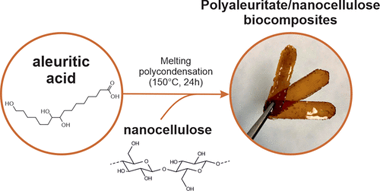
Free-standing and flexible biocomposite films formed by a polyaleuritate matrix and nanocellulose fillers (i.e., cellulose nanofibrils) have been fabricated by a sustainable process. For this, 9,10,16-trihydroxyhexadecanoic (aleuritic) acid from shellac and nanocellulose were blended at different ratios in water through a sonication process. Polymerization of the polyhydroxylated fatty acid into polyaleuritate was induced by a solvent-free, melting polycondensation reaction in the oven. These biocomposites were characterized to evaluate their chemical (by ATR-FTIR spectroscopy) and physical (e.g., density, thermal stability, rigidity, gas permeability, surface energy, etc.) properties. The compatibility between the polyester matrix and the polysaccharide fillers was excellent due to the interaction by H bonds of the polar groups of both components. The addition of nanocellulose increased all determined mechanical parameters as well as the wettability and the barrier properties, while the thermal stability and the water uptake were determined by the polyaleuritate matrix. The physical properties of these biocomposites were compared to those of petroleum-based plastics and bio-based polymers, indicating that the developed materials can represent a sustainable alternative for different applications such as packaging.
July, 2020 | DOI: 10.1021/acssuschemeng.0c00909
Materiales de Diseño para la Energía y Medioambiente
New biomorphic filters to face upcoming particulate emissions policies: A review of the FIL-BIO-DIESEL project
Orihuela, MP; Chacartegui, R; Martinez-Fernandez, JEnergy, 201 (2020) 117577
Show abstract ▽
With a high number of diesel vehicles worldwide, particulate emission control is an urgent issue with a global impact, from the health of citizens to commercial future of this technology in some transport segments. Particulate filters are widely used in automotive engines to comply emissions regulations, but current technologies have room for improvement as they add additional backpressure in the exhaust system, and efficient on-board regeneration process is challenging.
The Fil-Bio-Diesel Project is a R&D initiative to improve current particle filtration systems, based on the development of novel biomorphic substrates. By replicating the biologic tissue of a wood precursor, a biomorphic silicon carbide with hierarchic orthotropic microstructure can be produced. The porosity, the pore size, and pore orientation of this bioceramic material can be tailored through the selection of a suitable precursor, widening the initially narrow relationship between filtration efficiency and pressure drop that characterizes granular ceramic materials. In this paper the methodology and main results of the Fil-Bio-Diesel Project are presented. This work shows the peculiar advantages of biomorphic silicon carbide through several experimental studies. The results show the potential of this novel filter substrate to be used in future particulate abatement systems.
June, 2020 | DOI: 10.1016/j.energy.2020.117577
Materiales de Diseño para la Energía y Medioambiente
Bio-Based Coatings for Food Metal Packaging Inspired in Biopolyester Plant Cutin
Benitez, JJ; Osbild, S; Guzman-Puyol, S; Heredia, A; Heredia-Guerrero, JAPolymers, 12 (2020) 942
Show abstract ▽
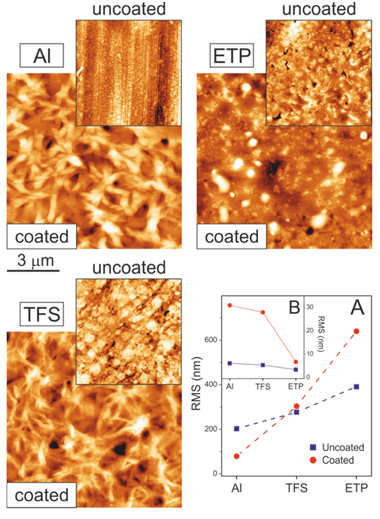
Metals used for food canning such as aluminum (Al), chromium-coated tin-free steel (TFS) and electrochemically tin-plated steel (ETP) were coated with a 2-3-mu m-thick layer of polyaleuritate, the polyester resulting from the self-esterification of naturally-occurring 9,10,16-trihydroxyhexadecanoic (aleuritic) acid. The kinetic of the esterification was studied by FTIR spectroscopy; additionally, the catalytic activity of the surface layer of chromium oxide on TFS and, in particular, of tin oxide on ETP, was established. The texture, gloss and wettability of coatings were characterized by AFM, UV-Vis total reflectance and static water contact angle (WCA) measurements. The resistance of the coatings to solvents was also determined and related to the fraction of unreacted polyhydroxyacid. The occurrence of an oxidative diol cleavage reaction upon preparation in air induced a structural modification of the polyaleuritate layer and conferred upon it thermal stability and resistance to solvents. The promoting effect of the tin oxide layer in such an oxidative cleavage process fosters the potential of this methodology for the design of effective long-chain polyhydroxyester coatings on ETP.
April, 2020 | DOI: 10.3390/polym12040942
Materiales de Diseño para la Energía y Medioambiente
Vegetable hierarchical structures as template for bone regeneration: New bio‐ceramization process for the development of a bone scaffold applied to an experimental sheep model
Filardo, G; Roffi, A; Fey, T; Fini, M; Giavaresi, G; Marcacci, M; Martinez-Fernandez, J; Martini, L; Ramirez-Rico, J; Salamanna, F; Sandri, M; Sprio, S; Tampieri, A; Kon, EJournal of Biomedical Materials Research Part B-Applied Materials, 108 (2020) 600-611
Show abstract ▽
Long bone defects still represent a major clinical challenge in orthopedics, with the inherent loss of function considerably impairing the quality of life of the affected patients. Thus, the purpose of this study was to assess the safety and potential of bone regeneration offered by a load‐bearing scaffold characterized by unique hierarchical architecture and high strength, with active surface facilitating new bone penetration and osseointegration in critical size bone defects. The results of this study showed the potential of bio‐ceramization processes applied to vegetable hierarchical structures for the production of new wood‐derived bone scaffolds, further improved by surface functionalization, with good biological and mechanical properties leading to successful treatment of critical size bone defects in the sheep model. Future studies are needed to evaluate if these scaffolds prototypes, as either biomaterial alone or in combination with augmentation strategies, may represent an optimal solution to enhance bone regeneration in humans.
April, 2020 | DOI: 10.1002/jbm.b.34414
Materiales de Diseño para la Energía y Medioambiente
An insight on the design of mercapto functionalized swelling brittle micas
Osuna, FJ; Pavon, E; Alba, MDJournal of Colloid and Interface Science, 561 (2020) 533-541
Show abstract ▽
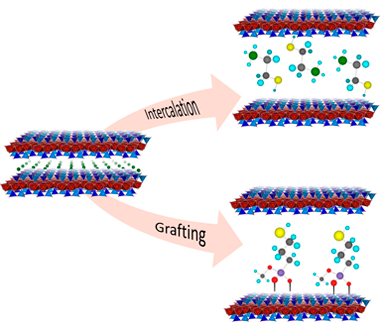
Surface modification of natural clay minerals with reagents containing metal chelating groups has great environmental value. The functionalization by adsorption or grafting guarantees a durable immobilization of the reactive organic groups, preventing their leaching when they are used in liquid media. The aim of this research was the designed mercapto functionalization of swelling brittle micas, Na-Mn, thorough both chemical and physical mechanisms. Na-Mn were functionalized with 2-mercaptoethylammonium (MEA), 2,3-dimercapto-1-propanol (BAL) and (3-mercaptopropyl)trimethoxysilane (MPTMS). The thiol concentration on swelling brittle micas is higher than the observed value for others adsorbents. The cation exchange reaction with MEA and one-step grafting with MPTMS in acid medium are the most efficient mercapto functionalization mechanism.
March, 2020 | DOI: 10.1016/j.jcis.2019.11.028
Materiales de Diseño para la Energía y Medioambiente
Binder-free supercapacitor electrodes: Optimization of monolithic graphitized carbons by reflux acid treatment
Gomez-Martin, A; Gutierrez-Pardo, A; Martinez-Fernandez, J; Ramirez-Rico, JFuel Processing Technology, 199 (2020) 106279
Show abstract ▽
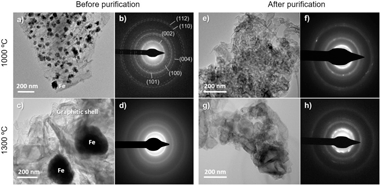
The rational design of electrodes mimicking the cellular structure of natural bio-resources has been a matter of increasing interest for applications in energy storage. Due to their anisotropic and hierarchical porosity, monolithic carbon materials from natural wood precursors are appealing as electrodes for supercapacitor applications due to their interconnected channels, relatively low cost and environmentally friendly synthesis process. In this work, a liquid-phase oxidative treatment with refluxing nitric acid at 100 degrees C for 8 h was performed to enhance the surface properties of beech-derived graphitized carbons treated with an iron catalyst. Microstructural, textural and surface investigations revealed that this strategy was successful in removing amorphous carbon and in functionalizing their surfaces. The crystallinity, accessible surface area, micropore volume and surface functionality of beech-derived carbons were increased upon the reflux treatment. The resulting porous carbon materials were evaluated as binderless monolithic electrodes for supercapacitors applications in aqueous KOH electrolyte. A maximum specific capacitance of 179 F.g(-1) and a volumetric capacitance of 89 Fcm(-3) in galvanostatic charge/discharge experiments were reached. Monolithic electrodes exhibited good cycling stability, with a capacitance retention over 95% after 10,000 cycles.
March, 2020 | DOI: 10.1016/j.fuproc.2019.106279
Materiales de Diseño para la Energía y Medioambiente
Preparation and Characterization of Bio-Based PLA/PBAT and Cinnamon Essential Oil Polymer Fibers and Life-Cycle Assessment from Hydrolytic Degradation
Correa-Pacheco, ZN; Black-Solis, JD; Ortega-Gudino, P; Sabino-Gutierrez, MA; Benitez-Jimenez, JJ; Barajas-Cervantes, A; Bautista-Banos, S; Hurtado-Colmenares, LBPolymers, 12 (2020) 38
Show abstract ▽
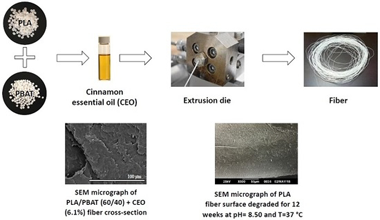
Nowadays, the need to reduce the dependence on fuel products and to achieve a sustainable development is of special importance due to environmental concerns. Therefore, new alternatives must be sought. In this work, extruded fibers from poly (lactic acid) (PLA) and poly (butylene adipate-co-terephthalate) (PBAT) added with cinnamon essential oil (CEO) were prepared and characterized, and the hydrolytic degradation was assessed. A two-phase system was observed with spherical particles of PBAT embedded in the PLA matrix. The thermal analysis showed partial miscibility between PLA and PBAT. Mechanically, Young's modulus decreased and the elongation at break increased with the incorporation of PBAT and CEO into the blends. The variation in weight loss for the fibers was below 5% during the period of hydrolytic degradation studied with the most important changes at 37 degrees C and pH 8.50. From microscopy, the formation of cracks in the fiber surface was evidenced, especially for PLA fibers in alkaline medium at 37 degrees C. This study shows the importance of the variables that influence the performance of polyester-cinnamon essential oil-based fibers in agro-industrial applications for horticultural product preservation.
January, 2020 | DOI: 10.3390/polym12010038
2019
2019
Materiales de Diseño para la Energía y Medioambiente
Understanding segregation processes in SAMs formed by mixtures of hydroxylated and non-hydroxylated fatty acids
Bueno, OVM; Benitez, JJ; San-Miguel, MARSC Advances, 9 (2019) 39252-39263
Show abstract ▽
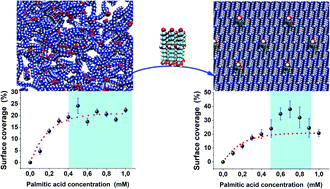
In this paper, we focus on the segregation processes emerging when preparing mixtures with different compositions of aleuritic (9,10,16 trihydroxyhexadecanoic) (ALE) and palmitic (hexadecanoic) (PAL) acids. The combination of atomic force microscopy (AFM) and molecular dynamics (MD) simulations enabled us to prove the role of the functional groups in the formation of self-assembled monolayers (SAMs) on muscovite mica surfaces. MD simulations indicate that segregation processes are favored in high ALE composition mixtures in agreement with the experimental evidence, whereas low ALE compositions promote the co-existence between segregated and dispersed systems. The secondary hydroxyl groups play a central role in the self-assembling mechanism because they control the formation of hydrogen bonding networks guarantying system stability.
December, 2019 | DOI: 10.1039/c9ra06799j
Materiales de Diseño para la Energía y Medioambiente
Porous Graphene-like Carbon from Fast Catalytic Decomposition of Biomass for Energy Storage Applications
Gomez-Martin, A; Martinez-Fernandez, J; Ruttert, M; Winter, M; Placke, T; Ramirez-Rico, JACS Omega, 4 (2019) 21446-21458
Show abstract ▽
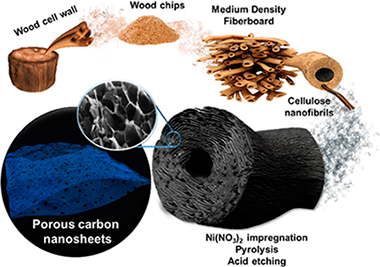
A novel carbon material made of porous graphene-like nanosheets was synthesized from biomass resources by a simple catalytic graphitization process using nickel as a catalyst for applications in electrodes for energy storage devices. A recycled fiberboard precursor was impregnated with saturated nickel nitrate followed by high-temperature pyrolysis. The highly exothermic combustion of in situ formed nitrocellulose produces the expansion of the cellulose fibers and the reorganization of the carbon structure into a three-dimensional (3D) porous assembly of thin carbon nanosheets. After acid washing, nickel particles are fully removed, leaving nanosized holes in the wrinkled graphene-like sheets. These nanoholes confer the resulting carbon material with approximate to 75% capacitance retention, when applied as a supercapacitor electrode in aqueous media at a specific current of 100 A.g(-1) compared to the capacitance reached at 20 mA.g(-1), and approximate to 35% capacity retention, when applied as a negative electrode for lithium-ion battery cells at a specific current of 3720 mA.g(-1) compared to the specific capacity at 37.2 mA.g(-1). These findings suggest a novel way for synthesizing 3D nanocarbon networks from a cellulosic precursor requiring low temperatures and being amenable to large-scale production while using a sustainable starting precursor such as recycled fiberwood.
December, 2019 | DOI: 10.1021/acsomega.9b03142
Materiales de Diseño para la Energía y Medioambiente
Design swelling micas: Insights on heavy metals cation exchange reaction
Osuna, FJ; Pavon, E; Alba, MDApplied Clay Science, 182 (2019) 105298
Show abstract ▽
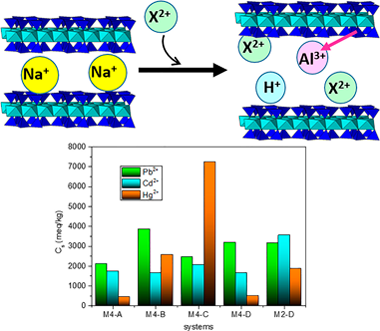
Heavy metal pollution has become one of the most serious environmental problems, demanding specialized remediation mechanisms. Among the studied treatments, ion-exchange processes have been widely used due to their high remediation capacity, efficiency and fast kinetic. Here, the potential use of a new family of design micas as cation exchanger has been analysed. Micas with a layer charge in the range of brittle micas have been synthesized and their heavy metals cation exchange capacity analysed as a function of the nature of the heavy metal cations (Pb2+, Cd2+ or Hg2+), the nature of the counterions (Cl− or NO3−), concentration of the solutions and the micas layer charge. A cation exchange ratio between 35% and 154% of their cation exchange capacity (CEC) was achieved, being more efficient when mica layer charge diminished. In general, the maximum adsorption capacity followed the trend: Hg2+ > Pb2+ > Cd2+. The efficiency of the cation exchange and adsorption mechanism of the synthetic micas depended on the experimental conditions and they were more efficient than raw and modified natural clay minerals.
December, 2019 | DOI: 10.1016/j.clay.2019.105298
Materiales de Diseño para la Energía y Medioambiente
Applications and potentialities of Atomic Force Microscopy in fossil and extant plant cuticle characterization
Benitez, JJ; Guzman-Puyol, S; Dominguez, E; Heredia, A; Heredia-Guerrero, JAReview of Palaeobotany and Palynology, 268 (2019) 125-132
Show abstract ▽
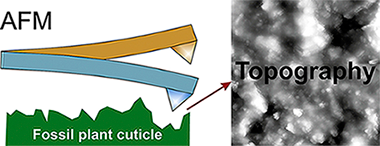
Atomic Force Microscopy (AFM) is a versatile technique of surface characterization, providing accurate information about the topography and other wide variety of magnitudes at submicron scale. It is extensively utilized in materials science, but its use in other disciplines such as paleobotany is infrequent. In this review, we introduce the main concepts of AFM to paleobotanists, comparing the characteristics of this technique to common electronic and optical microscopies. Then, main works with extant plants, in particular plant cuticles, are described. Finally, realistic applications with fossils are reviewed and their potential use in the characterization of plant fossils discussed. AFM is proposed as a complementary technique to common microscopies to characterize plant cuticle fine details at nanoscale.
September, 2019 | DOI: 10.1016/j.revpalbo.2019.06.015
Materiales de Diseño para la Energía y Medioambiente
Insoluble and Thermostable Polyhydroxyesters From a Renewable Natural Occurring Polyhydroxylated Fatty Acid
Benitez, JJ; Guzman-Puyol, S; Cruz-Carrillo, MA; Ceseracciu, L; Moreno, AG; Heredia, A; Heredia-Guerrero, JAFrontiers in Chemistry, 7 (2019) art. 643
Show abstract ▽
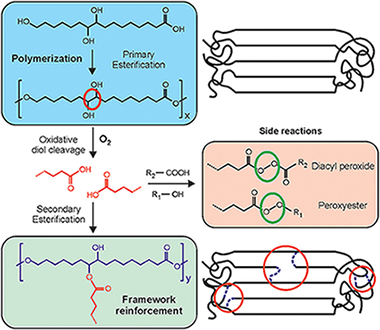
To explore the potential of long chain polyhydroxyalkanoates as non-toxic food packaging materials, the characterization of polyesters prepared from a natural occurring polyhydroxylated C16 carboxylic acid (9,10,16-trihydroxyhexadecanoic or aleuritic acid) has been addressed. Such monomer has been selected to elucidate the reactivity of primary and secondary hydroxyl groups and their contribution to the structure and properties of the polyester. Resulting polyaleuritate films have been produced using an open mold in one-step, solvent-free self-polycondensation in melt state and directly in air to evaluate the effect of oxygen in their final physical and chemical properties. These polymers are amorphous, insoluble, and thermostable, being therefore suitable for solvent, and heat resistant barrier materials. Structurally, most of primary hydroxyls are involved in ester bonds, but there is some branching arising from the partial participation of secondary O-H groups. The oxidative cleavage of the vicinal diol moiety and a subsequent secondary esterification had a noticeable effect on the amorphization and stiffening of the polyester by branching and densification of the ester bond network. A derivation of such structural modification was the surface compaction and the reduction of permeability to water molecules. The addition of Ti(OiPr)(4) as a catalyst had a moderate effect, likely because of a poor diffusion within the melt, but noticeably accelerated both the secondary esterification and the oxidative processes. Primary esterification was a high conversion bulk reaction while oxidation and secondary esterification was restricted to nearby regions of the air exposed side of cast films. The reason was a progressive hindering of oxygen diffusion as the reaction progresses and a self-regulation of the altered layer growth. Despite such a reduced extent, the oxidized layer noticeably increased the UV-vis light blockage capacity. In general, characterized physical properties suggest a high potential of these polyaleuritate polyesters as food preserving materials.
September, 2019 | DOI: 10.3389/fchem.2019.00643
Materiales de Diseño para la Energía y Medioambiente
Correlation of Structure and Performance of Hard Carbons as Anodes for Sodium Ion Batteries
Gomez-Martin, A; Martinez-Fernandez, J; Ruttert, M; Winter, M; Placke, T; Ramirez-Rico, JChemistry of Materials, 31 (2019) 7288-7299
Show abstract ▽
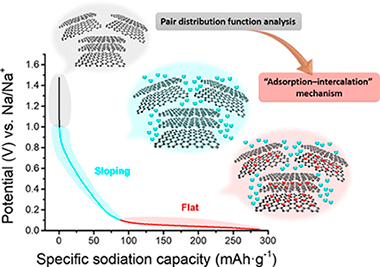
Hard carbons are the material of choice as negative electrode in sodium ion batteries. Despite being extensively studied, there is still debate regarding the mechanisms responsible for storage in low- and high-potential regions. This work presents a comprehensive approach to elucidate the involved storage mechanisms when Na ions insert into such disordered structures. Synchrotron X-ray total scattering experiments were performed to access quantitative information on atomic ordering in these materials at the nanoscale. Results prove that hard carbons undergo an atomic rearrangement as the graphene layers cross-link at intermediate temperatures (1200-1600 degrees C), resulting in an increase of the average interplanar distance up to 1400 degrees C, followed by a progressive decrease. This increase correlates with the positive trend in the reversible capacity of biomass-derived carbons when processed up to 1200-1600 degrees C due to an increased capacity at low potential (<= 0.1 V vs Na/Na+). A decrease in achievable sloping capacity with increasing heat-treatment temperature arises from larger crystalline domains and a lower concentration of defects. The observed correlation between structural parameters and electrochemical properties clearly supports that the main storage of Na ions into a hard-carbon structure is based on an adsorption-intercalation mechanism.
September, 2019 | DOI: 10.1021/acs.chemmater.9b01768
Materiales de Diseño para la Energía y Medioambiente
Bio-based composite fibers from pine essential oil and PLA/PBAT polymer blend. Morphological, physicochemical, thermal and mechanical characterization
Hernandez-Lopez, M; Correa-Pacheco, ZN; Bautista-Banos, S; Zavaleta-Avejar, L; Benitez-Jimenez, JJ; Sabino-Gutierrez, MA; Ortega-Gudino, PMaterials Chemistry and Physics, 234 (2019) 345-353
Show abstract ▽
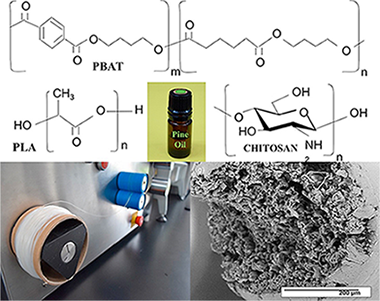
Biodegradable aliphatic polyesters are an alternative to reduce the use of synthetic plastic materials that cause severe damage to the environment. Formulations based on poly (lactic acid) (PLA) and poly (butylene adipate-co-terephthalate) (PBAT), were mixed in a 60:40 ratio, adding different concentrations of pine essential oil through the use of extrusion technology to obtain biodegradable polymer fibers. Some formulations were coated with chitosan. All the elaborated fibers were characterized by Scanning Electron Microscopy (SEM), Fourier Transform Infrared Spectroscopy-Attenuated Total Reflection (FTIR-ATR), Differential Scanning Calorimetry (DSC), X-ray Diffraction (XRD) and mechanical properties. The SEM studies showed that the PBAT improves the tenacity and provides greater elasticity promoting the interaction between the blends phases with fibril formation. In the FTIR-ATR analysis, compatibility between the blends was observed due to a possible interaction of the carbonyl group of PBAT with PLA. The DSC and the mechanical properties showed partial miscibility of the blends, indicating, that the plasticizing action of the essential oil gave greater mobility, flexibility, less rigidity and crystallization in the blends. A lower Young's modulus and greater elongation at break was also observed.
August, 2019 | DOI: 10.1016/j.matchemphys.2019.01.034
Materiales de Diseño para la Energía y Medioambiente
Natural abundance O-17 MAS NMR and DFT simulations: New insights into the atomic structure of designed micas
Pavon, E; Osuna, FJ; Alba, MD; Delevoye, LSolid State Nuclear Magnetic Resonance, 100 (2019) 45-51
Show abstract ▽
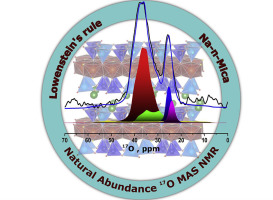
Combining O-17 Magic-Angle Spinning (MAS) NMR at natural abundance with DFT calculations is a promising methodology to shed light on the structure and disorder in tetrahedral sheets of designed micas with enhanced properties. Among brittle micas, synthetic mica is an important alternative to natural ones with a swelling sheet-like structure that results in many applications, by exploiting unique characteristics. Lowenstein's rule is one of the main chemical factor that determines the atomic structure of aluminosilicates and furthermore their properties. In the present article, O-17 MAS NMR spectroscopy is used to validate (or not) the agreement of the Lowenstein's rule with the distribution of Si and Al sites in the tetrahedral sheets of synthetic micas. O-17 MAS spectra of synthetic high-charged micas exhibit two regions of signals that revealed two distinguishable oxygen environments, namely Si-O-X (with X = Si, Al-tet , Mg) and Al-tet -O-Y (Y=Mg or Al-tet). DFT calculations were also conducted to obtain the O-17 chemical shift and other NMR features like the quadrupolar coupling constant, C-Q, for all of the oxygen environments encountered in the two model structures, one respecting the Lowenstein's rule and the other involving Al-tet -O-Al-tet and Si-O-Si environments. Our DFT calculations support the O-17 assignment, by confirming that Al-tet -O-3Mg and Al tet -O-Al tet oxygen environments show chemical shifts under 30 ppm and more important, with quadrupolar coupling constants of about 1 MHz, in line with the spectral observation. By quantifying the O-17 MAS NMR spectra at natural abundance, we demonstrate that one of the synthetic mica compositions does not meet the Lowenstein's rule.
August, 2019 | DOI: 10.1016/j.ssnmr.2019.03.006
Materiales de Diseño para la Energía y Medioambiente
Bionanocomposites based on chitosan intercalation in designed swelling high-charged micas
Alba, MD; Cota, A; Osuna, FJ; Pavon, E; Perdigon, AC; Raffin, FScientific Reports, 9 (2019) art. 10265
Show abstract ▽
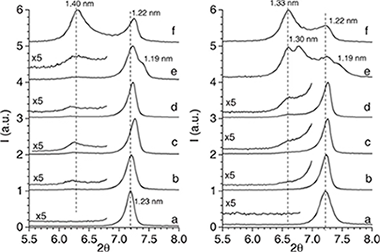
Bionanocomposites based on layered inorganic components, as clays, and polymers of biological origin, as chitosan, have a major impact in medical and environmental fields, being economical and environmentally friendly materials. Na-Mn micas (n = 2 and 4) with controlled surface charge, high cation exchange capacity and swelling behaviour, are attractive inorganic composite components that exhibit improved adsorption properties compared to other inorganic solids which makes them potentially useful for bionanocomposites. The goal of this research was to explore the potential use of those synthetic brittle micas to form eco-friendly bionanocomposites with chitosan biopolymer. Hence, chitosan-mica bionanocomposites were prepared by ion-exchange reaction between chitosan solution and synthetic high charge mica. X-ray diffraction, Fourier transform infrared spectroscopy, thermal analysis, MAS-NMR spectroscopy and zeta-potential have been employed for bionanocomposites characterization. The results showed that the adsorption of chitosan is effective, although a chitosan portion remains in the outer surface being hydrogen-bonded to the tetrahedral sheet of the silicate.
July, 2019 | DOI: 10.1038/s41598-019-46495-z
Materiales de Diseño para la Energía y Medioambiente
Low molecular weight epsilon-caprolactone-p-coumaric acid copolymers as potential biomaterials for skin regeneration applications
Contardi, M; Alfaro-Pulido, A; Picone, P; Guzman-Puyol, S; Goldoni, L; Benitez, J; Heredia, A; Barthel, MJ; Ceseracciu, L; Cusimano, G; Brancato, OR; Di Carlo, M; Athanassiou, A; Heredia-Guerrero, JAPLoS One, 14 (2019) e0214956
Show abstract ▽
epsilon-caprolactone-p-coumaric acid copolymers at different mole ratios (epsilon-caprolactone: p-coumaric acid 1:0, 10:1, 8:1, 6:1, 4:1, and 2:1) were synthesized by melt-polycondensation and using 4-dodecylbenzene sulfonic acid as catalyst. Chemical analysis by NMR and GPC showed that copolyesters were formed with decreasing molecular weight as p-coumaric acid content was increased. Physical characteristics, such as thermal and mechanical properties, as well as water uptake and water permeability, depended on the mole fraction of p-coumaric acid. The p-coumarate repetitive units increased the antioxidant capacity of the copolymers, showing antibacterial activity against the common pathogen Escherichia coli. In addition, all the synthesized copolyesters, except the one with the highest concentration of the phenolic acid, were cytocompatible and hemocompatible, thus becoming potentially useful for skin regeneration applications.
April, 2019 | DOI: 10.1371/journal.pone.0214956
Materiales de Diseño para la Energía y Medioambiente
Sustainable polycondensation of multifunctional fatty acids from tomato pomace agro-waste catalyzed by tin (II) 2-ethylhexanoate
J.A. Heredia-Guerrero, G. Caputo, S. Guzmán-Puyol, G. Tedeschi, A. Heredia, L. Ceseracciu, J.J. Benítez, A. AthanassiouMaterials Today Sustainability, 3-4 (2019) 100004
Show abstract ▽
Bioplastics were prepared from the fatty fraction (i.e., unsaturated and polyhydroxylated fatty acids) of tomato pomace agro-wastes. Aliphatic polyesters were synthesized at different temperatures (125, 150, and 175 °C), reaction times (0.25, 0.5, 0.75, 1, 3, 5, and 7 h), and amounts of tin (II) 2-ethylhexanoate (0, 0.02, 0.05, and 0.10 mmol) used as a catalyst. The rate constants and activation energies were calculated from infrared spectra. The right combination of reaction temperature and amount of catalyst improved the reaction kinetics (apparent k from ∼1 to ∼8.5 h−1), whereas the activation energy was reduced from ∼39 without catalyst to ∼28 kJ/mol when tin (II) 2-ethylhexanoate was present. Glass transitions between ca. −25 and ∼0 °C were measured by differential scanning calorimetry, strictly depending on the degree of polymerization. The amorphous character of the samples was confirmed by X-ray diffraction. Young's modulus and hardness were calculated from indentation tests and were typical of soft materials, although increased as the polycondensation reaction progressed. High water-contact angles (maximum value ∼109°) and low water uptakes (minimum value ∼2.1%) were determined. Physical properties were compared with those of common man-made plastics and polymers, finding that these tomato pomace bioplastics could be their realistic alternatives.
March, 2019 | DOI: 10.1016/j.mtsust.2018.12.001
Materiales de Diseño para la Energía y Medioambiente
Combining dietary phenolic antioxidants with polyvinylpyrrolidone: transparent biopolymer films based on p-coumaric acid for controlled release
Contardi, M; Heredia-Guerrero, JA; Guzman-Puyol, S; Summa, M; Benitez, JJ; Goldoni, L; Caputo, G; Cusimano, G; Picone, P; Di Carlo, M; Bertorelli, R; Athanassioua, A; Bayer, ISJournal of Materials Chemistry B, 7 (2019) 1384-1396
Show abstract ▽
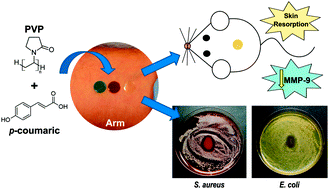
Polyvinylpyrrolidone (PVP) has probably been one of the most utilized pharmaceutical polymers with applications ranging from a blood plasma substitute to nanoparticle drug delivery, since its synthesis in 1939. It is a highly biocompatible, non-toxic and transparent film forming polymer. Although high solubility of PVP in aqueous environment is advantageous, it still poses several problems for some applications in which sustained targeting and release are needed or hydrophobic drug inclusion and delivery systems are to be designed. In this study, we demonstrate that a common dietary phenolic antioxidant, p-coumaric acid (PCA), can be combined with PVP covering a wide range of molar ratios by solution blending in ethanol, forming new transparent biomaterial films with antiseptic and antioxidant properties. PCA not only acts as an effective natural plasticizer but also establishes H-bonds with PVP increasing its resistance to water dissolution. PCA could be released in a sustained manner up to a period of 3 days depending on the PVP/ PCA molar ratio. Sustained drug delivery potential of the films was studied using methylene blue and carminic acid as model drugs, indicating that the release can be controlled. Antioxidant and remodeling properties of the films were evaluated in vitro by free radical cation scavenging assay and in vivo on a murine model, respectively. Furthermore, the material resorption of films was slower as PCA concentration increased, as observed from the in vivo full-thickness excision model. Finally, the antibacterial activity of the films against common pathogens such as Escherichia coli and Staphylococcus aureus and the effective reduction of inflammatory agents such as matrix metallopeptidases were demonstrated. All these properties suggest that these new transparent PVP/ PCA films can find a plethora of applications in pharmaceutical sciences including skin and wound care.
March, 2019 | DOI: 10.1039/c8tb03017k
Materiales de Diseño para la Energía y Medioambiente
Transparent and Robust All-Cellulose Nanocomposite Packaging Materials Prepared in a Mixture of Trifluoroacetic Acid and Trifluoroacetic Anhydride
Guzman-Puyol, S; Ceseracciu, L; Tedeschi, G; Marras, S; Scarpellini, A; Benitez, JJ; Athanassiou, A; Heredia-Guerrero, JANanomaterials, 9 (2019) 368
Show abstract ▽
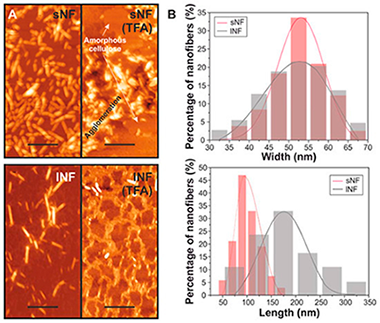
All-cellulose composites with a potential application as food packaging films were prepared by dissolving microcrystalline cellulose in a mixture of trifluoroacetic acid and trifluoroacetic anhydride, adding cellulose nanofibers, and evaporating the solvents. First, the effect of the solvents on the morphology, structure, and thermal properties of the nanofibers was evaluated by atomic force microscopy (AFM), X-ray diffraction (XRD), and thermogravimetric analysis (TGA), respectively. An important reduction in the crystallinity was observed. Then, the optical, morphological, mechanical, and water barrier properties of the nanocomposites were determined. In general, the final properties of the composites depended on the nanocellulose content. Thus, although the transparency decreased with the amount of cellulose nanofibers due to increased light scattering, normalized transmittance values were higher than 80% in all the cases. On the other hand, the best mechanical properties were achieved for concentrations of nanofibers between 5 and 9 wt.%. At higher concentrations, the cellulose nanofibers aggregated and/or folded, decreasing the mechanical parameters as confirmed analytically by modeling of the composite Young's modulus. Finally, regarding the water barrier properties, water uptake was not affected by the presence of cellulose nanofibers while water permeability was reduced because of the higher tortuosity induced by the nanocelluloses. In view of such properties, these materials are suggested as food packaging films.
March, 2019 | DOI: 10.3390/nano9030368
Materiales de Diseño para la Energía y Medioambiente
Eu3+ Luminescence in High Charge Mica: An In Situ Probe for the Encapsulation of Radioactive Waste in Geological Repositories
Martin-Rodriguez, R; Aguado, F; Alba, MD; Valiente, R; Perdigon, ACACS Applied Materials & Interfaces, 11 (4) (2019) 7559-7565
Show abstract ▽
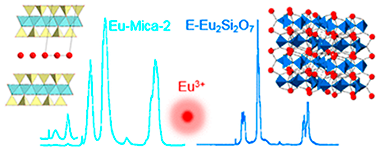
Isolation of high-level radioactive waste (HLW) in deep geological repositories (DGR) through a multibarrier concept is the most accepted approach to ensure long-term safety. Clay minerals are one of the most promising materials to be used as engineered barriers. In particular, high charge micas, as components of the engineered barrier, show superselectivity for some radioactive isotopes and a large adsorption capacity, which is almost twice that of the other low charge aluminosilicates. In addition, high charge micas are optimum candidates for decontamination of nuclear waste through two different mechanisms; namely an ion exchange reaction and a nonreversible mechanism involving the formation of new stable crystalline phases under hydrothermal conditions. In this work, we report a new in situ optical sensor based on the incorporation of Eu3+ in these high charge micas for tracking the long-term physical-chemical behavior of HLW contaminants in DRG under mild hydrothermal conditions. The incorporation of Eu3+ into the interlayer space of the mica originates a well resolved green and red luminescence, from both the 5D1 and 5D0 excited states, respectively. The formation of new crystalline phases under hydrothermal conditions involves important changes in the Eu3+ emission spectra and lifetime. The most interesting features of Eu3+ luminescence to be used as an optical sensor are (1) the presence or absence of the Eu3+ green emission from the 5D1 excited state, (2) the energy shift of the 5D0 → 7F0 transition, (3) the crystal-field splitting of the 7F1 Eu3+ level, and (4) the observed luminescence lifetimes, which are directly related to the interaction mechanisms between the lanthanide ions and the silicate network.
February, 2019 | DOI: 10.1021/acsami.8b20030
Materiales de Diseño para la Energía y Medioambiente
Influence of framework and interlayer on the colloidal stability of design swelling high-charged micas
Osuna, FJ; Cota, A; Fernandez, MA; Pavon, E; Sanchez, RMT; Alba, MDColloids and Surfaces A: Physicochemical and Engineering Aspects, 561 (2019) 32-38
Show abstract ▽
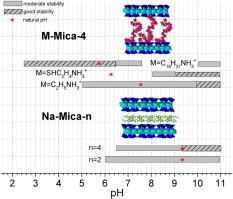
Stability of colloidal clay minerals dispersion of fundamental in many industrial processes. Therefore, surface charge of the synthetic swelling high-charged mica family, Na-Mica-n (n = 2 or 4, n is the total layer charge) were investigated to study its colloidal dispersion stability as a function of the framework and interlayer space composition. Na-Mica-n (n = 2 or 4) micas were synthesized and functionalized with ethylammonium, mercaptoethylammonium or octadecylammonium. Their zeta-potential evolutions as a function of solution pH were correlated with their structural, compositional and morphological characteristics. The results have shown that the total charge of swelling high charged micas, Mica-n, didn´t affect significantly their colloidal dispersion stability, the interlayer composition and interlayer cation arrangement were the main factors of colloidal behaviour. The synthesis and functionalization of those synthetic micas can be tuned for their optimal use.
January, 2019 | DOI: 10.1016/j.colsurfa.2018.09.086
2018
2018
Materiales de Diseño para la Energía y Medioambiente
Behavior of High-Strength Polypropylene Fiber-Reinforced Self-Compacting Concrete Exposed to High Temperatures
Rios, JD; Cifuentes, H; Leiva, C; Garcia, C; Alba, MDJournal of Materials in Civil Engineering, 30 (2018) 04018271
Show abstract ▽
In this study we analyzed the use of high-performance structural concrete reinforced with polypropylene fibers in applications requiring long exposure times to high temperatures, such as thermal energy storage systems. We analyzed the behavior of the concrete at different temperatures (hot tests: 100 degrees C, 300 degrees C, 500 degrees C and 700 degrees C), cooled-down states (cold tests) and exposure times (6, 24, and 48h). We also experimentally determined the thermogravimetric analysis, fracture behavior, compressive strength, Young's modulus, and tensile strength of concrete. Subsequently, we performed a comprehensive analysis of the thermal and mechanical behavior of high-performance concrete under different thermal conditions. We applied longer exposure times to broaden the available results on the behavior of high-performance fiber-reinforced concrete when subjected to high temperatures. Results show that, once thermal and moisture equilibriums are reached, exposure time does not have any influence on mechanical properties. They also provide useful information about the influence of high temperatures on the different parameters of fiber-reinforced concrete and its application for thermal energy storage structures.
November, 2018 | DOI: 10.1061/(ASCE)MT.1943-5533.0002491
Materiales de Diseño para la Energía y Medioambiente
Environmentally friendly monolithic highly-porous biocarbons as binder-free supercapacitor electrodes
Orlova, TS; Shpeizman, VV; Glebova, NV; Nechitailov, AA; Spitsyn, AA; Ponomarev, DA; Gutierrez-Pardo, A; Ramirez-Rico, JReviews on Advanced Materials Science, 55 (2018) 50-60
Show abstract ▽
A simple, low-cost and environmentally friendly method has been used to obtain highly porous biomorphic carbon monoliths with a good combination of interconnected macro-, meso- and microporosity, and good electrical conductivity and mechanical strength, making these biocarbon materials interesting for electrochemical applications as binder-free electrodes. Highly porous monolithic biocarbons were obtained from beech wood precursors through pyrolysis and subsequent surface modification in a steam heated to 970 degrees C with different activation times. The obtained biocarbons demonstrated good electrical conductivity and mechanical strength. They were studied as electrodes for supercapacitors in half cell experiments, demonstrating maximum gravimetric capacitance of 200 F g(-1) in a basic media at scan rate 1 mV s(-1). Galvanostatic charge-discharge experiments showed maximum capacitance of 185 F g(-1) at current density of 0.15 A g(-1) and similar to 100 F g(-1) at current density of 0.75 A g(-1). It has been shown that in addition to the developed porous surface, the micropores with diameters exceeding 1 nm play a key role for the enhanced electrochemical capacity. Long-cycling experiments demonstrated excellent stability of the monolithic biocarbon electrodes with no reduction of the initial capacitance values after 600 cycles in voltammetry.
November, 2018 | DOI: 10.1515/rams-2018-0027
Materiales de Diseño para la Energía y Medioambiente
Sustainable Fabrication of Plant Cuticle-Like Packaging Films from Tomato Pomace Agro-Waste, Beeswax, and Alginate
Tedeschi, G; Benitez, JJ; Ceseracciu, L; Dastmalchi, K; Itin, B; Stark, RE; Heredia, A; Athanassiou, A; Heredia-Guerrero, JAACS Sustainable Chemistry & Engineering, 6 (2018) 14955-14966
Show abstract ▽
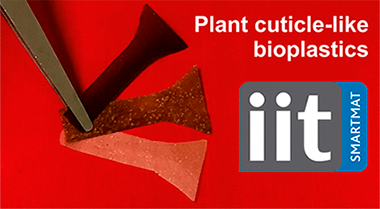
Plant cuticles have been used as models to produce hydrophobic films composed of sodium alginate, the fatty acid fraction of tomato pomace agrowaste, and beeswax. The fabrication process consisted of the blending of components in green solvents (water and ethanol) and a subsequent thermal treatment (150 degrees C, 8 h) to polymerize unsaturated and polyhydroxylated fatty acids from tomato pomace. When sodium alginate and tomato pomace fatty acids were blended, free-standing films were obtained. These films were characterized to evaluate their morphological (SEM), chemical (solid-state NMR, ATR-FTIR), mechanical (tensile tests), thermal (TGA), and hydrodynamic (water contact angle, uptake, and permeability) properties. A comparison between nonpolymerized and polymerized samples was carried out, revealing that the thermal treatment represents a sustainable route to create structured, composite networks of both components. Finally, beeswax was added to the blend with the same amounts of sodium alginate and tomato pomace fatty acids. The presence of the wax improved the hydrophobicity and the mechanical and water barrier properties as well as decreased the water uptake. These results indicate that polymerized plant cuticle-like films have valuable potential for packaging applications.
November, 2018 | DOI: 10.1021/acssuschemeng.8b03450
Materiales de Diseño para la Energía y Medioambiente
Valorization of Tomato Processing by-Products: Fatty Acid Extraction and Production of Bio-Based Materials
Benitez, JJ; Castillo, PM; del Rio, JC; Leon-Camacho, M; Dominguez, E; Heredia, A; Guzman-Puyol, S; Athanassiou, A; Heredia-Guerrero, JAMaterials, 11 (2018) art. 2211
Show abstract ▽
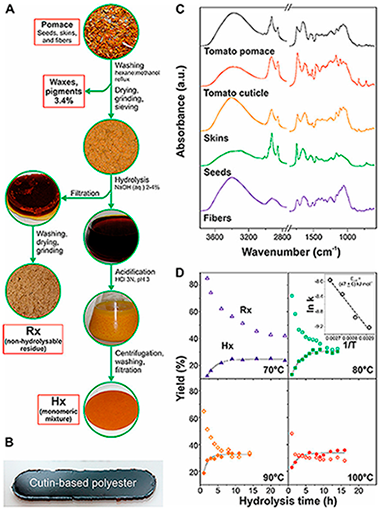
A method consisting of the alkaline hydrolysis of tomato pomace by-products has been optimized to obtain a mixture of unsaturated and polyhydroxylated fatty acids as well as a non-hydrolysable secondary residue. Reaction rates and the activation energy of the hydrolysis were calculated to reduce costs associated with chemicals and energy consumption. Lipid and non-hydrolysable fractions were chemically (infrared (IR) spectroscopy, gas chromatography/mass spectrometry (GC-MS)) and thermally (differential scanning calorimetry (DSC), thermogravimetric analysis (TGA)) characterized. In addition, the fatty acid mixture was used to produce cutin-based polyesters. Freestanding films were prepared by non-catalyzed melt-polycondensation and characterized by Attenuated Total Reflected-Fourier Transform Infrared (ATR-FTIR) spectroscopy, solid-state nuclear magnetic resonance (NMR), DSC, TGA, Water Contact Angles (WCA), and tensile tests. These bio-based polymers were hydrophobic, insoluble, infusible, and thermally stable, their physical properties being tunable by controlling the presence of unsaturated fatty acids and oxygen in the reaction. The participation of an oxidative crosslinking side reaction is proposed to be responsible for such modifications.
November, 2018 | DOI: 10.3390/ma11112211
Materiales de Diseño para la Energía y Medioambiente
Performance improvement in olive stone's combustion from a previous carbonization transformation
Gomez-Martin, A; Chacartegui, R; Ramirez-Rico, J; Martinez-Fernandez, JFuel, 228 (2018) 254-262
Show abstract ▽
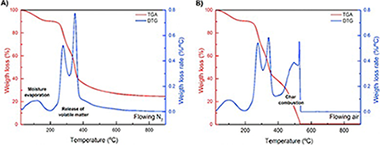
Under the framework of circular economy, agricultural wastes are an interesting carbon-based feedstock for thermal energy and power generation. Their use could extend the availability of biomass-based fuel and, at the same time, would reduce negative environmental effects. However, depending on the residues' characteristics, their direct combustion in boilers presents some challenges which could be overcome with a carbonization pretreatment. In this paper, the main mechanisms of thermochemical transformation of an abundant agricultural waste, olive stone, into biochar products via slow carbonization are analyzed, with emphasis on the effect of peak carbonization temperature. Thermogravimetric and differential scanning calorimetry analysis are used to evaluate the performance of the resulting biochars compared to raw olive stone in combustion processes and to assess the correlation between the peak carbonization temperature and compositional and fuel properties. Results show that with a prior treatment up to an optimum temperature of 800 degrees C the energy density is increased up to three times compared to the raw material. These findings suggest that carbonization of olive stones reduces the barriers to their direct use in current biomass boiler technology.
September, 2018 | DOI: 10.1016/j.fuel.2018.04.127
Materiales de Diseño para la Energía y Medioambiente
A comprehensive and in-depth analysis of the synthesis of advanced adsorbent materials
Osuna, FJ; Cota, A; Pavon, E; Alba, MDJournal of Cleaner Production, 194 (2018) 665-672
Show abstract ▽

Na-Mica-4, a synthetic fluorophlogopite, is an attractive adsorbent. However, the synthesis at large scale demands an economically prized, feasible scalable and sustainable synthesis method, which requires a deep knowledge of the influence of each synthesis step. A set of Na-Mica-4 were synthesized by methods that had one synthesis parameter as variable. The purity, crystallinity and heteroatoms distribution were analysed thorough X-ray diffraction and nuclear magnetic resonance. The results shed a light on the main factors for the design of the final product and indicated that an environmental friendship synthesis could be possible.
September, 2018 | DOI: 10.1016/j.jclepro.2018.05.179
Materiales de Diseño para la Energía y Medioambiente
Iron-Catalyzed Graphitic Carbon Materials from Biomass Resources as Anodes for Lithium-Ion Batteries
Gomez-Martin, A; Martinez-Fernandez, J; Ruttert, M; Heckmann, A; Winter, M; Placke, T; Ramirez-Rico, JChemsuschem, 11 (2018) 2776-2787
Show abstract ▽
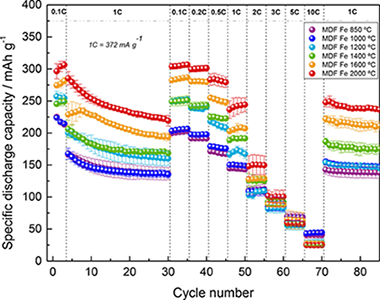
Graphitized carbon materials from biomass resources were successfully synthesized with an iron catalyst, and their electrochemical performance as anode materials for lithium-ion batteries (LIBs) was investigated. Peak pyrolysis temperatures between 850 and 2000 degrees C were covered to study the effect of crystallinity and microstructural parameters on the anodic behavior, with a focus on the first-cycle Coulombic efficiency, reversible specific capacity, and rate performance. In terms of capacity, results at the highest temperatures are comparable to those of commercially used synthetic graphite derived from a petroleum coke precursor at higher temperatures, and up to twice as much as that of uncatalyzed biomass-derived carbons. The opportunity to graphitize low-cost biomass resources at moderate temperatures through this one-step environmentally friendly process, and the positive effects on the specific capacity, make it interesting to develop more sustainable graphite-based anodes for LIBs.
August, 2018 | DOI: 10.1002/cssc.201800831
Materiales de Diseño para la Energía y Medioambiente
Comparison of solvent extraction and extraction chromatography resin techniques for uranium isotopic characterization in high-level radioactive waste and barrier materials
Hurtado-Bermudez, S; Villa-Alfageme, M; Mas, JL; Alba, MDApplied Radiation and Isotopes, 137 (2018) 177-183
Show abstract ▽
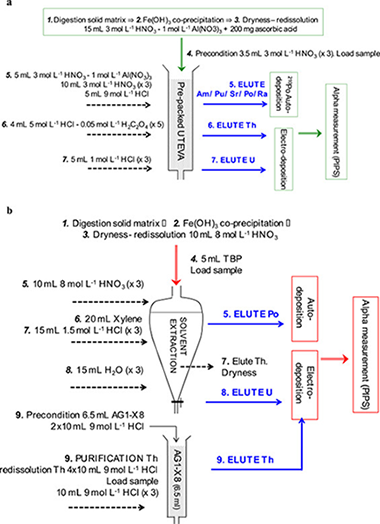
The development of Deep Geological Repositories (DGP) to the storage of high-level radioactive waste (HLRW) is mainly focused in systems of multiple barriers based on the use of clays, and particularly bentonites, as natural and engineered barriers in nuclear waste isolation due to their remarkable properties.
Due to the fact that uranium is the major component of HLRW, it is required to go in depth in the analysis of the chemistry of the reaction of this element within bentonites. The determination of uranium under the conditions of HLRW, including the analysis of silicate matrices before and after the uranium-bentonite reaction, was investigated. The performances of a state-of-the-art and widespread radiochemical method based on chromatographic UTEVA resins, and a well-known and traditional method based on solvent extraction with tri-n-butyl phosphate (TBP), for the analysis of uranium and thorium isotopes in solid matrices with high concentrations of uranium were analysed in detail.
In the development of this comparison, both radiochemical approaches have an overall excellent performance in order to analyse uranium concentration in HLRW samples. However, due to the high uranium concentration in the samples, the chromatographic resin is not able to avoid completely the uranium contamination in the thorium fraction.
July, 2018 | DOI: 10.1016/j.apradiso.2018.04.008
Materiales de Diseño para la Energía y Medioambiente
Plant cuticle under global change: Biophysical implications
Heredia-Guerrero, JA; Guzman-Puyol, S; Benitez, JJ; Athanassiou, A; Heredia, A; Dominguez, EGlobal Change Biology, 24 (2018) 2749-2751
Show abstract ▽
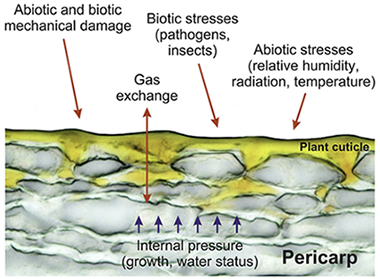
Climatic stressors due to global change induce important modifications to the chemical composition of plant cuticles and their biophysical properties.
In particular, plant cuticles can become heavier, stiffer and more inert, improving plant protection.
The climatic stressors that modify the chemical composition of plant tissues have been recently reviewed by Suseela and Tharayil (2018). In particular, the authors stated that the response of plants to global change effects (viz. increasing temperatures and frequent drought periods) can induce important modifications in plant cuticles such as an increase of the main cuticle components (cutin and polysaccharides), a preponderance of cutan, heavier wax loads, and changes in the chemical composition of waxes, mainly the accumulation of longer aliphatic compounds. In this letter, we would like to emphasize the biophysical consequences that this new scenario involves and how it would affect plant performance.
July, 2018 | DOI: 10.1111/gcb.14276
Materiales de Diseño para la Energía y Medioambiente
Heteroatom framework distribution and layer charge of sodium Taeniolite
Perdigon, AC; Pesquera, C; Cota, A; Osuna, FJ; Pavon, E; Alba, MDApplied Clay Science, 158 (2018) 246-251
Show abstract ▽
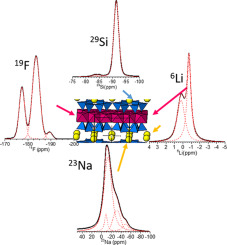
The most advanced applications of clays depend crucially on their hydration state and swelling is probably the most important feature of expandable 2:1 layered silicate. Sodium Taeniolite, Na-TAE, a swelling trioctahedral fluormica, has been synthesized and studied using thermogravimetric analysis, X-ray diffraction, scanning electron microscopy and infrared and solid state NMR spectroscopies. The results indicated the formation of a swelling 2:1 phyllosilicate with actual layer charge lower than the nominal one. Herein, a new heteroatom distribution and more accurate composition could be deduced.
June, 2018 | DOI: 10.1016/j.clay.2018.03.036
Materiales de Diseño para la Energía y Medioambiente
Cesium adsorption isotherm on swelling high-charged micas from aqueous solutions: Effect of temperature
Osuna, FJ; Cota, A; Pavon, E; Pazos, MC; Alba, MDAmerican Mineralogist, 103 (2018) 623-628
Show abstract ▽
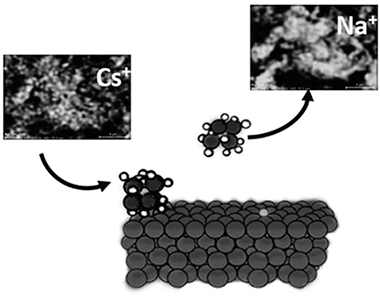
The potential use of a new family of synthetic swelling micas for cesium immobilization from aqueous solution was evaluated and the structural modifications after adsorption were analyzed. The results have revealed that they are good cesium adsorbents compared to natural clays and as the layer charge increases, the adsorption capacity and affinity increase. The cesium ions are adsorbed through a cation exchange mechanism, but an inner sphere complex with the basal O atoms of the tetrahedral sheet is favored. These findings imply that is possible to design minerals with improved environmental applications.
April, 2018 | DOI: 10.2138/am-2018-6203
Materiales de Diseño para la Energía y Medioambiente
Experimental measurement of the filtration efficiency and pressure drop of wall-flow diesel particulate filters (DPF) made of biomorphic Silicon Carbide using laboratory generated particles
Orihuela, MP; Gomez-Martin, A; Miceli, P; Becerra, JA; Chacartegui, R; Fino, DApplied Thermal Engineering, 131 (2018) 41-53
Show abstract ▽
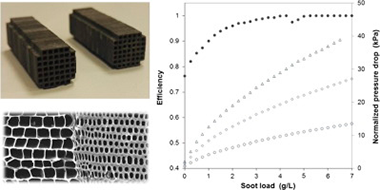
Biomorphic Silicon Carbide (bioSiC) has been recently introduced in the scope of porous ceramic substrates for hot gas filtration applications, where it has demonstrated to have good thermal and mechanical properties, and a high potential to meet the requirements for current Diesel Particulate Filters (DPF). In this experimental study, a small wall-flow bioSiC diesel filter was characterized using a soot generator, the particle size distribution of which being similar to the one generated by a diesel engine. The bioSiC samples were manufactured from Medium Density Fiberboard (MDF) following a general manufacturing procedure for bioSiC ceramics, but paying special attention in the mechanizing stage to the geometry and optimal design of the honeycomb structure required for diesel engine applications. The samples had a cell density of 57.59 cell/cm(2) (371.6 cpsi), a square cross section of 9.2 x 9.2 mm, and a length of 31 mm. To generate the particle laden stream and perform the filtration tests, a synthetic Soot Generator (SG) was used. Tests were performed under controlled and reproducible conditions, with a fixed gas flow rate of 5 LPM and a soot mass flow rate of 4 mg/h. The filtration efficiency was determined with the aid of a Scanning Mobility Particle Sizer (SMPS) from the measurements of the particle concentration upstream and downstream the filter samples. During the soot loading process, the pressure drop was also monitored. The results show that, in the initial stage (clean filter), bioSiC wall-flow DPFs may have a filtration efficiency between 0.7 and 0.85 and a pressure drop of around 2 kPa for a normalized wall velocity of 0.01 m/s at ambient temperature. The filtration performance of wall-flow bioSiC particle filters showed in this work can help us to better understand their real potential for automotive applications.
February, 2018 | DOI: 10.1016/j.applthermaleng.2017.11.149
Materiales de Diseño para la Energía y Medioambiente
Packing Defects in Fatty Amine Self-Assembled Monolayers on Mica as Revealed from AFM Techniques
Benitez, JJ; Heredia-Guerrero, JA; San-Miguel, MA; Galloway, HCJournal of Physical Chemistry B, 122 (2018) 493-499
Show abstract ▽
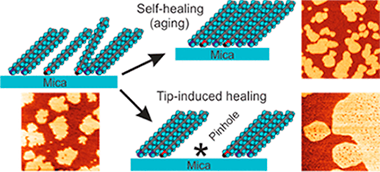
Self-assembled monolayers of n-octadecylamine (ODA-SAMs) on mica have been prepared and studied by contact and jumping mode atomic force microscopy (AFM). Adhesion and friction data show that the compactness of the monolayers spontaneously increases as they are allowed to ripen. Molecular packing can also be induced by the controlled mechanical perturbation exerted by the probe when getting into and out of contact intermittently. Under these conditions, defects and vacancies aggregate giving rise to detectable pinholes uniformly distributed in AFM images. Created pinhole density was found to decrease with ripening time, thus confirming the proposed spontaneous self-healing mechanism. Pinhole density is also suggested as a parameter characterizing the packing degree of ODA-SAMs, and it has been related to their tribological properties. Additionally, molecular dynamics simulations were used to corroborate the compatibility between the packing degree and the observed topography of ODA-SAMs on mica.
January, 2018 | DOI: 10.1021/acs.jpcb.7b03603
2017
2017
Materiales de Diseño para la Energía y Medioambiente
Performance of biomorphic Silicon Carbide as particulate filter in diesel boilers
Orihuela, M Pilar; Gomez-Martin, Aurora; Becerra, Jose A; Chacartegui, Ricardo; Ramirez-Rico, JoaquinJournal of Environmental Management, 203 (2017) 907-919
Show abstract ▽
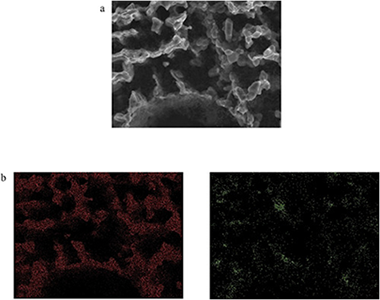
Biomorphic Silicon Carbide (bioSiC) is a novel porous ceramic material with excellent mechanical and thermal properties. Previous studies have demonstrated that it may be a good candidate for its use as particle filter media of exhaust gases at medium or high temperature. In order to determine the filtration efficiency of biomorphic Silicon Carbide, and its adequacy as substrate for diesel particulate filters, different bioSiC-samples have been tested in the flue gases of a diesel boiler. For this purpose, an experimental facility to extract a fraction of the boiler exhaust flow and filter it under controlled conditions has been designed and built. Several filter samples with different microstructures, obtained from different precursors, have been tested in this bench. The experimental campaign was focused on the measurement of the number and size of particles before and after placing the samples. Results show that the initial efficiency of filters made from natural precursors is severely determined by the cutting direction and associated microstructure. In biomorphic Silicon Carbide derived from radially cut wood, the initial efficiency of the filter is higher than 95%. Nevertheless, when the cut of the wood is axial, the efficiency depends on the pore size and the permeability, reaching in some cases values in the range 70–90%. In this case, the presence of macropores in some of the samples reduces their efficiency as particle traps. In continuous operation, the accumulation of particles within the porous media leads to the formation of a soot cake, which improves the efficiency except in the case when extra-large pores exist. For all the samples, after a few operation cycles, capture efficiency was higher than 95%. These experimental results show the potential for developing filters for diesel boilers based on biomorphic Silicon Carbide.
December, 2017 | DOI: 10.1016/j.jenvman.2017.05.003
Materiales de Diseño para la Energía y Medioambiente
High temperature compressive strength and creep behavior of Si-Ti-C-O fiber-bonded ceramics
Vera, MC; Martinez-Fernandez, J; Singh, M; Ramirez-Rico, JJournal of the European Ceramic Society, 37 (2017) 4442-4448
Show abstract ▽
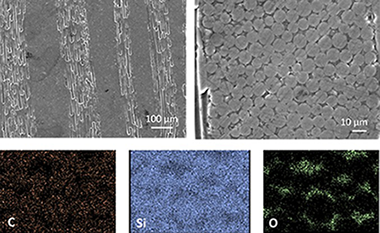
Fiber bonded silicon carbide ceramic materials provide cost-advantage over traditional ceramic matrix composites and require fewer processing steps. Despite their interest in extreme environment thermostructural applications no data on long term mechanical reliability other than static fatigue is available for them. We studied the high temperature compressive strength and creep behavior of a fiber bonded SiC material obtained by hot-pressing of Si Ti-C-O fibers. The deformation mechanism and onset of plasticity was evaluated and compared with other commercial SiC materials. Up to 1400 degrees C, plasticity is very limited and any macroscopic deformation proceeds by crack formation and damage propagation. A transient viscous creep stage is observed due to flow in the silica matrix and once steady state is established, a stress exponent n similar to 4 and an activation energy Q similar to 700 kJ mol(-1) are found. These results are consistent with previous data on creep of polymer derived SiC fibers and polycrystals.
December, 2017 | DOI: 10.1016/j.jeurceramsoc.2017.06.037
Materiales de Diseño para la Energía y Medioambiente
Effect of the crystal chemistry on the hydration mechanism of swelling micas
Pavon, E; Alba, MD; Castro, MA; Cota, A; Osuna, FJ; Pazos, MCGeochimica et Cosmochimica Acta, 217 (2017) 231-239
Show abstract ▽
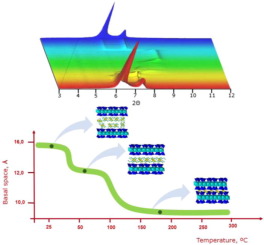
Swelling and dehydration under minor changes in temperature and water vapor pressure is an important property that clays and clay minerals exhibit. In particular, their interlayer space, the solid-water interface and the layers' collapse and re-expansion have received much attention because it affects to the dynamical properties of interlayer cations and thus the transfer and fate of water and pollutants. In this contribution, the dehydration and rehydration mechanism of a swelling high-charge mica family is examined by in situ X-ray Diffraction. The effect of the aluminosilicate layer charge and the physicochemical properties of the interlayer cations on these processes are analyzed. The results showed that the dehydration temperature and the number of steps involved in this process are related to the layer charge of the silicate and the physicochemical properties of the interlayer cations. Moreover, the ability to adsorb water molecules in a confined space with high electric field by the interlayer cations does not only depend on their hydration enthalpy but also on the electrostatic parameters of these cations.
November, 2017 | DOI: 10.1016/j.gca.2017.08.028
Materiales de Diseño para la Energía y Medioambiente
Cellulose-polyhydroxylated fatty acid ester-based bioplastics with tuning properties: Acylation via a mixed anhydride system
Heredia-Guerrero, JA; Goldoni, L; Benitez, JJ; Davis, A; Ceseracciu, L; Cingolani, R; Bayer, IS; Heinze, T; Koschella, A; Heredia, A; Athanassiou, ACarbohydrate Polymers, 173 (2017) 312-320
Show abstract ▽
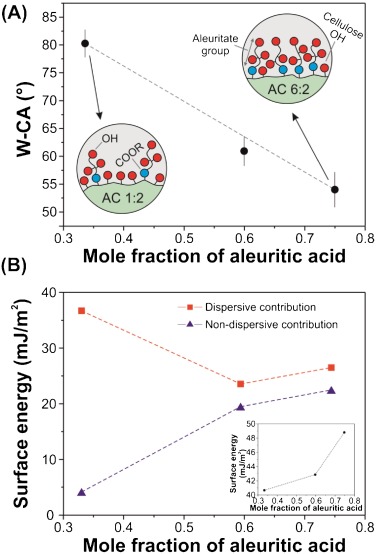
The synthesis of microcrystalline cellulose (MCC) and 9,10,16-hydroxyhexadecanoic (aleuritic) acid ester-based bioplastics was investigated through acylation in a mixed anhydride (trifluoroacetic acid (TFA)/trifluoroacetic acid anhydride (TFAA)), chloroform co-solvent system. The effects of chemical interactions and the molar ratio of aleuritic acid to the anhydroglucose unit (AGU) of cellulose were investigated. The degree of substitution (DS) of new polymers were characterized by two-dimensional solution-state NMR and ranged from 0.51 to 2.60. The chemical analysis by attenuated total reflection Fourier transform infrared spectroscopy (ATR-FTIR) confirmed the presence of aleuritate groups in the structure induces the formation of new H-bond networks. The tensile analysis and the contact angle measurement confirmed the ductile behavior and the hydrophobicity of the prepared bioplastics. By increasing the aleuritate amounts, the glass transition temperature decreased and the solubility of bioplastic films in most common solvents was improved. Furthermore, this new polymer exhibits similar properties compared to commercial cellulose derivatives.
October, 2017 | DOI: 10.1016/j.carbpol.2017.05.068
Materiales de Diseño para la Energía y Medioambiente
High-temperature thermal conductivity of biomorphic SiC/Si ceramics
Ramirez-Rico, J.; Singh, M.; Zhu, D.; Martinez-Fernandez, J.Journal of Materials Science, 52 (2017) 10038-10046
Show abstract ▽
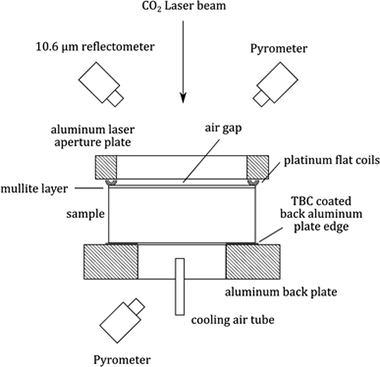
Thermal conductivity of biomorphic SiC/Si, a silicon carbide + silicon containing two phase material, was evaluated using the laser steady-state heat flux method. These materials were processed via silicon melt infiltration of wood-derived carbon scaffolds. In this approach, heat flux was measured through the thickness when one side of the specimen was heated with a 10.6-A mu m CO2 laser. A thin mullite layer was applied to the heated surface to ensure absorption and minimize reflection losses, as well as to ensure a consistent emissivity to facilitate radiative loss corrections. The influence of the mullite layer was accounted for in the thermal conductivity calculations. The effect of microstructure and composition (inherited from the wood carbonaceous performs) on measured conductivity was evaluated. To establish a baseline for comparison, a dense, commercially available sintered SiC ceramic was also evaluated. It was observed that at a given temperature, thermal conductivity falls between that of single-crystal silicon and fine-grained polycrystalline SiC and can be rationalized in terms of the SiC volume fraction in biomorphic SiC/Si material.
September, 2017 | DOI: 10.1007/s10853-017-1199-y
Materiales de Diseño para la Energía y Medioambiente
Cutin from agro-waste as a raw material for the production of bioplastics
Heredia-Guerrero, JA; Heredia, A; Dominguez, E; Cingolani, R; Bayer, IS; Athanassiou, A; Benitez, JJJournal of Experimental Botany, 68 (2017) 5401-5410
Show abstract ▽
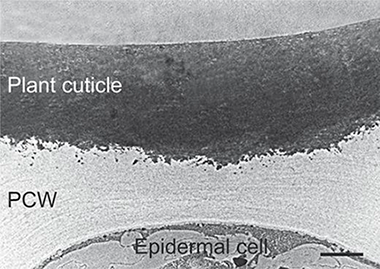
Cutin is the main component of plant cuticles constituting the framework that supports the rest of the cuticle components. This biopolymer is composed of esterified bi- and trifunctional fatty acids. Despite its ubiquity in terrestrial plants, it has been underutilized as raw material due to its insolubility and lack of melting point. However, in recent years, a few technologies have been developed to obtain cutin monomers from several agro-wastes at an industrial scale. This review is focused on the description of cutin properties, biodegradability, chemical composition, processability, abundance, and the state of art of the fabrication of cutin-based materials in order to evaluate whether this biopolymer can be considered a source for the production of renewable materials.
August, 2017 | DOI: 10.1093/jxb/erx272
Materiales de Diseño para la Energía y Medioambiente
New insights into surface-functionalized swelling high charged micas: Their adsorption performance for non-ionic organic pollutants
Pazos, MC; Castro, MA; Cota, A; Osuna, FJ; Pavon, E; Alba, MDJournal of Industrial and Engineering Chemistry, 52 (2017) 179-186
Show abstract ▽
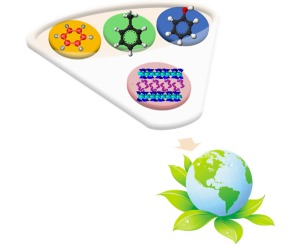
The major components of the wastewater from the petroleum refineries are benzene, toluene and phenol and one of the techniques applied to the treatment of effluents is sorption using organo-functionalized clay. The materials exploited in the present study are a family of surface-functionalized synthetic micas and their sorption capacities for non-ionic organic pollutants are analyzed. The organo-functionalization of their surface provides them the capacity to sorb effectively non-ionic pollutants in the interface. Their adsorption performance is a function of the alkylamonium properties such as the chain length, the mass fraction and the organization of the organic cation in the interlayer space of the micas.
August, 2017 | DOI: 10.1016/j.jiec.2017.03.042
Materiales de Diseño para la Energía y Medioambiente
Biomorphic ceramics from wood-derived precursors
Ramirez-Rico, J.; Martinez-Fernandez, J.; Singh, M.International Materials Reviews, 62 (2017) Issue 8
Show abstract ▽
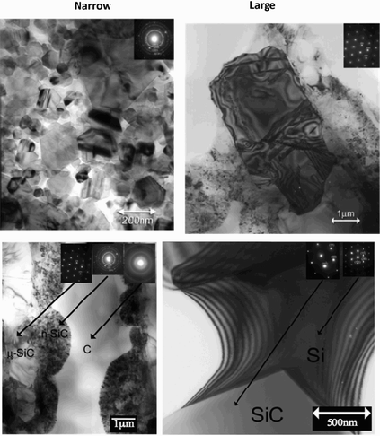
Materials development is driven by microstructural complexity and, in many cases, inspired by biological systems such as bones, shells and wood. In one approach, one selects the main microstructural features responsible for improved properties and design processes to obtain materials with such microstructures (continuous-fibre-reinforced ceramics, porous ceramics, fibrous ceramic monoliths, etc.). In a different approach, it is possible to use natural materials directly as microstructural templates. Biomorphic ceramics are produced from natural and renewable resources (wood or wood-derived products). A wide variety of SiC-based ceramics can be fabricated by infiltration of silicon or silicon alloys into cellulose-derived carbonaceous templates, providing a low-cost route to advanced ceramic materials with near-net shape potential and amenable to rapid prototyping. These materials have tailorable microstructure and properties, and behave like ceramic materials manufactured by advanced ceramic processing approaches. This review aims to be a comprehensive description of the development of bioSiC ceramics: from wood templates and their microstructure to potential applications of bioSiC materials.
August, 2017 | DOI: 10.1080/09506608.2017.1354429
Materiales de Diseño para la Energía y Medioambiente
Cs+ immobilization by designed micaceous adsorbent under subcritical conditions
Osuna, FJ; Cota, A; Pavon, E; Pazos, MC; Alba, MDApplied Clay Science, 143 (2017) 293-299
Show abstract ▽
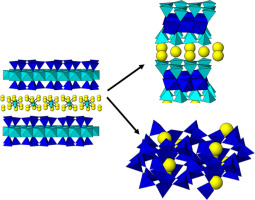
The adsorption of Cs+ by clay minerals is a complicate process, being cation exchange and frayed-edge sites the major mechanisms that govern it. However, environmental variables have a significant impact on the process. In this work, the influence of the temperature and time in the cesium adsorption capacity of Na-Mica-n (n = 2 and 4) have been explored under subcritical conditions. Those synthetic micas were able to immobilize cations Cs+ combining adsorption at nonspecific sites, at specific sites and chemical reaction. The distribution constant of Cs+ was larger in the Na-Mica-2 denoting a higher concentration of specific adsorption sites when layer charge decreased.
July, 2017 | DOI: 10.1016/j.clay.2017.03.041
Materiales de Diseño para la Energía y Medioambiente
Failure mode and effect analysis of a large scale thin-film CIGS photovoltaic module
Delgado-Sanchez, JM; Sanchez-Cortezon, E; Lopez-Lopez, C; Aninat, R; Alba, MDEngireering failure analysis, 76 (2017) 55-60
Show abstract ▽
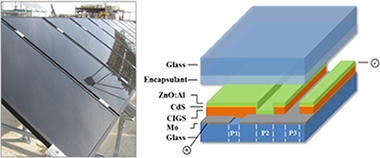
The efficiency of thin-film CIGS based cells at the laboratory scale is now getting closer to conventional Silicon technologies. As a consequence, the long-term stability of CIGS is now one of the main challenges left to address in order to assess its potential as an alternative for photovoltaic plants. This paper reports an overview of the critical risks for the commercial viability of the CIGS thin-film technology. The key causes of the potential failures of this technology are determined through the Failure Mode Analysis and Effects (FMEA) methodology. To validate the results obtained from the FMEA, aging tests and outdoor monitoring were also carried out. Based on the results obtained, we argue that the encapsulation material is the main cause of degradation in CIGS modules.
June, 2017 | DOI: 10.1016/j.engfailanal.2017.02.004
Materiales de Diseño para la Energía y Medioambiente
Features of electrical properties of BE-C(Fe) biocarbons carbonized in the presence of an Fe-containing catalyst
Popov, VV; Orlova, TS; Gutierrez-Pardo, A; Ramirez-Rico, JPhysics of the Solid State, 59 (2017) 703-709
Show abstract ▽
The effect of partial graphitization on electrical and galvanomagnetic properties of BE-C(Fe) biomorphic carbons produced by beech wood carbonization at temperatures of 850-1600A degrees C in the presence of an iron-containing catalyst is studied. The use of an Fe catalyst at D cent (carb) ae<yen> 1000A degrees C leads to the formation of nanoscale graphite-phase inclusions; its total volume and nanocrystallite sizes increase with D cent (carb). The data on the carrier concentration and mobility are obtained. It was shown that partially graphitized BE-C(Fe) carbons with D cent (carb) ae<yen> 1000A degrees C in the conductivity type and magnetoresistance features relate to highly disordered metal systems whose conductivity can be described taking into account the contribution of quantum corrections, mainly the correction caused by the electron-electron interaction. It is shown that nonmonotonic dependences of the Hall constant R on the magnetic field are characteristic of BE-C(Fe) samples with 1000 ae<currency> D cent (carb) < 1600A degrees C, which is most probably caused by the contribution of various carrier groups, i.e., electrons and holes. In BE-C(Fe) samples with D cent (carb) = 1600A degrees C, the Hall coefficient corresponds to the metal state, which is associated with conducting medium homogenization resulting from the formation of a significant graphite phase volume.
April, 2017 | DOI: 10.1134/S1063783417040205
Materiales de Diseño para la Energía y Medioambiente
Precision and accuracy of stress measurement with a portable X-ray machine using an area detector
Lee, SY; Ling, JJ; Wang, SH; Ramirez-Rico, JJournal of Applied Crystallography, 50 (2017) 131-144
Show abstract ▽
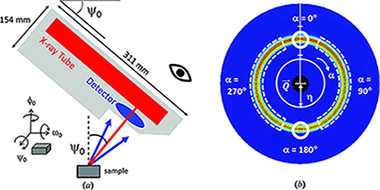
The use of portable X-ray stress analyzers, which utilize an area detector along with the newly adopted 'cos alpha' or full-ring fitting method, has recently attracted increasing interest. In laboratory conditions, these measurements are fast, convenient and precise because they employ a single-exposure technique that does not require sample rotation. In addition, the effects of grain size and orientation can be evaluated from the Debye ring recorded on the area detector prior to data analysis. The accuracy of the measured stress, however, has been questioned because in most cases just a single reflection is analyzed and the sample-to-detector distances are relatively short. This article presents a comprehensive analysis of the uncertainty associated with a state-of-the-art commercial portable X-ray device. Annealed ferrite reference powders were used to quantify the instrument precision, and the accuracy of the stress measurement was tested by in situ tensile loading on 1018 carbon steel and 6061 aluminium alloy bar samples. The results show that the precision and accuracy are sensitive to the instrument (or sample) tilt angle (0) as well as to the selected hkl reflection of the sample. The instrument, sample and data analysis methods all affect the overall uncertainty, and each contribution is described for this specific portable X-ray system. Finally, on the basis of the conclusions reached, desirable measurement/analysis protocols for accurate stress assessments are also presented.
February, 2017 | DOI: 10.1107/S1600576716018914
Materiales de Diseño para la Energía y Medioambiente
Packaging Materials: All‐Natural Sustainable Packaging Materials Inspired by Plant Cuticles (Adv. Sustainable Syst. 1‐2/2017)
Heredia-Guerrero, JA; Benitez, JJ; Cataldi, P; Paul, UC; Contardi, M; Cingolani, R; Bayer, IS; Heredia, A; Athanassiou, AAdvanced Sustainable Systems, 1 (2017)
Show abstract ▽
In article number 1600024, José A. Heredia‐Guerrero, Athanassia Athanassiou, and co‐workers present new, sustainable composite materials inspired by plant cuticles. These materials are fabricated by the impregnation of fibrous cellulose substrates with a naturally occurring polyhydroxylated fatty acid, and subsequent polymerization of the latter into a polyester. In the image a piece of this new material is shown together with tomato and pepper fruits. Cover image created by Dr. Duilio Farina.
February, 2017 | DOI: 10.1002/adsu.201770012
Materiales de Diseño para la Energía y Medioambiente
Front contact optimization of industrial scale CIGS solar cells for low solar concentration using 2D physical modeling
Delgado-Sanchez, JM; Lopez-Gonzalez, JM; Orpella, A; Sanchez-Cortezon, E; Alba, MD; Lopez-Lopez, C; Alcubilla, RRenewable Energy, 101 (2017) 90-95
Show abstract ▽
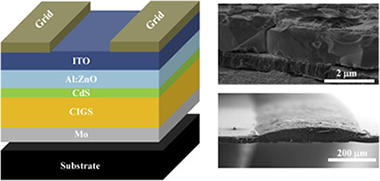
Cu(In,Ga)Se-2 (CIGS) technology is one of the best absorber materials with record efficiencies among photovoltaic thin-film technologies (22.3% at lab scale and 16% at large commercial module). Although research on this material was originally motivated by low-cost, glass-glass applications focusing to fixed photovoltaic structures, the high efficiency values make CIGS an interesting alternative for low concentration systems. In this paper a 2D model for Cu(In,Ga)Se-2 (CIGS) solar cells under low solar concentration is described and contrasted with experimental data. Using simulation, the effect of front electric contact design parameters: finger width, finger separation, and number of buses are analyzed for solar concentrations from 1 up to 10 suns. Efficiency maps allowing front contact grid optimization are shown and analyzed for each concentration factor (Cx), assessing the viability of CIGS solar cells for low concentration applications, where commercial CIGS solar cells may exhibit 35% of electrical power increases with proper front grid optimization under low concentration respect to conventional grid design.
January, 2017 | DOI: 10.1016/j.renene.2016.08.046
Materiales de Diseño para la Energía y Medioambiente
Insolubilization and thermal stabilization of a long-chain polyester by noncatalyzed melt-polycondensation synthesis in air
Benitez, JJ; Heredia-Guerrero, JA; Cruz-Carrillo, MA; Barthel, MJ; Knicker, HE; Heredia, AJournal of Applied Polymer Science, 134 (2017) 1 art 44350
Show abstract ▽
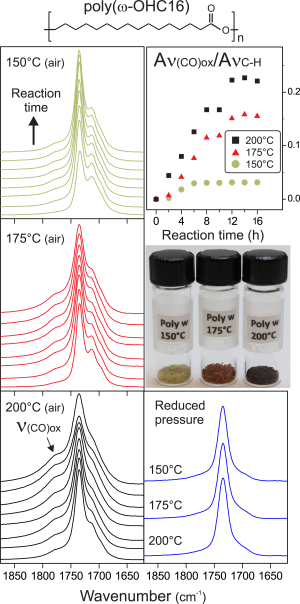
Self-standing films of poly(-hydroxyl hexadecanoic acid) [poly(-OHC16)] have been prepared by noncatalyzed melt-polycondensation in air at 150, 175, and 200 degrees C. Poly(-OHC16)s obtained are characterized as polyesters by infrared spectroscopy (FT-IR) and solid state magic angle spinning C-13 nuclear magnetic resonance (C-13 MAS-NMR). Structurally, poly(-OHC16)s are quite crystalline as revealed by wide angle X-ray diffraction (WAXD). The presence of oxygen in the reaction atmosphere causes a mild oxidation in the form of peroxyester species, tentatively at the interphase between poly(-OHC16) crystallites, and the structure amorphization. The interfacial peroxyester phase ends up in the encapsulation of the polyester grains and provides a barrier towards the action of solvents. Thermal stabilization and insolubility resulting from the synthesis conditions used are interesting features to prepare solvent and heat resistant poly(-OHC16) coatings. Thus, a few microns thick poly(-OHC16) layer has been fabricated on aluminum foil and its resistivity towards a chloroform:methanol (1:1, v:v) mixture has been confirmed.
January, 2017 | DOI: 10.1002/app.44350
2016
2016
Materiales de Diseño para la Energía y Medioambiente
Microstructure, elastic, and inelastic properties of biomorphic carbons carbonized using a Fe-containing catalyst
Orlova, TS; Kardashev, BK; Smirnov, BI; Gutierrez-Pardo, A; Ramirez-Rico, JPhysics of the Solid State, 58 (2016) 2481-2487
Show abstract ▽
The microstructure and amplitude dependences of the Young’s modulus E and internal friction (logarithmic decrement δ), and microplastic properties of biocarbon matrices BE-C(Fe) obtained by beech tree carbonization at temperatures Tcarb = 850–1600°C in the presence of an iron-containing catalyst are studied. By X-ray diffraction analysis and transmission electron microscopy, it is shown that the use of Fe-catalyst during carbonization with Tcarb ≥ 1000°C leads to the appearance of a bulk graphite phase in the form of nanoscale bulk graphite inclusions in a quasi-amorphous matrix, whose volume fraction and size increase with Tcarb. The correlation of the obtained dependences E(Тcarb) and δ(Tcarb) with microstructure evolution with increasing Тcarb is revealed. It is found that E is mainly defined by a crystalline phase fraction in the amorphous matrix, i.e., a nanocrystalline phase at Тcarb < 1150°C and a bulk graphite phase at Tcarb > 1300°C. Maximum values E = 10–12 GPa are achieved for samples with Тcarb ≈ 1150 and 1600°C. It is shown that the microplasticity manifest itself only in biocarbons with Tcarb ≥ 1300°C (upon reaching a significant volume of the graphite phase); in this case, the conditional microyield stress decreases with increasing total volume of introduced mesoporosity (free surface area).
December, 2016 | DOI: 10.1134/S1063783416120234
Materiales de Diseño para la Energía y Medioambiente
Thermal conductivity of porous biomorphic SiC derived from wood precursors
Gomez-Martin, A; Orihuela, MP; Ramirez-Rico, J; Chacartegui, R; Martinez-Fernandez, JCeramics International, 42 (2016) 16220-16229
Show abstract ▽
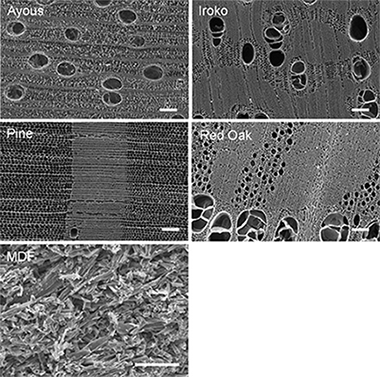
Biomorphic SiC is a SiC/Si composite made by the reactive infiltration of molten silicon by capillarity into a carbon preform from high-temperature pyrolysis of a wood porous precursor. When excess silicon is removed, a hierarchically porous SiC material with highly interconnected porosity is obtained. By choosing different wood precursors, different pore size distributions can be obtained thus tailoring the resulting properties.
We study the thermal conductivity of porous biomorphic SiC from five different precursors, including a recycled wood product, in order to determine the microstructure-conductivity correlation. Here, we remove the excess of silicon by a high temperature capillary extraction-evaporation method. We used the laser flash technique to measure thermal diffusivity in the range similar to 300 K to 973 K, in order to determine the thermal conductivity. Thermal conductivities in the range 4-88 W/m K were achieved. The temperature, porosity, pore shape and orientation, and the treatment used to remove the remaining silicon all have a significant impact in the resulting thermal conductivity. We explain this influence in a first approximation in terms of a geometrical model.
November, 2016 | DOI: 10.1016/j.ceramint.2016.07.151
Materiales de Diseño para la Energía y Medioambiente
Enhancement of dielectric barrier layer properties by sol-gel and PECVD stacks
Lopez-Lopez, C; Menendez, MF; Menendez, LA; Menendez, A; Sanchez, P; Alba, MD; Sanchez-Cortezon, E; Delgado-Sanchez, JMSurface and Coatings Technology, 305 (2016) 36-40
Show abstract ▽
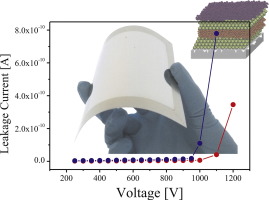
Thin-film PV modules grown on flexible, light weight, thermally stable and low cost substrates such as stainless steel foil, are an attractive product for solar market applications. When metal foils are used as substrate, it is essential to deposit a dielectric barrier layer to isolate electrically and chemically the thin-film solar cells from the substrate. In this work, SiOx stacks deposited on ‘rough’ stainless steel by a combination of a new sol-gel formulation and a Plasma Enhanced Chemical Vapor Deposition (PECVD) deposition step are reported as a suitable dielectric barrier layer candidate. Using these SiOx multilayers, a smooth and homogeneous film was achieved. X-ray diffraction (XRD) analysis showed that back contact of the solar cell (based on Molybdenum) is not affected by the presence of the barrier layer. Moreover, according to X-ray photoelectron spectroscopy (XPS) and Secondary Ion Mass Spectrometry (SIMS) measurements, this approach led to excellent barrier layer properties against the diffusion of impurities from the stainless steel. A complete electrical characterization of these dielectric barrier layers was also carried out showing good electrical insulation.
November, 2016 | DOI: 10.1016/j.surfcoat.2016.07.085
Materiales de Diseño para la Energía y Medioambiente
Manganese Dioxide Supported on Porous Biomorphic Carbons as Hybrid Materials for Energy Storage Devices
Gutierrez-Pardo, A; Lacroix, B; Martinez-Fernandez, J; Ramirez-Rico, JACS Applied Materials & Interfaces, 8 (2016) 30890-30898
Show abstract ▽
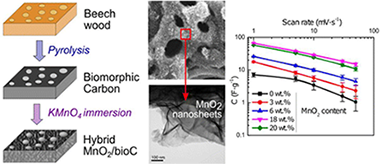
A facile and low-cost method has been employed to fabricate MnO2/C hybrid materials for use as binder-free electrodes for supercapacitor applications. Biocarbon monoliths were obtained through pyrolysis of beech wood, replicating the microstructure of the cellulosic precursor, and serve as 3D porous and conductive scaffolds for the direct growth of MnO, nanosheets by a solution method. Evaluation of the experimental results indicates that a homogeneous and uniform composite material made of a carbon matrix exhibiting ordered hierarchical porosity and MnO, nanosheets with a layered nanocrystalline structure is obtained. The tuning of the MnO2 content and crystallite size via the concentration of KMnO4 used as impregnation solution allows to obtain composites that exhibit enhanced electrochemical behavior, achieving a capacitance of 592 F g(-1) in electrodes containing 3 wt % MnO2 with an excellent cyclic stability. The electrode materials were characterized before and after electrochemical testing.
November, 2016 | DOI: 10.1021/acsami.6b09361
Materiales de Diseño para la Energía y Medioambiente
Permeability and mechanical integrity of porous biomorphic SiC ceramics for application as hot-gas filters
Gomez-Martin, A.; Orihuela, M. P.; Becerra, J. A.; Martinez-Fernandez, J.; Ramirez-Rico, J.Materials & Design, 107 (2016) 450-460
Show abstract ▽
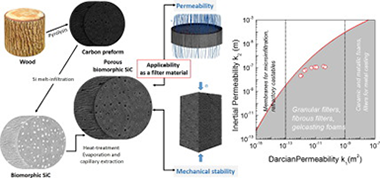
Biomorphic SiC is a biotemplated material fabricated by Si melt-infiltration of carbon preforms from wood pyrolysis. In this work, porous bioSiC ceramics from five different wood precursors, with porosities between 45 and 72% were studied for their feasibility in filtering applications.
Gas permeability and mechanical stability were investigated as a function of the microstructure of the starting wood precursor. Air-permeation performance at room temperature was measured for a range of flow rates, and the permeability constants were assessed by fitting of Forchheimer's equation to the experimental data. Darcian permeabilities were achieved in the range 10− 11–10− 12 m2, while inertial terms were in the range 10− 7–10− 8 m, showing a correlation with the average pore size and orientation of the larger channels. Regarding the mechanical stability, maximum compressive strength values were reached in the range of 3–115 MPa.
These results improve our understanding of the ways in which the microstructure influences permeability and mechanical robustness, enabling the device requirements to be tailored by selecting the wood precursor. It was also shown that these materials are promising for hot-gas filtering applications.
October, 2016 | DOI: 10.1016/j.matdes.2016.06.060
Materiales de Diseño para la Energía y Medioambiente - Materiales Nanoestructurados y Microestructura
Monolithic supports based on biomorphic SiC for the catalytic combustion of hydrogen
Arzac, G. M.; Ramirez-Rico, J.; Gutierrez-Pardo, A.; Jimenez de Haro, M. C.; Hufschmidt, D.; Martinez-Fernandez, J.; Fernandez, A.RSC Advances, 6 (2016) 66373-66384
Show abstract ▽
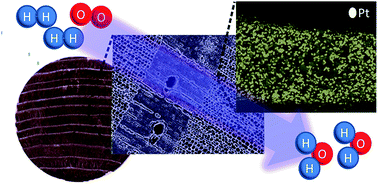
Catalytic hydrogen combustion was studied with H-2/air mixtures in conditions that simulate the H-2 concentration of the exhaust gases from fuel cells (3-4% v/v H-2 in air). Pt-impregnated monoliths based on porous biomorphic SiC (bio-SiC) substrates were employed for the first time for this reaction. Capillary forces were exploited for the incipient impregnation of supports with H2PtCl6 solutions. Freeze drying permitted us to obtain a homogeneous distribution of the active phase reducing accumulation at the monolith's outer shell. The supports and catalysts were characterized from a structural and thermal point of view. Catalytic tests were performed in a homemade reactor fed with up to 1000 ml min(-1) H-2/air mixtures and a diffusional regime (non-isothermal) was achieved in the selected conditions. Catalyst loading was tested in the range of 0.25-1.5 wt% Pt and 100% conversion was achieved in all cases. Temperatures were recorded at different points of the monoliths during the reaction showing anisotropic thermal behavior for selected bio-SiC substrates. These effects are of interest for heat management applications and were explained in correlation with thermal conductivity measurements performed on the supports. Pt-impregnated monoliths were also tested in less than 100% conversion conditions (1% v/v H-2 in air) and in powder form in kinetic conditions for comparative purposes.
September, 2016 | DOI: 10.1039/c6ra09127j
Materiales de Diseño para la Energía y Medioambiente
Sliding wear resistance of porous biomorphic sic ceramics
Lopez-Robledo, MJ; Gomez-Martin, A; Ramirez-Rico, J; Martinez-Fernandez, JInternational Journal of Refractory Metals & Hard Materials, 59 (2016) 26-31
Show abstract ▽
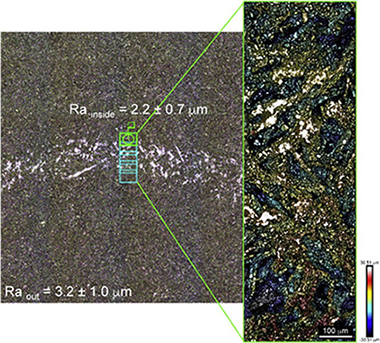
Porous biomorphic SiC ceramics were fabricated from four different wood precursors, three natural woods and one recycled wood product, by reactive infiltration of molten silicon into a carbon preform obtained from wood pyrolysis. Sliding wear resistance when sliding against a Si3N4 ball in air was studied. Tribological experiments were done with a pin-on-disk apparatus, under normal loads of 1 and 2 N, at a sliding velocity of 100 mm/s. The wear properties and the volume fraction of porosity were correlated. A commercial sintered SiC ceramic was also tested for comparison. The measured values of friction coefficient were in the range reported in literature for monolithic SiC ceramics under similar dry contact conditions. Two concurrent wear mechanisms are taking place: abrasion from the SiC debris and soft ploughing. The presence of an oxide tribolayer was assessed using energy dispersive X-ray analysis. Wear rates were found to scale with the composite porosity.
September, 2016 | DOI: 10.1016/j.ijrmhm.2016.05.004
Materiales de Diseño para la Energía y Medioambiente
Electrochemical Energy Storage Applications of CVD Grown Niobium Oxide Thin Films
Fiz, Raquel; Appel, Linus; Gutierrez-Pardo, Antonio; Ramirez-Rico, Joaquin; Mathur, SanjayACS Applied Materials & Interfaces, 8 (2016) 21423–21430
Show abstract ▽
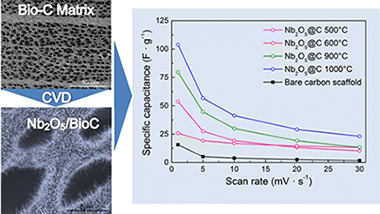
We report here on the controlled synthesis, characterization, and electrochemical properties of different polymorphs of niobium pentoxide grown by CVD of new single-source precursors. Nb2O5 films deposited at different temperatures showed systematic phase evolution from low-temperature tetragonal (TT-Nb2O5, T-Nb2O5) to high temperature monoclinic modifications (H–Nb2O5). Optimization of the precursor flux and substrate temperature enabled phase-selective growth of Nb2O5 nanorods and films on conductive mesoporous biomorphic carbon matrices (BioC). Nb2O5 thin films deposited on monolithic BioC scaffolds produced composite materials integrating the high surface area and conductivity of the carbonaceous matrix with the intrinsically high capacitance of nanostructured niobium oxide. Heterojunctions in Nb2O5/BioC composites were found to be beneficial in electrochemical capacitance. Electrochemical characterization of Nb2O5/BioC composites showed that small amounts of Nb2O5 (as low as 5%) in conjunction with BioCarbon resulted in a 7-fold increase in the electrode capacitance, from 15 to 104 F g–1, while imparting good cycling stability, making these materials ideally suited for electrochemical energy storage applications.
August, 2016 | DOI: 10.1021/acsami.6b03945
Materiales de Diseño para la Energía y Medioambiente
Stress measurement using area detectors: a theoretical and experimental comparison of different methods in ferritic steel using a portable X-ray apparatus
Ramirez-Rico, J; Lee, SY; Ling, JJ; Noyan, ICJournal of Materials Science, 51 (2016) 5343-5355
Show abstract ▽
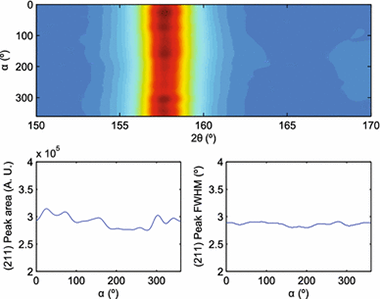
Using area detectors for stress determination by diffraction methods in a single exposure greatly simplifies the measurement process and permits the design of portable systems without complex sample cradles or moving parts. An additional advantage is the ability to see the entire or a large fraction of the Debye ring and thus determine texture and grain size effects before analysis. The two methods most commonly used to obtain stress from a single Debye ring are the so-called cosαcosαand full-ring fitting methods, which employ least-squares procedures to determine the stress from the distortion of a Debye ring by probing a set of scattering vector simultaneously. The widely applied sin2ψsin2ψ method, in contrast, requires sample rotations to probe a different subset of scattering vector orientations. In this paper, we first present a description of the different methods under the same formalism and using a unified set of coordinates that are suited to area detectors normal to the incident beam, highlighting the similarities and differences between them. We further characterize these methods by means of in situ measurements in carbon steel tube samples, using a portable detector in reflection geometry. We show that, in the absence of plastic flow, the different methods yield basically the same results and are equivalent. An analysis of possible sources of errors and their impact in the final stress values is also presented.
June, 2016 | DOI: 10.1007/s10853-016-9837-3
Materiales de Diseño para la Energía y Medioambiente
Thermal conductivity of Fe graphitized wood derived carbon
Ramirez-Rico, J; Gutierrez-Pardo, A; Martinez-Fernandez, J; Popov, VV; Orlova, TSMaterials & Design, 99 (2016) 528-534
Show abstract ▽

Graphitic porous carbon materials from pyrolysis of wood precursors were obtained by means of a nanosized Fe catalyst, and their microstructure and electrical and thermal transport properties investigated. Thermal and electrical conductivity of graphitized carbon materials increase with the pyrolysis temperature, indicating a relationship between the degree of graphitization and thus in crystallite size with transport properties in the resulting carbon scaffolds. Evaluation of the experimental results indicate that thermal conductivity is mainly through phonons and increases with the temperature in Fe-catalyzed carbons suggesting that the mean free path of phonons in the material is small and defect scattering dominates over phonon-phonon interactions in the range from room temperature to 800 °C.
June, 2016 | DOI: 10.1016/j.matdes.2016.03.070
Materiales de Diseño para la Energía y Medioambiente
Biological strategy for the fabrication of highly ordered aragonite helices: the microstructure of the cavolinioidean gastropods
Checa, AG; Macias-Sanchez, E; Ramirez-Rico, JScientific Reports, 6 (2016) article number 25989
Show abstract ▽
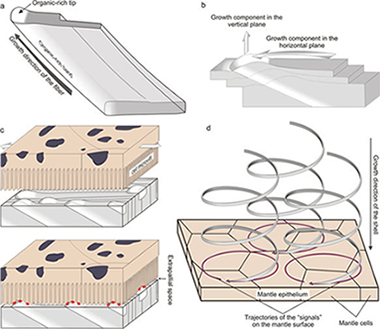
The Cavolinioidea are planktonic gastropods which construct their shells with the so-called aragonitic helical fibrous microstructure, consisting of a highly ordered arrangement of helically coiled interlocking continuous crystalline aragonite fibres. Our study reveals that, despite the high and continuous degree of interlocking between fibres, every fibre has a differentiated organic-rich thin external band, which is never invaded by neighbouring fibres. In this way, fibres avoid extinction. These intra-fibre organic-rich bands appear on the growth surface of the shell as minuscule elevations, which have to be secreted differentially by the outer mantle cells. We propose that, as the shell thickens during mineralization, fibre secretion proceeds by a mechanism of contact recognition and displacement of the tips along circular trajectories by the cells of the outer mantle surface. Given the sizes of the tips, this mechanism has to operate at the subcellular level. Accordingly, the fabrication of the helical microstructure is under strict biological control. This mechanism of fibre-by-fibre fabrication by the mantle cells is unlike that any other shell microstructure.
May, 2016 | DOI: 10.1038/srep25989
Materiales de Diseño para la Energía y Medioambiente
Biodegradable polyester films from renewable aleuritic acid: surface modifications induced by melt-polycondensation in air
Benitez, JJ; Heredia-Guerrero, JA; de Vargas-Parody, MI; Cruz-Carrillo, MA; Morales-Florez, V; de la Rosa-Fox, N; Heredia, AJournal of Physics D-Applied Physics, 49 (2016) 175601
Show abstract ▽
Good water barrier properties and biocompatibility of long-chain biopolyesters like cutin and suberin have inspired the design of synthetic mimetic materials. Most of these biopolymers are made from esterified mid-chain functionalized.-long chain hydroxyacids. Aleuritic (9,10,16-trihydroxypalmitic) acid is such a polyhydroxylated fatty acid and is also the major constituent of natural lac resin, a relatively abundant and renewable resource. Insoluble and thermostable films have been prepared from aleuritic acid by melt-condensation polymerization in air without catalysts, an easy and attractive procedure for large scale production. Intended to be used as a protective coating, the barrier's performance is expected to be conditioned by physical and chemical modifications induced by oxygen on the air-exposed side. Hence, the chemical composition, texture, mechanical behavior, hydrophobicity, chemical resistance and biodegradation of the film surface have been studied by attenuated total reflection-Fourier transform infrared spectroscopy (ATR-FTIR), atomic force microscopy (AFM), nanoindentation and water contact angle (WCA). It has been demonstrated that the occurrence of side oxidation reactions conditions the surface physical and chemical properties of these polyhydroxyester films. Additionally, the addition of palmitic acid to reduce the presence of hydrophilic free hydroxyl groups was found to have a strong influence on these parameters.
May, 2016 | DOI: 10.1088/0022-3727/49/17/175601
Materiales de Diseño para la Energía y Medioambiente
Strength and microplasticity of biocarbons prepared by carbonization in the presence of a catalyst
Shpeizman, VV; Orlova, TS; Smirnov, BI; Gutierrez-Pardo, A; Ramirez-Rico, JPhysics of the Solid State, 58 (2016) 703-710
Show abstract ▽
The microdeformation has been investigated under uniaxial compression of beech-derived biocarbons partially graphitized during carbonization in the presence of a Ni- or Fe-containing catalyst. The strength and ultimate fracture strain have been determined at different temperatures of carbonization of the samples in the absence or in the presence of a catalyst. It has been shown using high-precision interferometry that the deformation of biocarbon samples under uniaxial loading occurs through jumps (in magnitude and rate of deformation) with axial displacements in the nanometer and micrometer ranges. The use of a catalyst leads to a decrease in the size of nanometer-scale jumps and in the number of micrometer-scale jumps. The standard deviations of the strain rate on loading steps from the smooth average dependence of the strain rate on the displacement have been calculated for micrometer-scale jumps. A similar characteristic for nanometer- scale jumps has been determined from the distortion of the shape of beats in the primary interferogram. It has been shown that the variation in the standard deviation of the strain rate with a change in the carbonization temperature is similar to the corresponding dependence of the ultimate fracture strain.
April, 2016 | DOI: 10.1134/S1063783416040223
Materiales de Diseño para la Energía y Medioambiente
Active metal brazing of silicon nitride ceramics using a Cu-based alloy and refractory metal interlayers
Fernandez, JM; Asthana, R; Singh, M; Valera, FMCeramics International, 42 (2016) 5447-5454
Show abstract ▽
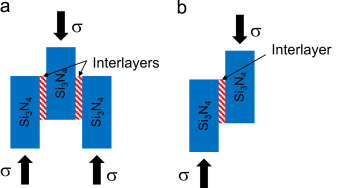
Silicon nitride/silicon nitride joints with refractory metal (W and Mo) interlayers were vacuum brazed using an active braze, Cu-ABA (Cu-3Si-2Al-2.25Ti, wt%), and two interlayer arrangements in a double-lap offset configuration: Si3N4/Cu-ABA/W/Cu-ABA/Mo/Cu-ABA/Si3N4 and Si3N4/Cu-ABA /Si3N4. Titanium segregated at the Si3N4/Cu-ABA and Mo/Cu-ABA interfaces, but not at the W/Cu-ABA interface. The room-temperature compression-shear strength values of Si3N4/Cu-ABA/Si3N4 and Si3N4/Cu-ABA/W/Cu-ABA/Mo/Cu-ABA/Si3N4 joints were 118 +/- 24 MPa and 22 +/- 5 MPa, respectively. Elevated-temperature compression tests showed that Si3N4/Cu-ABA/Si3N4 joints had strength of 31 +/- 6 MPa at 1023 K and 17 +/- 3 MPa at 1073 K. Likewise, Si3N4/Cu-ABA/W/Cu-ABA/Mo/Cu-ABA/Si3N4 joints had strength of 19 +/- 4 MPa at 1023 K and 13 +/- 3 MPa at 1073 K. Knoop microhardness profiles revealed hardness gradients across the joints. The effect of joint microstructure and test configuration on the mechanical behavior is discussed.
March, 2016 | DOI: 10.1016/j.ceramint.2015.12.087
Materiales de Diseño para la Energía y Medioambiente
Influence of temperature and time on the Eu3+ reaction with synthetic Na-Mica-n (n=2 and 4)
Garcia-Jimenez, MJ; Cota, A; Osuna, FJ; Pavon, E; Alba, MDChemical Engineering Journal, 284 (2016) 1174-1183
Show abstract ▽
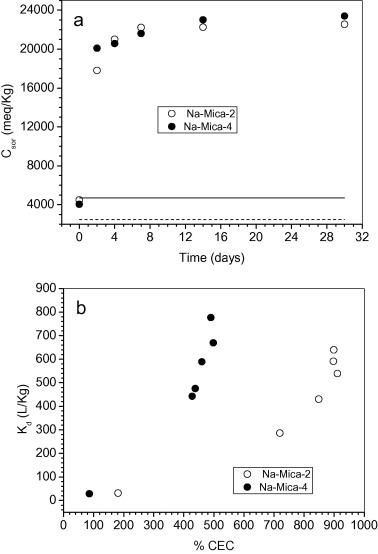
Bentonite is accepted as the best clay material for the engineered barrier of Deep Geological Repositories (DGRs). The performance of clay as the main component of the engineered barrier in the DGR has been intensively studied and the structure of the selected clay mineral play a crucial role. In this sense, a new family of synthetic swelling silicates, Na-Mica-n, with tuned layer charge (n) values between 2.0 and 4.0 per unit cell has recently been synthesized and a general synthetic method has been reported. These swelling high-charge micas could be highly valuable for the decontamination of harmful cations. The ability of these micas to immobilize Eu3+ under subcritical conditions has been probed. The adsorption was in both non-specific sites (cation exchange mechanism) and specific sites (chemical reaction or surface defects adsorption). Moreover, its adsorption capacity, under the same conditions is higher than in saponite and far superior to the bentonites.
January, 2016 | DOI: 10.1016/j.cej.2015.09.077
Materiales de Diseño para la Energía y Medioambiente
Thermal conductivity of partially graphitized biocarbon obtained by carbonization of medium-density fiberboard in the presence of a Ni-based catalyst
Orlova, TS; Parfen'eva, LS; Smirnov, BI; Gutierrez-Pardo, A; Ramirez-Rico, JPhysics of the Solid State, 58 (2016) 208-214
Show abstract ▽
The thermal conductivity k and resistivity rho of biocarbon matrices, prepared by carbonizing medium-density fiberboard at T (carb) = 850 and 1500A degrees C in the presence of a Ni-based catalyst (samples MDF-C( Ni)) and without a catalyst (samples MDF-C), have been measured for the first time in the temperature range of 5-300 K. X-ray diffraction analysis has revealed that the bulk graphite phase arises only at T (carb) = 1500A degrees C. It has been shown that the temperature dependences of the thermal conductivity of samples MDFC- 850 and MDF-C-850(Ni) in the range of 80-300 K are to each other and follow the law of k(T) similar to T (1.65), but the use of the Ni-catalyst leads to an increase in the thermal conductivity by a factor of approximately 1.5, due to the formation of a greater fraction of the nanocrystalline phase in the presence of the Ni-catalyst at T (carb) = 850A degrees C. In biocarbon MDF-C-1500 prepared without a catalyst, the dependence is k(T) similar to T (1.65), and it is controlled by the nanocrystalline phase. In MDF-C-1500(Ni), the bulk graphite phase formed increases the thermal conductivity by a factor of 1.5-2 compared to the thermal conductivity of MDF-C-1500 in the entire temperature range of 5-300 K; k(T = 300 K) reaches the values of similar to 10 W m(-1) K-1, characteristic of biocarbon obtained without a catalyst only at high temperatures of T (carb) = 2400A degrees C. It has been shown that MDF-C-1500(Ni) in the temperature range of 40aEuro'300 K is characterized by the dependence, k(T) similar to T (1.3), which can be described in terms of the model of partially graphitized biocarbon as a composite of an amorphous matrix with spherical inclusions of the graphite phase.
January, 2016 | DOI: 10.1134/S1063783416010236
2015
2015
Materiales de Diseño para la Energía y Medioambiente
Impact of hydrothermal treatment of FEBEX and MX80 bentonites in water, HNO3 and Lu(NO3)(3) media: Implications for radioactive waste control
Osuna, FJ; Chain, P; Cota, A; Pavon, E; Alba, MDApplied Clay Science, 118 (2015) 48-55
Show abstract ▽
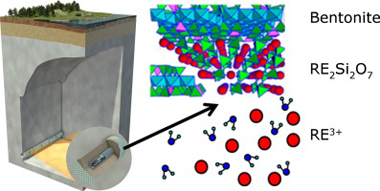
Engineered barriers of deep geological repositories (DGR) are commonly constructed with bentonite. FEBEX and MX80 bentonites have been selected by different countries as reference materials for the sealing of repositories; however, their chemical reactivity with high-level long-lived radioactive wastes (HLRW) under subcritical conditions had not been explored before. The hydrothermal stability in neutral and acid media and chemical reactivity in contact with an actinide analogous compound were both studied. The long-range and short-range structural changes were analyzed by X-ray diffraction, nuclear magnetic resonance and scanning electron microscopy. Both bentonites have exhibited a good stability in neutral and acid media and have generated a new phase immobilizing the actinide analogous compound. The extent of the chemical reaction is higher in MX80 bentonite than in FEBEX bentonite.
December, 2015 | DOI: 10.1016/j.clay.2015.08.036
Materiales de Diseño para la Energía y Medioambiente
Specific features of the electrical properties in partially graphitized porous biocarbons of beech wood
Popov, VV; Orlova, TS; Gutierrez-Pardo, A; Ramirez-Rico, JPhysics of the solid state, 57 (2015) 1746-1751
Show abstract ▽
The electrical and galvanomagnetic properties of partially graphitized highly porous bioC(Ni) biocarbon matrices produced by pyrolysis (carbonization) of beech wood at temperatures T (carb) = 850-1600A degrees C in the presence of a Ni-containing catalyst have been studied in comparison with their microstructural features. The temperature dependences of the resistivity, the magnetoresistance, and the Hall coefficient have been measured in the temperature range of 4.2-300 K in magnetic fields to 28 kOe. It has been shown that an additional graphite phase introduction into samples with T (carb) a parts per thousand yen 1000A degrees C results in an increase in the carrier mobility by a factor of 2-3, whereas the carrier (hole) concentration remains within similar to 10(20) cm(-3), as in biocarbons obtained without catalyst. An analysis of experimental data has demonstrated that the features of the conductivity and magnetoresistance of these samples are described by quantum corrections related to their structural features, i.e., the formation of a globular graphite phase of nano- and submicrometer sizes in the amorphous matrix. The quantum corrections to the conductivity decrease with increasing carbonization temperature, which indicates an increase in the degree of structure ordering and is in good agreement with microstructural data.
September, 2015 | DOI: 10.1134/S1063783415090280
Materiales de Diseño para la Energía y Medioambiente
Viability of adding gypsum and calcite for remediation of metal-contaminated soil: laboratory and pilot plant scales
Gonzalez-Nunez, R; Alba, MD; Vidal, M; Rigol, AInternational Journal of Environmental Science and Technology, 12 (2015) 2697-2710
Show abstract ▽
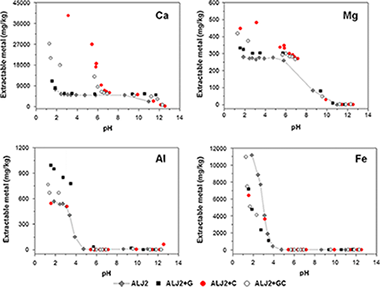
The effect of adding waste materials (gypsum and calcite) for the remediation of a soil contaminated by pyritic minerals was examined. Materials were characterised in terms of their acid neutralisation capacity (ANC), sorption capacity and structural components. Their effect on the contaminant leaching in soil + material mixtures over a wide range of pH was also evaluated. Results at laboratory and pilot plant scales were compared to account for the potential variability in the material efficiency when applied at larger scale. The use of gypsum permitted its valorisation, although calcite was a more effective amendment because its addition led to a greater increase in the pH and acid neutralisation capacity, and thus in the sorption capacity in the resulting soil + material mixture. In the same way, when the combination of gypsum + calcite was added to the soil, it led to an increase in the pH from 2.5 to 6.9 and in the ANC from −86 to 1,513 meq/kg. As a result, the concentration of extractable heavy metals and As was reduced, and they were successfully immobilised both at laboratory and at pilot plant scales. Thus, the use of these materials induced a significant reduction in the contaminant mobility and permitted the valorisation of waste materials.
August, 2015 | DOI: 10.1007/s13762-014-0671-3
Materiales de Diseño para la Energía y Medioambiente
Uranium immobilization by FEBEX bentonite and steel barriers in hydrothermal conditions
Villa-Alfageme, M; Hurtado, S; El Mrabet, S; Pazos, MC; Castro, MA; Alba, MDChemical Engineering Journal, 269 (2015) 279-287
Show abstract ▽
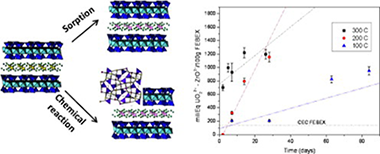
FEBEX clay is considered a reference material in engineered barriers for safe storage of nuclear waste and uranium is a minor component of high-level radioactive waste (HLRW) and a main component of the spent nuclear fuel (SNF). Here, the kinetics of reaction of uranium with FEBEX was investigated in addition to the uranium immobilisation ability and the structural analysis of the reaction products. Hydrothermal treatments were accomplished with UO22+ and tetravalent actinide simulator ZrO2+, also present in HLRW. The quantification of the reaction was performed through gamma spectrometry of uranium. Two mechanisms for UO22+ retention by FEBEX were detected: adsorption and formation of stable and insoluble new phases. The structural analyses performed using ZrO2+, confirmed the uranium adsorption and the presence of new phases, ZrO2 and Zr(SiO4), that emphasise the existence of a chemical reaction with the bentonite. The analysis of the velocity of reaction uranium-clay minerals revealed temperature dependence. An exponential fitting suggested that the removal of uranium from solution at temperatures over 200 °C could be completed in less than a year. For lower temperatures, several years are needed. Milliequivalents of UO22+ immobilised by the clay depended on temperature and time and were over cation exchange capacity (CEC) of FEBEX even at 100 °C (reaching 600% of CEC). The reaction with steel, also temperature dependent, was finally analysed. At 200 °C 40–70% of uranium reacted with steel. But only 30–15% reacted at 300 °C and 100 °C. The reactions provide a stable immobilisation mechanism for uranium even when its sorption and swelling capacities fail. Our experiments will be of particular interest for very deep borehole disposals were higher temperatures and pressures are expected.
June, 2015 | DOI: 10.1016/j.cej.2015.01.134
Materiales de Diseño para la Energía y Medioambiente
Self-Assembling of Tetradecylammonium Chain on Swelling High Charge Micas (Na-Mica-3 and Na-Mica-2): Effect of Alkylammonium Concentration and Mica Layer Charge
Pazos, MC; Cota, A; Osuna, FJ; Pavon, E; Alba, MDLangmuir, 31 (2015) 4394-4401
Show abstract ▽
A family of tetradecylammonium micas is synthesized using synthetic swelling micas with high layer charge (NanSi8-nAln,Mg6F4O20 center dot XH2O, where n = 2 and 3) exchanged with tetradecylammonium cations. The molecular arrangement of the surfactant is,elucidated on the basis of XRD patterns and DTA. The ordering conformation of the surfactant molecules into the interlayer space of Micas is investigated by IR/FT, C-13, Al-27, and Si-29 MAS NMR. The structural arrangement of the tetradecylammonium cation in the interlayer space of high-charge micas is more sensitive to the effect of the mica layer charge at high concentration. The surfactant arrangement is found to follow the bilayer-paraffin model for all values of layer charge and surfactant concentration. However, at initial concentration below the mica CEC, a lateral monolayer is also observed. The amount of ordered conformation all-trans is directly proportional to the layer charge and surfactant concentration.
April, 2015 | DOI: 10.1021/acs.langmuir.5b00224
Materiales de Diseño para la Energía y Medioambiente
Pectin-Lipid Self-Assembly: Influence on the Formation of Polyhydroxy Fatty Acids Nanoparticles
Guzman-Puyol, Susana; Jesus Benitez, Jose; Dominguez, Eva; Bayer, Ilker Sefik; Cingolani, Roberto; Athanassiou, Athanassia; Heredia, Antonio; Heredia-Guerrero, Jose AlejandroPLoS One, 10 (2015) e0124639
Show abstract ▽
Nanoparticles, named cutinsomes, have been prepared from aleuritic (9,10,16-trihidroxipalmitic) acid and tomato fruit cutin monomers (a mixture of mainly 9(10), 16-dihydroxypalmitic acid (85%, w/w) and 16-hydroxyhexadecanoic acid (7.5%, w/w)) with pectin in aqueous solution. The process of formation of the nanoparticles of aleuritic acid plus pectin has been monitored by UV-Vis spectrophotometry, while their chemical and morphological characterization was analyzed by ATR-FTIR, TEM, and non-contact AFM. The structure of these nanoparticles can be described as a lipid core with a pectin shell. Pectin facilitated the formation of nanoparticles, by inducing their aggregation in branched chains and favoring the condensation between lipid monomers. Also, pectin determined the self-assembly of cutinsomes on highly ordered pyrolytic graphite (HOPG) surfaces, causing their opening and forming interconnected structures. In the case of cutin monomers, the nanoparticles are fused, and the condensation of the hydroxy fatty acids is strongly affected by the presence of the polysaccharide. The interaction of pectin with polyhydroxylated fatty acids could be related to an initial step in the formation of the plant biopolyester cutin.
April, 2015 | DOI: 10.1371/journal.pone.0124639
Materiales de Diseño para la Energía y Medioambiente
Synthesis temperature effect on Na-Mica-4 crystallinity and heteroatom distribution
Naranjo, M; Castro, MA; Cota, A; Osuna, FJ; Pavon, E; Alba, MDMicroporous and Mesoporous Materials, 204 (2015) 282-288
Show abstract ▽
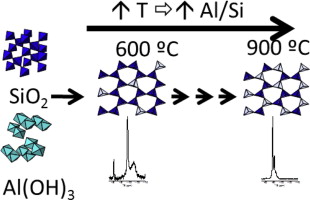
The discovery of swelling brittle mica, Na-Mica-4, has been one of the most significant advances in the pursuit for a material with high ion-exchange capacity. For technical applications, the control of the phase evolution during the synthesis is crucial. The main aim of this study was to investigate the effect of Na-Mica-4 synthesis temperature on the crystalline phase evolution, Si–Al distribution in the tetrahedral sheet, the Al occupancy between tetrahedral and octahedral sites and their effects on the interlayer space composition. The synthesis temperature range between 600 °C and 900 °C was explored. At low temperature (600 °C), the precursors were transformed in a low-charged swelling 2:1 phyllosilicate, saponite type, which was progressively aluminum enriched with temperature. The high-charged swelling mica was completely formed at 700 °C, although a minor anhydrous contribution remained up to 850 °C. Up to 800 °C, silicates and fluorides secondary phases were detected as a minor contribution.
March, 2015 | DOI: 10.1016/j.micromeso.2014.11.026
Materiales de Diseño para la Energía y Medioambiente
Sliding wear resistance of sintered SiC-fiber bonded ceramics
Vera, MC; Ramirez-Rico, J; Martinez-Fernandez, J; Singh, MInternational Journal of Refractory Metals & Hard Materials, 49 (2015) 232-239
Show abstract ▽
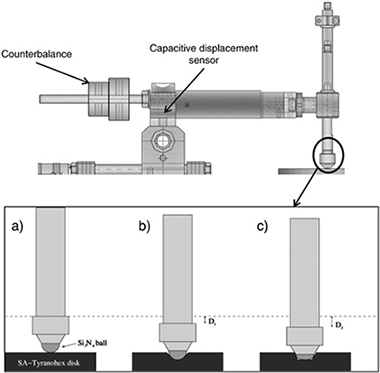
Advanced SiC-based ceramics and fiber reinforced composites are interesting materials for a wide variety of applications involving sliding wear conditions because of their excellent thermomechanical properties. The microstructure and wear resistance of sintered SiC fiber bonded ceramics (SA Tyrannohex) were studied. The material is composed of SiC-fibers in two orientations, with polygonal cross sections and cores having higher carbon content than their surroundings, as observed with SEM. A thin layer of C exists between the fibers. This layer has been found to be a turbostratic-layered structure oriented parallel to the fiber surface. XRD shows that the material is highly crystalline and composed mostly of β-SiC. Unlubricated wear behavior of the SA-Tyrannohex material when sliding against a Si3N4 ball in air at room temperature was evaluated. Experiments were performed using a pin on disk apparatus, under different normal loads of 2, 5 and 10 N at sliding speeds of 25, 50, 100 mm/s. A decrease of the friction coefficient with load was found due to the presence of the turbostratic carbon layer between the fibers. Wear rates of the order of 100 mm3/MJ were obtained, independently of sliding speed. Microfracture of the fibers is the main wear mechanism.
March, 2015 | DOI: 10.1016/j.ijrmhm.2014.06.020
Materiales de Diseño para la Energía y Medioambiente
Effect of catalytic graphitization on the electrochemical behavior of wood derived carbons for use in supercapacitors
Gutierrez-Pardo, A; Ramirez-Rico, J; Cabezas-Rodriguez, R; Martinez-Fernandez, JJournal of Power Sources, 278 (2015) 18-26
Show abstract ▽
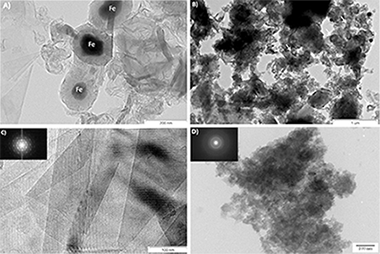
Porous graphitic carbons were successfully obtained from wood precursors through pyrolysis using a transition metal as catalyst. Once the catalyst is removed, the resulting material mimics the microstructure of the wood and presents high surface area, open and interconnected porosity and large pore volume, high crystallinity and good electrical conductivity, making these carbons interesting for electrochemical devices. Carbons obtained were studied as electrodes for supercapacitors in half cell experiments, obtaining high capacitance values in a basic media (up to 133 F g−1 at current densities of 20 mA g−1 and 35 F g−1 at current densities of 1 A g−1). Long-cycling experiments showed excellent stability of the electrodes with no reduction of the initial capacitance values after 1000 cycles in voltammetry.
March, 2015 | DOI: 10.1016/j.jpowsour.2014.12.030
Materiales de Diseño para la Energía y Medioambiente
Microstructure, elastic and inelastic properties of partially graphitized biomorphic carbons
Orlova, TS; Kardashev, BK; Smirnov, BI; Gutierrez-Pardo, A; Ramirez-Rico, J; Martinez-Fernandez, JPhysics of the Solid State, 57 (2015) 586-591
Show abstract ▽

The microstructural characteristics and amplitude dependences of the Young's modulus E and internal friction (logarithmic decrement delta) of biocarbon matrices prepared by beech wood carbonization at temperatures T (carb) = 850-1600A degrees C in the presence of a nickel-containing catalyst have been studied. Using X-ray diffraction and electron microscopy, it has been shown that the use of a nickel catalyst during carbonization results in a partial graphitization of biocarbons at T (carb) a parts per thousand yen 1000A degrees C: the graphite phase is formed as 50- to 100-nm globules at T (carb) = 1000A degrees C and as 0.5- to 3.0-mu m globules at T (carb) = 1600A degrees C. It has been found that the measured dependences E(T (carb)) and delta(T (carb)) contain three characteristic ranges of variations in the Young's modulus and logarithmic decrement with a change in the carbonization temperature: E increases and delta decreases in the ranges T (carb) < 1000A degrees C and T (carb) > 1300A degrees C; in the range 1000 < T (carb) < 1300A degrees C, E sharply decreases and delta increases. The observed behavior of E(T (carb)) and delta(T (carb)) for biocarbons carbonized in the presence of nickel correlates with the evolution of their microstructure. The largest values of E are obtained for samples with T (carb) = 1000 and 1600A degrees C. However, the samples with T (carb) = 1600A degrees C exhibit a higher susceptibility to microplasticity due to the presence of a globular graphite phase that is significantly larger in size and total volume.
March, 2015 | DOI: 10.1134/S106378341503018X
Materiales de Diseño para la Energía y Medioambiente
Sliding wear resistance of biomorphic SiC ceramics
Vera, MC; Ramirez-Rico, J; Martinez-Fernandez, J; Singh, MInternational Journal of Refractory Metals & Hard Materials, 49 (2015) 327-333
Show abstract ▽
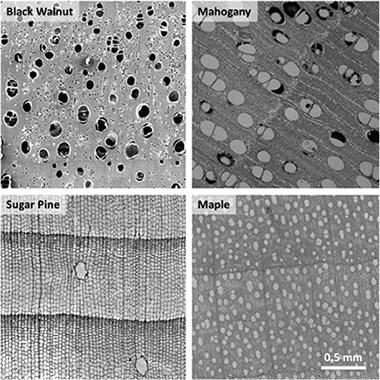
Biomorphic SiC ceramics were fabricated from four different wood precursors and their Knoop hardness and sliding wear resistance when sliding against a Si3N4 ball in air were studied. Tribological experiments were performed using a pin on disk apparatus, under normal loads of 2 and 5 N, at a sliding speed of 100 mm/s. The effects of specimen porosity and microstructure on measured wear were evaluated. A commercial sintered silicon carbide ceramic was also tested for comparison. Small differences in friction coefficient comparable to monolithic SiC ceramics were obtained. Several concurrent wear mechanisms are taking place: microfracture, plastic deformation in the Si phase and oxidation of the Si and/or SiC phase. The presence of an oxide tribolayer was assessed using fluorescence microscopy. Wear rates were found to scale with SiC content and depend on residual porosity in the composite.
March, 2015 | DOI: 10.1016/j.ijrmhm.2014.07.004
Materiales de Diseño para la Energía y Medioambiente
Polyester Films Obtained by Noncatalyzed Melt-Condensation Polymerization of Aleuritic (9,10,16-Trihydroxyhexadecanoic) Acid in Air
Benitez, JJ; Heredia-Guerrero, JA; Guzman-Puyol, S; Dominguez, E; Heredia, AJournal of Applied Polymer, 132 (2015) Art. 41328
Show abstract ▽
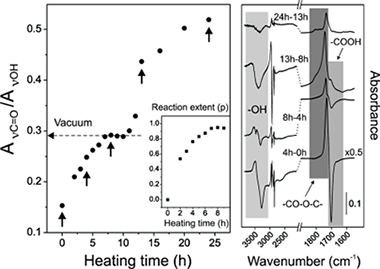
To mimic nontoxic and fully biodegradable biopolymers like the plant cutin, polyester films from a natural occurring fatty polyhydroxyacid like aleuritic (9,10,16-trihydroxyhexadecanoic) acid have been prepared by noncatalyzed melt-polycondensation at moderate temperature (150 degrees C) directly in air. The course of the reaction has been followed by infrared spectroscopy, C-13 magic angle spinning nuclear magnetic resonance spectroscopy, differential scanning calorimetry and X-ray diffraction and well differentiated stages are observed. First, a high conversion esterification reaction leads to an amorphous rubbery, infusible, and insoluble material whose structure is made out of ester linkages mostly involving primary hydroxyls and partially branched by minor esterification with secondary ones. Following the esterification stage, the cleavage of vicinal secondary hydroxyls and further oxidation to carboxylic acid is observed at the near surface region of films. New carboxylic groups created also undergo esterification and generate cross-linking points within the polymer structure. Additionally, and despite the harsh preparation conditions used, very little additional side reaction like peroxidation and dehydration are observed. Results demonstrate the feasibility of polyester films fabrication from a reference fatty polyhydroxyacid like aleuritic acid by noncatalyzed melt-polycondensation directly in air. The methodology can potentially be extended to similar natural occurring hydroxyacids to obtain films and coatings to be used, for instance, as nontoxic and biodegradable food packaging material.
February, 2015 | DOI: 10.1002/app.41328
Materiales de Diseño para la Energía y Medioambiente
Long-Chain Polyhydroxyesters from Natural Occurring Aleuritic Acid as Potential Material for Food Packaging
Benitez, JJ; Heredia-Guerrero, JA; Guzman-Puyol, S; Dominguez, E; Heredia, ASoft Materials, 13 (2015) 5-11
Show abstract ▽
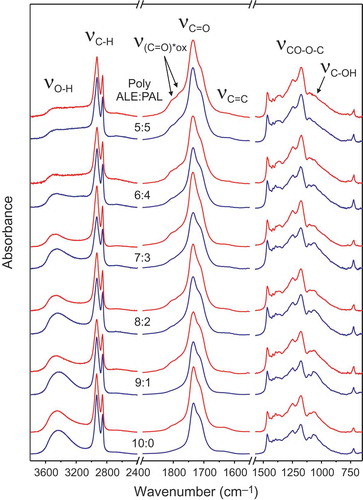
Fatty polyhydroxyesters (C≥16) are present in nature as barrier polymers like cutin in some protective tissues of higher plants. The mimicry of these biopolymers is regarded as a strategy to design nontoxic and fully biodegradable food packaging films and coatings. To obtain cutin inspired materials we have used a natural occurring polyhydroxylated monomer like aleuritic (9,10,16-trihydroxypalmitic) acid and a direct and scalable synthesis route consisting in the noncatalyzed melt-condensation polymerization in air. To reduce the number of hydroxyl groups and to increase hydrophobicity, palmitic acid has been used as a capping agent. Aleuritic-palmitic polyhydroxyesteres films have been obtained and characterized.
January, 2015 | DOI: 10.1080/1539445X.2014.993476
2014
2014
Materiales de Diseño para la Energía y Medioambiente
Ceramic Barrier Layers for Flexible Thin Film Solar Cells on Metallic Substrates: A Laboratory Scale Study for Process Optimization and Barrier Layer Properties
Delgado-Sanchez, JM; Guilera, N; Francesch, L; Alba, MD; Lopez, L; Sanchez, EACS Applied Materials & Interfaces, 6 (2014) 18543-18549
Show abstract ▽

Flexible thin film solar cells are an alternative to both utility-scale and building integrated photovoltaic installations. The fabrication of these devices over electrically conducting low-cost foils requires the deposition of dielectric barrier layers to flatten the substrate surface, provide electrical isolation between the substrate and the device, and avoid the diffusion of metal impurities during the relatively high temperatures required to deposit the rest of the solar cell device layers. The typical roughness of low-cost stainless-steel foils is in the hundred-nanometer range, which is comparable or larger than the thin film layers comprising the device and this may result in electrical shunts that decrease solar cell performance. This manuscript assesses the properties of different single-layer and bilayer structures containing ceramics inks formulations based on Al2O3, AlN, or Si3N4 nanoparticles and deposited over stainless-steel foils using a rotogravure printing process. The best control of the substrate roughness was achieved for bilayers of Al2O3 or AlN with mixed particle size, which reduced the roughness and prevented the diffusion of metals impurities but AlN bilayers exhibited as well the best electrical insulation properties.
November, 2014 | DOI: 10.1021/am504923z
Materiales de Diseño para la Energía y Medioambiente
Quantification and comparison of the reaction properties of FEBEX and MX-80 clays with saponite: Europium immobilisers under subcritical conditions
Villa-Alfageme, M; Hurtado, S; Castro, MA; El Mrabet, S; Orta, MM; Pazos, MC; Alba, MDApplied Clay Science, 101 (2014) 10-15
Show abstract ▽
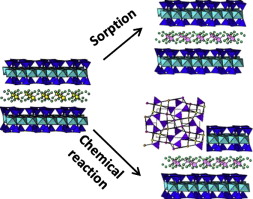
The evaluation of the retention mechanisms in FEBEX and MX-80 bentonites, selected as reference materials to construct engineered barriers, carries major implications in the safe storage of immobilisation capacity through a recently discovered chemical retention mechanism and the structural analysis of the reaction products. Hydrothermal treatments were accomplished with immobilisation capacity through a recently discovered chemical retention mechanism and the structural analysis of the reaction products. Hydrothermal treatments were accomplished with Eu(NO3)3 (151Eu and 153Eu, with 52.2% 153Eu) and spiked with radioactive 152Eu for the quantification of the reactions. Results were compared with saponite as the reference smectite. The strong dependence of the reaction parameters with temperature and time was quantified and the reaction velocity was evaluated. The velocity follows these trends: 240 days are needed for the total retention of europium for temperatures over 200 °C; below 150 °C, significantly longer reaction times, on the order of three years, are required to complete the reaction. Clays do not influence velocity rates, but the retention capacity of bentonites remains lower than for saponite. At 300 °C, the milliequivalents retained by the three clays are consistently over CEC. The structural analyses reveal not only adsorption of europium but also the presence of Eu(OH)3 precipitation and Eu2SiO3 confirming the existence of a chemical reaction.
November, 2014 | DOI: 10.1016/j.clay.2014.08.012
Materiales de Diseño para la Energía y Medioambiente
Enhanced activity of clays and its crucial role for the activity in ethylene polymerization
Camejo-Abreu, C; Tabernero, V; Alba, MD; Cuenca, T; Terreros, PJournal of Molecular Catalysis A-Chemical, 393 (2014) 96-104
Show abstract ▽
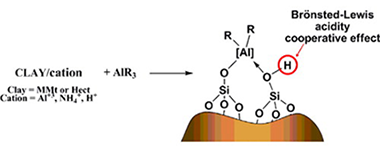
This paper presents a study of the effects of different treatments on the polymerization activity of modified clays as cocatalysts. To achieve this goal, an intercalating cation was introduced into two smectites and these clays were then modified with trimethyl aluminium. The results for ethylene polymerization, when a zirconocene complex was used as catalyst, and the structure analysis, allow us to obtain interesting deductions about the generation mode of the active species. All active materials employed as support activators presented aluminium in a pentahedral environment together with acidic hydrogen atoms. These two features were detected only after TMA treatment and they seem to be crucial elements in active cocatalyst generation. Moreover, a material without structural aluminium displayed the best activity pointing to the new aluminium species generated in the solid matrix as the determining factor for the activity. We proposed a synergic effect between Lewis acid aluminium centres and acidic Bronsted protons that generate the SiOHAl groups that activate the zirconium compound.
November, 2014 | DOI: 10.1016/j.molcata.2014.05.030
Materiales de Diseño para la Energía y Medioambiente
Characterization of porous graphitic monoliths from pyrolyzed wood
Gutierrez-Pardo, A; Ramirez-Rico, J; de Arellano-Lopez, AR; Martinez-Fernandez, JJournal of Materials Science, 49 (2014) 7688-7696
Show abstract ▽
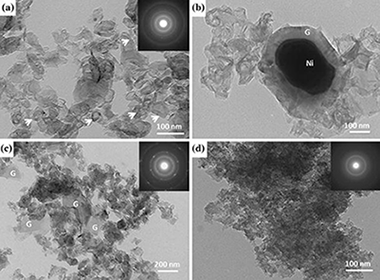
Porous graphitic carbons were obtained from wood precursors using Ni as a graphitization catalyst during pyrolysis. The structure of the resulting material retains that of the original wood precursors with highly aligned, hierarchical porosity. Thermal characterization was performed by means of thermogravimetry and differential scanning calorimetry, and the onset temperature for graphitization was determined to be similar to 900 A degrees C. Structural and microstructural characterization was performed by means of electron microscopy, electron and x-ray diffraction, and Raman spectroscopy. The effect of maximum pyrolysis temperature on the degree of graphitization was assessed. No significant temperature effect was detected by means of Raman scattering in the range of 1000-1400 A degrees C, but at temperatures over the melting point of the catalyst, the formation of graphite grains with long-range order was detected.
November, 2014 | DOI: 0.1007/s10853-014-8477-8
Materiales de Diseño para la Energía y Medioambiente
Direct evidence of Lowenstein's rule violation in swelling high-charge micas
Pavon, E; Osuna, FJ; Alba, MD; Delevoye, LChemical Communications, 53 (2014) 6984-6986
Show abstract ▽
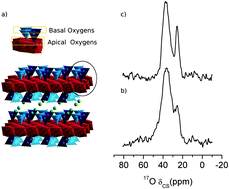
The structure of high-charged micas, Na-n-micas (n = 2 and 4), a family of synthetic silicates with a wide range of applications, was investigated through the use of 17O solid-state NMR at natural abundance in order to preserve quantitative spectral information. The use of a very high-field and highly sensitive probehead, together with 17O NMR literature data allowed for the detection of an isolated signal at 26 ppm, assigned partially to AlOAl, as evidence of the violation of Lowenstein's rule for Na-4-mica.
July, 2014 | DOI: 10.1039/C4CC01632G
Materiales de Diseño para la Energía y Medioambiente
Biomimetic polymers of plant cutin: an approach from molecular modeling
San-Miguel, MA; Oviedo, J; Heredia-Guerrero, JA; Heredia, A; Benitez, JJJournal of Molecular Modeling, 20 (2014) 2329
Show abstract ▽
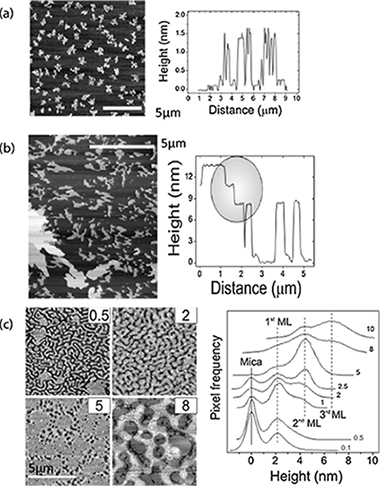
Biomimetics of materials is based on adopting and reproducing a model in nature with a well-defined functionality optimized through evolution. An example is barrier polymers that protect living tissues from the environment. The protecting layer of fruits, leaves, and non-lignified stems is the plant cuticle. The cuticle is a complex system in which the cutin is the main component. Cutin is a biopolyester made of polyhydroxylated carboxylic acids of 16 and 18 carbon atoms. The biosynthesis of cutin in plants is not well understood yet, but a direct chemical route involving the self-assembly of either molecules or molecular aggregates has been proposed. In this work, we present a combined study using experimental and simulation techniques on self-assembled layers of monomers selectively functionalized with hydroxyl groups. Our results demonstrate that the number and position of the hydroxyl groups are critical for the interaction between single molecules and the further rearrangement. Also, the presence of lateral hydroxyl groups reinforces lateral interactions and favors the bi-dimensional growth (2D), while terminal hydroxyl groups facilitate the formation of a second layer caused by head–tail interactions. The balance of 2D/3D growth is fundamental for the plant to create a protecting layer both large enough in 2D and thick enough in 3D.
July, 2014 | DOI: 10.1007/s00894-014-2329-y
Materiales de Diseño para la Energía y Medioambiente
Influence of the synthesis parameter on the interlayer and framework structure of lamellar octadecyltrimethylammonium kanemite
Corredor, JI; Cota, A; Pavon, E; Osuna, FJ; Alba, MDApplied Clay Science, 95 (2014) 9-17
Show abstract ▽
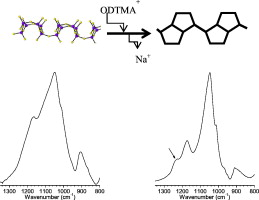
Inorganic–organic nanostructures, used as host materials for selective adsorption of functional molecules and as mesostructured material precursors, can be constructed by the interlayer modification of inorganic layered materials with surfactants. The formation mechanism is mainly determined by the surfactant assemblies in the 2D limited space. In this paper, a detailed structural analysis of the lamellar mesophases prepared from kanemite, a lamellar silicate, and octadecyltrimethylammonium (ODTMA) under various conditions was reported. The adsorbed amount of ODTMA and the long and short range structural orders were explored by TGA, XRD, IR/FT and MAS NMR spectroscopies. The results revealed that ODTMA molecules were efficiently intercalated in the interlayer space of kanemite and, in all synthesis conditions, an ordered lamellar structure was obtained. The ODTMA adsorption in kanemite caused changes not only in the interlayer space but also in the silicate framework, where five-member rings were formed. The characteristics of the final products were influenced by the synthesis conditions, although the separation mode, filtration or centrifugation, was not relevant. Therefore, the adsorption conditions of ODTMA in kanemite will contribute to the design of novel layered materials with potential environmental and technological use.
June, 2014 | DOI: 10.1016/j.clay.2014.02.030
Materiales de Diseño para la Energía y Medioambiente
Infrared and Raman spectroscopic features of plant cuticles: a review
Heredia-Guerrero, JA; Benitez, JJ; Dominguez, E; Bayer, IS; Cingolani, R; Athanassiou, A; Heredia, AFrontiers in Plant Science, 25 (2014)
Show abstract ▽
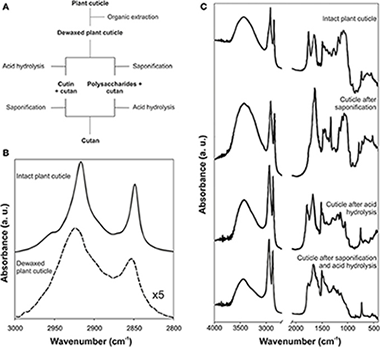
The cuticle is one of the most important plant barriers. It is an external and continuous lipid membrane that covers the surface of epidermal cells and whose main function is to prevent the massive loss of water. The spectroscopic characterization of the plant cuticle and its components (cutin, cutan, waxes, polysaccharides and phenolics) by infrared and Raman spectroscopies has provided significant advances in the knowledge of the functional groups present in the cuticular matrix and on their structural role, interaction and macromolecular arrangement. Additionally, these spectroscopies have been used in the study of cuticle interaction with exogenous molecules, degradation, distribution of components within the cuticle matrix, changes during growth and development and characterization of fossil plants.
June, 2014 | DOI: 10.3389/fpls.2014.00305
Materiales de Diseño para la Energía y Medioambiente
Biomechanical properties of the tomato (Solanum lycopersicum) fruit cuticle during development are modulated by changes in the relative amounts of its components
Espana, L; Heredia-Guerrero, JA; Segado, P; Benitez, JJ; Heredia, A; Dominguez, ENew Phytologist, 202 (3) (2014) 790-802
Show abstract ▽
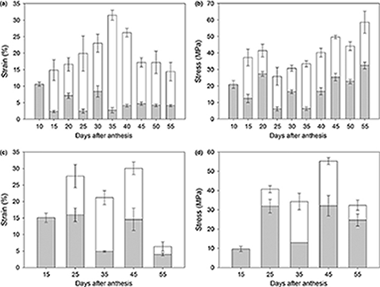
Keywords:
attenuated total reflectance–Fourier transform infrared (ATR-FTIR);biomechanics;cuticle;cutin;flavonoids;tomato (Solanum lycopersicum) fruit
Summary
- In this study, growth-dependent changes in the mechanical properties of the tomato (Solanum lycopersicum) cuticle during fruit development were investigated in two cultivars with different patterns of cuticle growth and accumulation.
- The mechanical properties were determined in uniaxial tensile tests using strips of isolated cuticles. Changes in the functional groups of the cuticle chemical components were analysed by attenuated total reflectance–Fourier transform infrared (ATR-FTIR).
- The early stages of fruit growth are characterized by an elastic cuticle, and viscoelastic behaviour only appeared at the beginning of cell enlargement. Changes in the cutin:polysaccharide ratio during development affected the strength required to achieve viscoelastic deformation. The increase in stiffness and decrease in extensibility during ripening, related to flavonoid accumulation, were accompanied by an increase in cutin depolymerization as a result of a reduction in the overall number of ester bonds.
- Quantitative changes in cuticle components influence the elastic/viscoelastic behaviour of the cuticle. The cutin:polysaccharide ratio modulates the stress required to permanently deform the cuticle and allow cell enlargement. Flavonoids stiffen the elastic phase and reduce permanent viscoelastic deformation. Ripening is accompanied by a chemical cleavage of cutin ester bonds. An infrared (IR) band related to phenolic accumulation can be used to monitor changes in the cutin esterification index.
May, 2014 | DOI: 10.1111/nph.12727
Materiales de Diseño para la Energía y Medioambiente
Thermal conductivity at the amorphous-nanocrystalline phase transition in beech wood biocarbon
Parfen'eva, LS; Orlova, TS; Smirnov, BI; Smirnov, IA; Misiorek, H; Jezowski, A; Ramirez-Rico, JPhysica of the Solid State, 56 (2014) 1071-1080
Show abstract ▽
High-porosity samples of beech wood biocarbon (BE-C) were prepared by pyrolysis at carbonization temperatures T carb = 650, 1300, and 1600°C, and their resistivity ρ and thermal conductivity κ were studied in the 5–300 and 80–300 K temperature intervals. The experimental results obtained were evaluated by invoking X-ray diffraction data and information on the temperature dependences ρ(T) and κ(T) for BE-C samples prepared at T carb = 800, 1000, and 2400°C, which were collected by the authors earlier. An analysis of the κ(T carb) behavior led to the conclusion that the samples under study undergo an amorphous-nanocrystalline phase transition in the interval 800°C < T carb < 1000°C. Evaluation of the electronic component of the thermal conductivity revealed that the Lorentz number of the sample prepared at T carb = 2400°C exceeds by far the classical Sommerfeld value, which is characteristic of metals and highly degenerate semiconductors.
May, 2014 | DOI: 10.1134/S1063783414050229
Materiales de Diseño para la Energía y Medioambiente
Effect of clays and metal containers in retaining Sm3+ and ZrO2+ and the process of reversibility
El Mrabet, S; Castro, MA; Hurtado, S; Orta, MM; Pazos, MC; Villa-Alfageme, M; Alba, MDAmerican Mineralogist, 99 (4) (2014) 696-703
Show abstract ▽
Knowledge and understanding about radionuclides retention processes on the materials composing the engineered barrier (clay mineral and metallic container waste) are required to ensure the safety and the long-term performance of radioactive waste disposal. Therefore, the present study focuses on the competitiveness of clay and the metallic container in the process of adsorption/desorption of the radionuclides simulators of Am3+ and UO22+. For this purpose, a comparative study of the interaction of samarium (chosen as chemical analog for trivalent americium) and zirconyl (as simulator of uranyl and tetravalent actinides) with both FEBEX bentonite and metallic container, under subcritical conditions, was carried out. The results revealed that the AISI-316L steel container, chemical composition detailed in Table 1, immobilized the high-radioactive waste (HRW), even during the corrosion process. The ZrO2+ was irreversibly adsorbed on the minireactor surface. In the case of samarium SEM/EDX analysis revealed the formation of an insoluble phase of samarium silicate on the container surface. There was no evidence of samarium diffusion through the metallic container. Samarium remained adsorbed by the container also after desorption experiment with water. Therefore, steel canister is actively involved in the HRW immobilization.
April, 2014 | DOI: 10.2138/am.2014.4665
Materiales de Diseño para la Energía y Medioambiente
A new route of synthesis of Na-Mica-4 from sodalite
Naranjo, M; Castro, MA; Cota, A; Pavon, E; Pazos, MC; Alba, MDMicroporous and Mesoporous Materials, 188 (2014) 176-180
Show abstract ▽
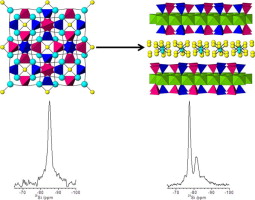
Synthesis of Na-Mica-4 has been achieved by a “mix and calcine” method using sodalite and magnesium fluoride as the only precursors. Previous research found sodalite as a key intermediate reaction product in the formation of Na-Mica-4 when the NaCl melt method was employed. Similarities in structure, chemical composition and cation distribution in products using the proposed method and the NaCl melt method are described and suggest that Na-Mica-4 is a very stable product. The use of sodalite as precursor provokes microporous formation in the final mica. The absence of excess Na leads to a lower particle size and to the presence of less impurity in the calcined product. Different sodalites could be used in the synthesis of different Na-Mica-4 with presumably different physicochemical properties.
March, 2014 | DOI: 10.1016/j.micromeso.2013.12.004
Materiales de Diseño para la Energía y Medioambiente
Effect of carbonization temperature on the microplasticity of wood-derived biocarbon
Shpeizman, VV; Orlova, TS; Kardashev, BK; Smirnov, BI; Gutierrez-Pardo, A; Ramirez-Rico, JPhysics of the Solid State, 56 (2014) 538-545
Show abstract ▽
The uniaxial compression strength under stepped loading and the 325-nm-stepped deformation rate of biocarbon samples obtained by carbonization of beech wood at different temperatures in the 600–1600°C range have been measured using high-precision interferometry. It has been shown that the strength depends on the content of nanocrystalline phase in biocarbon. The magnitude of deformation jumps at micro- and nanometer levels and their variation with a change in the structure of the material and loading time have been determined. For micro- and nanometer-scale jumps, standard deviations of the differences between the experimentally measured deformation rate at loading steps and its magnitude at the smoothed fitting curve have been calculated, and the correlation of the error with the deformation prior to destruction has been shown. The results obtained have been compared with the previously published data on measurements of the elastic properties and internal friction of these materials.
March, 2014 | DOI: 10.1134/S1063783414030305
Materiales de Diseño para la Energía y Medioambiente
New Bio-Ceramization Processes Applied to Vegetable Hierarchical Structures for Bone Regeneration: An Experimental Model in Sheep
Filardo, G; Kon, E; Tampieri, A; Cabezas-Rodriguez, R; Di Martino, A; Fini, M; Giavaresi, G; Lelli, M; Martinez-Fernandez, J; Martini, L; Ramirez-Rico, J; Salamanna, F; Sandri, M; Sprio, S; Marcacci, MTissue Engineering Part A, 20 (2014) 763-773
Show abstract ▽
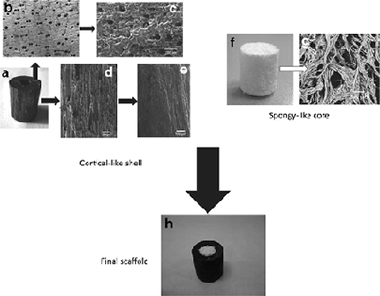
Bone loss is still a major problem in orthopedics. The purpose of this experimental study is to evaluate the safety and regenerative potential of a new scaffold based on a bio-ceramization process for bone regeneration in long diaphyseal defects in a sheep model. The scaffold was obtained by transformation of wood pieces into porous biomorphic silicon carbide (BioSiC®). The process enabled the maintenance of the original wood microstructure, thus exhibiting hierarchically organized porosity and high mechanical strength. To improve cell adhesion and osseointegration, the external surface of the hollow cylinder was made more bioactive by electrodeposition of a uniform layer of collagen fibers that were mineralized with biomimetic hydroxyapatite, whereas the internal part was filled with a bio-hybrid HA/collagen composite. The final scaffold was then implanted in the metatarsus of 15 crossbred (Merinos-Sarda) adult sheep, divided into 3 groups: scaffold alone, scaffold with platelet-rich plasma (PRP) augmentation, and scaffold with bone marrow stromal cells (BMSCs) added during implantation. Radiological analysis was performed at 4, 8, 12 weeks, and 4 months, when animals were sacrificed for the final radiological, histological, and histomorphometric evaluation. In all tested treatments, these analyses highlighted the presence of newly formed bone at the bone scaffolds' interface. Although a lack of substantial effect of PRP was demonstrated, the scaffold+BMSC augmentation showed the highest value of bone-to-implant contact and new bone growth inside the scaffold. The findings of this study suggest the potential of bio-ceramization processes applied to vegetable hierarchical structures for the production of wood-derived bone scaffolds, and document a suitable augmentation procedure in enhancing bone regeneration, particularly when combined with BMSCs.
February, 2014 | DOI: 10.1089/ten.tea.2013.0108
Materiales de Diseño para la Energía y Medioambiente
Competitive effect of the metallic canister and clay barrier on the sorption of Eu3+ under subcritical conditions
El Mrabet, S; Castro, MA; Hurtado, S; Orta, MM; Pazos, MC; Villa-Alfageme, M; Alba, MDApplied Geochemistry, 40 (2014) 25-31
Show abstract ▽
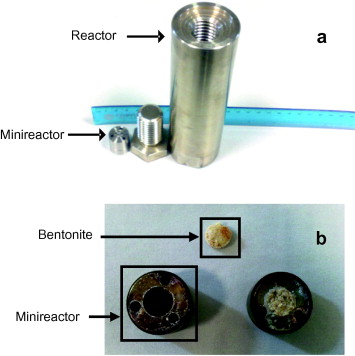
An in depth knowledge and understanding of high activity radionuclide (HLRW) immobilization processes on the materials composing the engineered barrier (clay and metallic canister) is required to ensure the safety and the long-term performance of radioactive waste disposal procedures. Therefore, the aim of this study was to understand the mechanisms involved in the retention of Eu3+ by two components of the multibarrier system, the bentonite barrier and the canister. As such, a comparative study of the interaction of trivalent Eu3+, used to simulate trivalent actinides, with both bentonite and a metallic canister has been undertaken in this work. To this end, we designed a minireactor into which the bentonite was introduced and compacted. The minireactor-bentonite system was then submitted to a hydrothermal reaction with a 7.9 × 10−2 M solution of Eu3+ at 300 °C for 4.5 days. SEM and XRD results revealed that both bentonite and the container were involved in the immobilization of europium by the formation of insoluble europium silicate phases. The presence of europium silicate adsorbed on the surface of the metallic canister indicates the competitive effect of both components of the engineered barrier (bentonite and metallic canister) in HLRW immobilization. These results suggested that the canister could play a role in the HLRW immobilization even during its corrosion process.
January, 2014 | DOI: j.apgeochem.2013.10.014
Materiales de Diseño para la Energía y Medioambiente
Interaction of Hydrated Cations with Mica-n (n = 2, 3 and 4) Surface
Pavon, E; Castro, MA; Cota, A; Osuna, FJ; Pazos, MC; Alba, MDJournal of Physical Chemistry C, 118 (2014) 2115-2121
Show abstract ▽
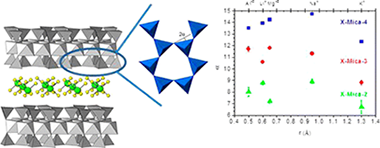
High charged swelling micas, with layer charge between 2 and 4, have been found to readily swell with water, and complete cation exchange (CEC) can be achieved. Because of their high CEC, applications like radioactive cation fixation or removal of heavy metal cations from wastewater were proposed. Their applicability can be controlled by the location of the interlayer cation in a confined space with a high electric field. In synthetic brittle micas, the interlayer cation has a low water coordination number; therefore, their coordination sphere would be completed by the basal oxygen of the tetrahedral layer as inner-sphere complexes (ISC). However, no direct evidence of these complexes formation in brittle micas has been reported yet. In this contribution, we mainly focus on the understanding the mechanisms that provoke the formation of ISC in high charge swelling micas, Mica-n. A whole series of cations (X) were used to explore the influence of the charge and size of the interlayer cation. Three brittle swelling micas, Mica-n (n = 4, 3 and 2), were selected in order to analyze the influence of the layer charge in the formation of ISC. The contribution of the ISC has been analyzed thorough the evolution of the 060 reflection and the changes in the short-range order of the tetrahedral cations will be followed 29Si and 27Al MAS NMR. The results showed that ISC was favored in X-Mica-4 and that provoked a high distortion angle between the Si–Al tetrahedra. When the content of aluminum decreases, the electrostatic forces between the layers are relaxed, and the hydrated cations did not interact so strongly with the tetrahedral sheet, having the opportunity to complete their hydration sphere.
January, 2014 | DOI: 10.1021/jp4110695
2013
2013
Materiales de Diseño para la Energía y Medioambiente
Modeling Macro-Sized, High Aspect Ratio Through-Hole Filling by Multi-Component Additive-Assisted Copper Electrodeposition
Childers, AS; Johnson, MT; Ramirez-Rico, J; Faber, KTJournal of the Electrochemical Society, 160 (2013) D3093-D3102
Show abstract ▽
A multi-element, time-dependent model is used to examine additive-assisted copper electroplating in macro-channels. This model is an adaptation of the work of Akolkar and Landau [J. Electrochem. Soc., 156, D351 (2009)], used to describe plating in micro-vias for integrated circuits. Using their method for describing species movement in the channel, the model has been expanded to include transport and adsorption limitations of the inhibitor and accelerator, as well as the copper ions in solution. The model is used to investigate copper plating as an infiltration method across many size scales and aspect ratios. Biomorphic graphite scaffolds produced from wood are used as a representative system and the results of a two-additive bath are used to characterize the behavior of the additives and determine the effectiveness of the plating. The results indicate that at macro-scales, channel dimensions play an increasingly important role in dictating the behavior of additive-assisted plating. Because additive systems are designed to establish differential surface coverage within the channel, the success of which is determined by the additive's rates of diffusion and adsorption, certain size scale/aspect ratio combinations preclude such coverage. A guide for sample geometries that may be successfully infiltrated with a two-additive bath is provided.
December, 2013 | DOI: 10.1149/2.018312jes
Materiales de Diseño para la Energía y Medioambiente
In situ imaging and strain determination during fracture in a SiC/SiC ceramic matrix composite
Ramirez-Rico, J; Stolzenburg, F; Almer, JD; Routbort, JL; Singh, D; Faber, KTScripta Materialia, 69 (2013) 497-500
Show abstract ▽
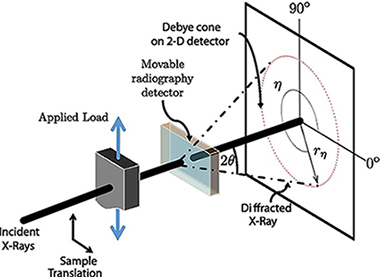
A combined imaging and microdiffraction technique using high-energy synchrotron X-rays is described and used to reveal microstructure, damage and strain evolution around notches in SiC/SiC composites. This technique allows for monitoring the material for cracks while loading and mapping the strain distribution in fibers and matrix with a resolution of tens of microns. We show that at current resolutions this technique is capable of measuring the strain distribution near crack tips in ceramic matrix composites and observe load transfer effects.
October, 2013 | DOI: 10.1016/j.scriptamat.2013.05.032
Materiales de Diseño para la Energía y Medioambiente
Thermal conductivity of wood-derived graphite and copper–graphite composites produced via electrodeposition
Johnson, MT; Childers, AS; Ramirez-Rico, J; Wang, H; Faber, KTComposites Part A: Applied Science and Manufaturing, 63 (2013) 182-189
Show abstract ▽
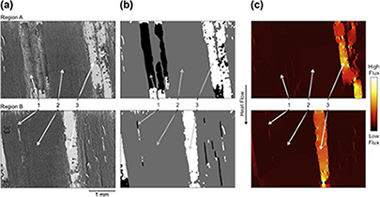
The thermal conductivity of wood-derived graphite and graphite/copper composites was studied both experimentally and using finite element analysis. The unique, naturally-derived, anisotropic porosity inherent to wood-derived carbon makes standard porosity-based approximations for thermal conductivity poor estimators. For this reason, a finite element technique which uses sample microstructure as model input was utilized to determine the conductivity of the carbon phase independent of porosity. Similar modeling techniques were also applied to carbon/copper composite microstructures and predicted conductivities compared well to those determined via experiment.
October, 2013 | DOI: 10.1016/j.compositesa.2013.06.009
Materiales de Diseño para la Energía y Medioambiente
Structure-mediated transition in the behavior of elastic and inelastic properties of beach tree bio-carbon
Kardashev, BK; Orlova, TS; Smirnov, BI; Gutierrez, A; Ramirez-Rico, JPhysics of the Solid State, 55 (2013) 1884-1891
Show abstract ▽
Microstructural characteristics and amplitude dependences of the Young modulus E and of internal friction (logarithmic decrement δ) of bio-carbon matrices prepared from beech tree wood at different carbonization temperatures T carb ranging from 600 to 1600°C have been studied. The dependences E(T carb) and δ(T carb) thus obtained revealed two linear regions of increase of the Young modulus and of decrease of the decrement with increasing carbonization temperature, namely, ΔE ∼ AΔT carb and Δδ ∼ BΔT carb, with A ≈ 13.4 MPa/K and B ≈ −2.2 × 10−6 K−1 for T carb < 1000°C and A ≈ 2.5 MPa/K and B ≈ −3.0 × 10−7 K−1 for T carb > 1000°C. The transition observed in the behavior of E(T carb) and δ(T carb) at T carb = 900–1000°C can be assigned to a change of sample microstructure, more specifically, a change in the ratio of the fractions of the amorphous matrix and of the nanocrystalline phase. For T carb < 1000°C, the elastic properties are governed primarily by the amorphous matrix, whereas for T carb > 1000°C the nanocrystalline phase plays the dominant part. The structurally induced transition in the behavior of the elastic and microplastic characteristics at a temperature close to 1000°C correlates with the variation of the physical properties, such as electrical conductivity, thermal conductivity, and thermopower, reported in the literature.
September, 2013 | DOI: 10.1134/S1063783413090151
Materiales de Diseño para la Energía y Medioambiente
Monolayer arrangement of fatty hydroxystearic acids on graphite: Influence of hydroxyl groups
Medina, S; Benitez, JJ; Castro, MA; Cerrillos, C; Millan, C; Alba, MDThin Solid Films, 539 (2013) 194-200
Show abstract ▽
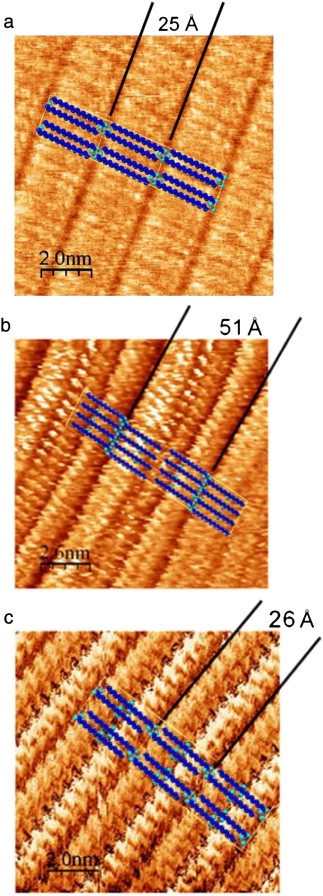
Previous studies have indicated that long-chain linear carboxylic acids form commensurate packed crystalline monolayers on graphite even at temperatures above their melting point. This study examines the effect on the monolayer formation and structure of adding one or more secondary hydroxyl, functional groups to the stearic acid skeleton (namely, 12-hydroxystearic and 9,10-dihydroxystearic acid). Moreover, a comparative study of the monolayer formation on recompressed and monocrystalline graphite has been performed through X-ray diffraction (XRD) and Scanning Tunneling Microscopy (STM), respectively. The Differential Scanning Calorimetry (DSC) and XRD data were used to confirm the formation of solid monolayers and XRD data have provided a detailed structural analysis of the monolayers in good correspondence with obtained STM images. DSC and XRD have demonstrated that, in stearic acid and 12-hydroxystearic acid adsorbed onto graphite, the monolayer melted at a higher temperature than the bulk form of the carboxylic acid. However, no difference was observed between the melting point of the monolayer and the bulk form for 9,10-dihydroxystearic acid adsorbed onto graphite. STM results indicated that all acids on the surface have a rectangular p2 monolayer structure, whose lattice parameters were uniaxially commensurate on the a-axis. This structure does not correlate with the initial structure of the pure compounds after dissolving, but it is conditioned to favor a) hydrogen bond formation between the carboxylic groups and b) formation of hydrogen bonds between secondary hydroxyl groups, if spatially permissible. Therefore, the presence of hydroxyl functional groups affects the secondary structure and behavior of stearic acid in the monolayer.
July, 2013 | DOI: 10.1016/j.tsf.2013.05.053
Materiales de Diseño para la Energía y Medioambiente
Evaluation of rare earth on layered silicates under subcritical conditions: Effect of the framework and interlayer space composition
Chain, P; Cota, A; El Mrabet, S; Pavon, E; Pazos, MC; Alba, MDChemical Geology, 347 (2013) 208-216
Show abstract ▽
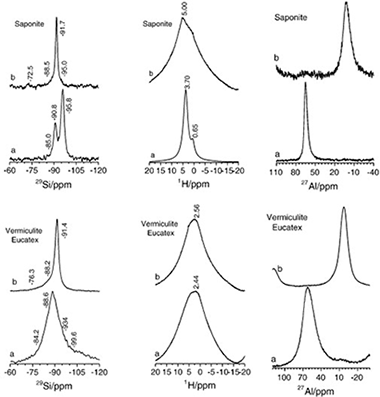
Clay-based minerals are considered to be an important component in backfill barriers due to both their ability to seal and adsorb radioactive waste and to interact chemically with it under subcritical conditions. Herein, we describe a systematic study of the properties of layered silicates that could affect their hydrothermal reactivity, namely type of layers, octahedral occupancy, origin and total amount of the layer charge, and nature of the interlayer cation. The silicates studied were selected on the basis of their different characteristics associated with these properties and were treated hydrothermally at 300 °C for 48 h in a 7.3 · 10− 2 M Lu(NO3)3 · 3.6H2O solution. The final products were analyzed by X-ray diffraction and solid-state NMR spectroscopy. All the layered silicates studied were found to be able to generate a Lu2Si2O7 phase after hydrothermal treatment under subcritical conditions, thereby confirming the participation of a chemical mechanism of the clay barrier generating phases being stables with temperature and pH conditions. However, the extent of this reaction depends to a large extent on the physicochemical properties of the framework and the interlayer space composition, such as the presence or absence of an octahedral sheet, the degree of occupancy of this sheet, and the origin and total layer charge. Therefore, this study allows tuning the clay mineral framework characteristic that favors the rare earth cations (as trivalent actinide simulator) immobilization.
June, 2013 | DOI: 10.1016/j.chemgeo.2013.03.006
Materiales de Diseño para la Energía y Medioambiente
Solution Properties of the System ZrSiO4–HfSiO4: A Computational and Experimental Study
Cota, Agustin; Burton, Benjamin P.; Chain, Pablo; Pavon, Esperanza; Alba, Maria D.Journal of Physical Chemistry C, 117 (2013) 10013-10019
Show abstract ▽
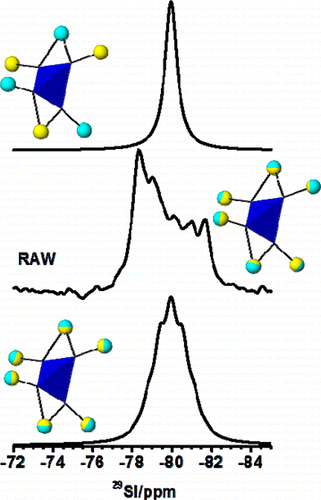
ZrSiO4 and HfSiO4 are of considerable interest because of their low thermal expansions, thermal conductivities, and the optical properties of HfSiO4. In addition, silicate phases of both are studied as model radioactive waste disposal materials. Previous first principles calculations reported near ideal mixing in the Zr1–xHfxSiO4 system, with a very weak propensity for phase separation. Density functional theory (DFT)/cluster-expansion first principles calculations presented in this work indicate near ideal mixing with a very weak propensity for ordering. Zr1–xHfxSiO4 samples (x = 0, 0.25, 0.5, 0.75, and 1.0) were synthesized from intimate stoichiometric mixtures of constituent-oxides and annealing at 1823 K for 20 days in a platinum crucible. Samples were characterized by X-ray diffraction (XRD; Rietveld analysis) and 29Si MAS NMR. The XRD data exhibited a pronounced negative deviation from Vegard’s law in the excess volume of mixing, and the 29Si MAS NMR spectra also suggest nonideal mixing. Given the very weak energetics that favor cation ordering, it is clear that there must be some other cause(s) for the observed deviations from ideal mixing behavior.
May, 2013 | DOI: 10.1021/jp401539g
Materiales de Diseño para la Energía y Medioambiente
Synthesis and characterization of kanemite from fluoride-containing media: Influence of the alkali cation
Corredor, JI; Cota, A; Pavon, E; Alba, MDAmerican Mineralogist, 98 (2013) 1000-1007
Show abstract ▽
Kanemite belongs to the group of naturally occurring sodium silicate minerals that was first found in Kanem, at the edge of the Lake Chad, and has been synthesized in different ways from NaOH-SiO2 mixtures and used as precursor for the design of microporous and mesoporous materials. The fluoride route to the synthesis of microporous materials is based on the substitution of OH− anions by fluoride anions, which may subsequently also play a mineralizing role, and gives rise to materials with higher hydrophobicity and thermal and hydrothermal stability. Moreover, F− plays an important role in the incorporation of framework heteroatoms, thereby affecting the activity of the final material. The aim of this study was to synthesize fluorokanemite using different synthetic routes and different F− source. The final product was characterized by a combination of methods that provided information regarding the incorporation of fluorine into the framework and the short- and long-range structural order of the fluorosilicate. Kanemite with water content close to ideal was obtained in all cases. The washing process was found to have no effect in the long- or short-range structural order of the layer framework, although it did affect the structure of the cation in the interlayer space of kanemite. The mineralizing agent therefore appears to be the key to the synthesis. Furthermore, it governs the resulting kanemite structure by controlling the formation of hydrogen bonds in the framework, and therefore the degree of lamellar structure condensation.
May, 2013 | DOI: 10.2138/am.2013.4372
Materiales de Diseño para la Energía y Medioambiente
Effects of thermal and mechanical treatments on montmorillonite homoionized with mono- and polyvalent cations: Insight into the surface and structural changes
Fernandez, M; Alba, MD; Sanchez, RMTColloids and Surfaces A: Physicochemical and Engineering Aspects, 423 (2013) 1-10
Show abstract ▽
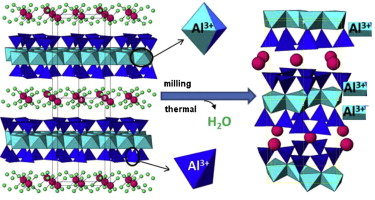
Smectite is a family of clay minerals that have important applications. In the majority of these clay minerals, the hydrated interlayer cations play a crucial role on the properties of the clay. Moreover, many studies have revealed that both thermal and grinding treatments affect the MMT structure and that interlayer cations play an important role in the degradation of the structure, primarily after mechanical treatment. In this study, the effects of these treatments on MMTs homoionized with mono (Na+, Li+ or K+) or polyvalent (Ca2+ or Al3+) cations were analyzed by the combination of a set of techniques that can reveal the difference of bulk phenomena from those produced on the surface of the particles. The thermal and mechanical (in an oscillating mill) treatments affected the framework composition and structure of the MMT, and the thermal treatment caused less drastic changes that the mechanical one. The effect of the interlayer cations is primarily due to the oxidation state and, to the size of the cations, which also influenced the disappearance of aluminum in the MMT tetrahedral sheet. These treatments caused a decrease in the surface area and an increase in the particle agglomeration and the isoelectric point. Both treatments caused the leaching of the framework aluminum. Furthermore, the mechanical treatment induced structural defects, such as the breakup of the particles, which favored the dehydroxylation and the increase of the isoelectric points of the montmorillonites.
April, 2013 | DOI: 10.1016/j.colsurfa.2013.01.040
Materiales de Diseño para la Energía y Medioambiente
Joining and interface characterization of in situ reinforced silicon nitride
Asthana, R; Singh, M; Martinez-Fernandez, JJournal of Alloys and Compounds, 552 (2013) 137-145
Show abstract ▽
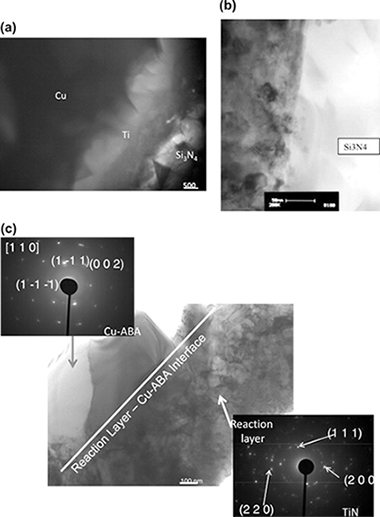
Copper-base active metal interlayers were used to bond in situ reinforced silicon nitride (Honeywell AS800) at 1317 K for 5 and 30 min in vacuum. The joints were characterized using scanning electron microscopy (SEM), energy dispersive spectroscopy (EDS), electron back scattered diffraction (EBSD), and transmission electron microscopy (TEM). A Ti-rich interaction zone (∼3.0–3.5 μm thick) formed at the Si3N4/braze interface. This reaction layer grew toward the inner part of the joint with a featureless microstructure, creating a strong bond. Regions of a Ti-rich phase were frequently found next to the reaction layer but surrounded by the Cu alloy. Extensive Ti and Si enrichments were noted at the interface but there was no evidence of interfacial segregation of Y, La, and Sr (from Y2O3, La2O3 and SrO, added as sintering aids). The reaction layer thickness and composition did not change when brazing time increased from 5 min to 30 min suggesting rapid growth kinetics in the early stages of reaction. The joints were crack-free and showed features associated with plastic deformation, which indicated that the metal interlayer accommodated strain associated with CTE mismatch. The inner part of the joint consisted of highly textured large grains of the braze alloy.
March, 2013 | DOI: 10.1016/j.jallcom.2012.09.104
Materiales de Diseño para la Energía y Medioambiente
Hydration properties of synthetic high-charge micas saturated with different cations: An experimental approach
Pavon, E; Castro, MA; Naranjo, M; Orta, MM; Pazos, MC; Alba, MDAmerican Mineralogist, 98 (2013) 394-400
Show abstract ▽
An understanding of the interaction mechanisms between exchangeable cations and layered silicates is of interest from both a basic and an applied point of view. Among 2:1 phyllosilicates, a new family of swelling high-charge synthetic micas has been shown to be potentially useful as decontaminant. However, the location of the interlayer cations, their acidity and the water structure in the interlayer space of these silicates are still unknown. The aim of this paper was therefore to study the hydration state of the interlayer cations in the interlayer space of high-charge expandable micas and to evaluate the effect that this hydration has on the swelling and acidity behavior of these new materials. To achieve these objectives, three synthetic micas with different charge density total layer charges (ranging between 2 and 4 per unit cell) and with five interlayer cations (Na+, Li+, K+, Mg2+, and Al3+) were synthesized and their hydration state, interlayer space, and acidity analyzed by DTA/TG, XRD, and 1H MAS NMR spectroscopy. The results showed that the hydration state depends on both the layer charge and the nature of the interlayer cation. A high participation of the inner-sphere complexes in the highly charged confined space has been inferred and proposed to induce Brønsted acidity in the solid.
March, 2013 | DOI: 10.2138/am.2013.4217
Materiales de Diseño para la Energía y Medioambiente
Heat capacity of Bio-SiC and SiC/Si ecoceramics prepared from white eucalyptus, beech, and sapele tree wood
Smirnov, IA; Smirnov, BI; Orlova, TS; Wlosewicz, D; Hackemer, A; Misiorek, H; Mucha, J; Jezowski, A; Ramirez-Rico, J; Martinez-Fernandez, JPhysics of the Solid State, 55 (2013) 454-460
Show abstract ▽
This paper reports on measurement of the heat capacity at constant pressure C p of silicon bio-carbide prepared within the 5–300 K temperature interval from beech tree wood (bio-SiC(BE)), and within 80–300 K, from tree wood of sapele (bio-SiC(SA)), as well as SiC/Si ecoceramics of beech, sapele, and white eucalyptus wood. It has been shown that in bio-SiC(BE) the measured heat capacity contains a significant contribution of surface heat capacity, whose magnitude decreases with increasing temperature. Of the ecoceramics, only SiC/Si(SA) characterized by a high enough porosity has revealed a small contribution to the heat capacity coming from its surface component. The experimental results obtained are discussed.
February, 2013 | DOI: 10.1134/S1063783413020285
Materiales de Diseño para la Energía y Medioambiente
Thermopower of Bio-SiC and SiC/Si ecoceramics prepared from sapele tree wood
Smirnov, IA; Smirnov, BI; Orlova, TS; Sulkovski, C; Misiorek, H; Muha, J; Jezowski, A; Ramirez-Rico, J; Martinez-Fernandez, JPhysics of the Solid State, 55 (2013) 54-59
Show abstract ▽
The thermopower coefficients of bio-SiC and SiC/Si ecoceramics prepared from sapele tree wood have been measured in the temperature interval 5–300 K. The measurements have been performed both along and perpendicular to empty (bio-SiC), as well as empty and partially silicon-filled (SiC/Si) channels in the samples. In bio-SiC, a contribution to thermopower associated with electron drag by phonons has been shown to exist within the temperature interval 5–200 (250) K. No such effect is realized in SiC/Si. This is assumed to derive from the presence in this material of heavily doped silicon embedded in SiC channels and the dominant part it plays in the behavior of the thermopower of this ceramics. The results obtained for the thermopower are compared with the available data for bio-SiC prepared from white eucalyptus tree wood and heavily doped bismuth.
February, 2013 | DOI: 10.1134/S1063783413010307
2012
2012
Materiales de Diseño para la Energía y Medioambiente
Chemical–physical characterization of isolated plant cuticles subjected to low-dose γ-irradiation
Heredia-Guerrero, Jose A; de Lara, Rocio; Dominguez, Eva; Heredia, Antonio; Benavente, Juana; Benitez, Jose JChemistry and physics of lipids, 165 (2012) 803-808
Show abstract ▽
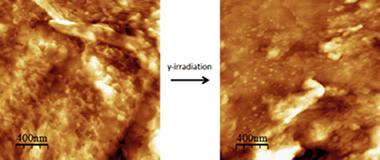
Isolated tomato fruit cuticles were subjected to low dose (80 Gy) γ-irradiation, as a potential methodology to prevent harvested fruit and vegetables spoilage. Both irradiated and non-irradiated samples have been morphologically and chemically characterized by scanning electron (SEM), atomic force (AFM), attenuated total reflectance Fourier transform infrared (ATR-FTIR) and X-ray photoelectron (XPS) spectroscopies. Additionally, electrochemical measurements comprising membrane potential and diffusive permeability were carried out to detect modifications in transport properties of the cuticle as the fruit primary protective membrane. It has been found that low dose γ-irradiation causes some textural changes on the surface but no significant chemical modification. Texture modification is found to be due to a partial removal of outermost (epicuticular) waxes which is accompanied by mild changes of electrochemical parameters such as the membrane fixed charge, cation transport number and salt permeability. The modification of such parameters indicates a slight reduction of the barrier properties of the cuticle upon low dose γ-irradiation.
December, 2012 | DOI: 10.1016/j.chemphyslip.2012.10.003
Materiales de Diseño para la Energía y Medioambiente
Effect of ytterbium doping on the microstructure and plastic deformation of BaCeO3 perovskite oxide
Jimenez-Melendo, M; Vaquero-Aguilar, C; Huaman-Mamani, FAFuel Processing Technology, 103 (2012) 146-150
Show abstract ▽
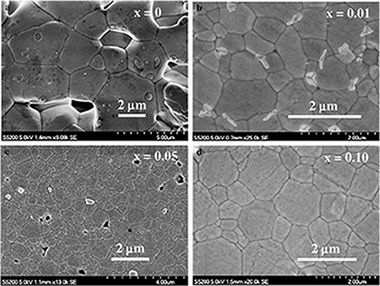
Trivalent cation-doped barium cerate perovskites are attractive materials for clean-energy applications, in particular solid oxide fuel cells, due to their singular proton conductivity in wet environments. Furthermore, these devices operate at high temperatures, where creep and other deformation processes determine the lifetime and overall performance. In this work, the structural and microstructural characteristics of undoped and ytterbium-doped (1 to 10 at.%) BaCeO 3 polycrystals produced by solid state reaction have been investigated. A single orthorhombic perovskite phase was found after sintering in air at 1500 °C for 10 h. The microstructure shows a complex evolution with doping: the average grain size firstly decreases with increasing Yb content up to 5 at.%, and then increases with further Yb additions. The high-temperature mechanical properties have been studied in compression between 1100 and 1250 °C in air at constant initial strain rate. The creep strength increases with increasing Yb content. Extended steady states of deformation were attained at lower strain rates and higher temperatures when increasing doping amount.
November, 2012 | DOI: 10.1016/j.fuproc.2011.10.005
Materiales de Diseño para la Energía y Medioambiente
Microstructural and high-temperature mechanical characteristics of nickel oxide/zirconia composites for solid oxide fuel cells
Oliva-Ramirez, M.; Huaman-Mamani, F. A.; Jimenez-Melendo, M.Fuel Processing Technology, 103 (2012) 45-50
Show abstract ▽
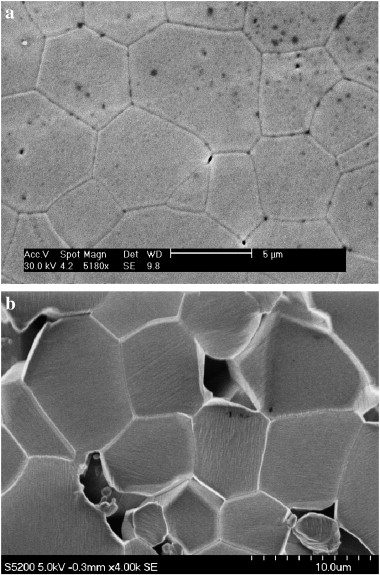
NiO/8YSZ (8 mol% Y 2O 3-stabilized ZrO 2) composites with different NiO contents (10, 20 and 40 mol%) have been fabricated by a conventional route of mechanical mixing of NiO and 8YSZ powders and sintering at 1500 °C for 10 h in air. The resulting microstructures have been characterized by electron microscopy. In 10 and 20 mol% NiO/8YSZ, the composite is formed by isolated NiO particles surrounded by zirconia matrix grains; this phase is interconnected in the 40 mol% NiO/8YSZ composite. Mechanical tests at constant strain rate and at constant load were conducted on these materials at temperatures of up to 1350 °C. Different behaviors were found depending on the percolation of the NiO phase. Microstructural observations after deformation are essential to understand the overall mechanical behavior of the composites.
November, 2012 | DOI: 10.1016/j.fuproc.2011.09.013
Materiales de Diseño para la Energía y Medioambiente
Creep strength of nickel oxide/zirconia composites under different environmental atmospheres
M. Jiménez-Melendo; F.A. Huamán-MamaniSolid State Ionics, 225 (2012) 471-475
Show abstract ▽
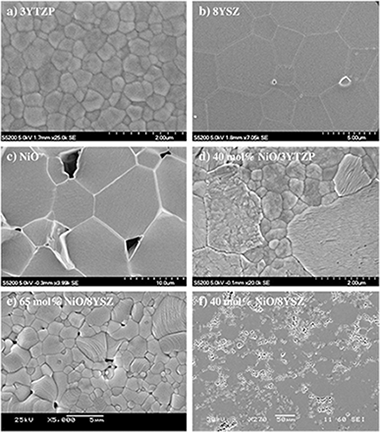
NiO/8YSZ (8 mol% Y2O3-stabilized cubic ZrO2) and NiO/3YTZP (3 mol% Y2O3-stabilized tetragonal ZrO2) composites with different NiO contents have been fabricated by a conventional route of mechanical mixing of NiO and zirconia powders and sintering at 1500 °C for 10 h in air. The resulting microstructures have been characterized by electron microscopy. The composites show a duplex microstructure formed by equiaxed grains of NiO and ZrO2, without any intermediate phase. Compressive mechanical tests at constant strain rate were carried out at temperatures between 1150 and 1350 °C under different environments: air, inert (Ar) and reducing (5% H2/95% Ar) atmospheres. The overall creep behavior of the composites is essentially controlled by the zirconia matrix, due to the softness of the NiO phase in the experimental conditions used in this study. The creep strength is not affected by oxygen partial pressure. However, a large decrease in creep resistance under reducing conditions was observed in samples submitted to in situ redox cycling.
October, 2012 | DOI: 10.1016/j.ssi.2012.02.011
Materiales de Diseño para la Energía y Medioambiente
High-temperature plastic deformation mechanisms of ytterbium-doped barium cerate proton conductor
M. Jiménez-MelendoSolid State Ionics, 225 (2012) 286-290
Show abstract ▽
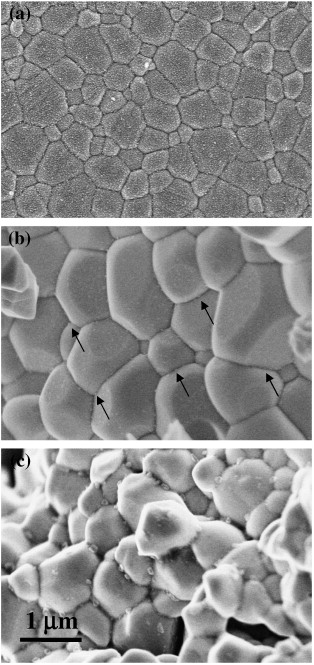
The enhanced proton conductivity exhibited by trivalent cation-doped barium cerate perovskites makes these materials excellent candidates for electrochemical applications, in particular as electrolytes for solid oxide fuel cells. These devices operate at elevated temperatures, where creep and other deformation processes influence the overall efficiency and lifetime. In this work, the high-temperature plastic deformation mechanisms of fine-grained 5 at.% Yb-doped BaCeO3 polycrystals produced by conventional solid-state reaction has been investigated by means of compressive tests at constant load between 1150 and 1250 °C in air. The creep curves show an unusual sigmoidal behavior, followed by extended steady states of deformation. Grain boundary sliding is the main deformation mechanism, characterized by a stress exponent n of 2, as found in other fine-grained superplastic ceramics and metals.
October, 2012 | DOI: 10.1016/j.ssi.2012.03.031
Materiales de Diseño para la Energía y Medioambiente
Electrical resistivity and thermal conductivity of SiC/Si ecoceramics prepared from sapele wood biocarbon
Parfen'eva, LS; Orlova, TS; Smirnov, BI; Smirnov, IA; Misiorek, H; Mucha, J; Jezowski, A; Pardo, AG; Rico, JRPhysics of the Solid State, 54 (2012) 2132-2141
Show abstract ▽
Samples of β-SiC/Si ecoceramics with a silicon concentration of ∼21 vol % have been prepared using a series of consecutive procedures (carbonization of sapele wood biocarbon, synthesis of high-porosity biocarbon with channel-type pores, infiltration of molten silicon into empty channels of the biocarbon, formation of β-SiC, and retention of residual silicon in channels of β-SiC). The electrical resistivity ρ and thermal conductivity κ of the β-SiC/Si ecoceramic samples have been measured in the temperature range 5–300 K. The values of ρ Si chan(T) and κ Si chan(T) have been determined for silicon Sichan located in β-SiC channels of the synthesized β-SiC/Si ecoceramics. Based on the performed analysis of the obtained results, the concentration of charge carriers (holes) in Sichan has been estimated as p ∼ 1019 cm−3. The factors that can be responsible for such a high value of p have been discussed. The prospects for practical application of β-SiC/Si ecoceramics have been considered.
October, 2012 | DOI: 10.1134/S1063783412100289
Materiales de Diseño para la Energía y Medioambiente
Microstructure and high-temperature mechanical behavior of melt-growth Al2O3/Er3Al5O12/ZrO2 ternary eutectic composites
Huaman-Mamani, FA; Jimenez-Melendo, M; Mesa, MC; Oliete, PBJournal of Alloys and Compounds, 536 (2012) S527-S531
Show abstract ▽
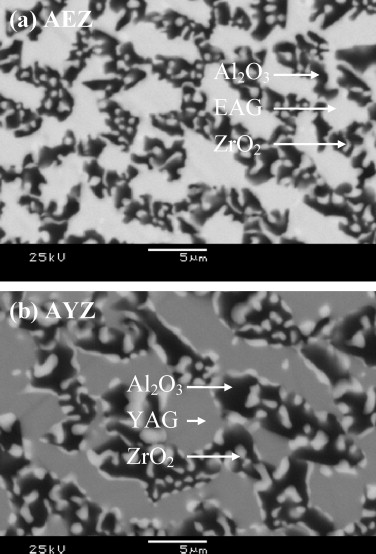
The microstructural and high-temperature mechanical characteristics of directionally solidified rods of Al2O3–Er3Al5O12–ZrO2 ternary eutectic oxides processed by the laser-heated floating zone method at different growth rates have been investigated. The eutectic microstructure displayed an entangled three-dimensional network of Al2O3 and Er3Al5O12 phases of similar sizes, elongated along the growth direction; the minority zirconia phase formed small fibers into the alumina phase. The interphase spacing is reduced with increasing solidification rate, changing about 2 μm down to 200 nm. These microstructural features are essentially the same exhibited by Al2O3–Y3Al5O12–ZrO2 composites processed by the same technique. Compressive deformation tests performed at 1400 °C at constant strain rate showed that the creep resistance decreased when increasing the growth rate due to the refinement of the microstructure.
September, 2012 | DOI: 10.1016/j.jallcom.2012.01.105
Materiales de Diseño para la Energía y Medioambiente
High-temperature mechanical characteristics of NiO/3YTZP composites
Jimenez-Melendo, M; Oliva-Ramirez, M; Huaman-Mamani, FAJournal of Alloys and Compounds, 536 (2012) S472-S476
Show abstract ▽
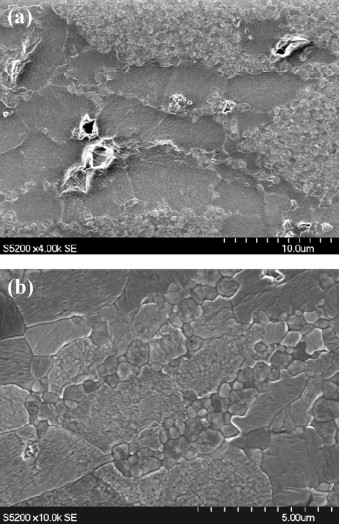
NiO/3YTZP (3 mol% Y2O3-stabilized tetragonal ZrO2) composites with 40 mol% NiO (26 vol% NiO) have been fabricated by mechanical mixing of NiO and 3YTZP powders and sintering at 1500 °C for 10 h in air. The resulting microstructures have been characterized by electron microscopy. Compressive mechanical tests at constant strain rate were conducted on these materials at temperatures between 1150 and 1350 °C in air. The σ–ɛ curves display extended secondary creep regimes without signals of macroscopic failure. The composite creep behavior is characterized by a stress exponent n = 2 and an activation energy for flow Q = 490 kJ/mol. The overall creep behavior of the composites is essentially controlled by the zirconia matrix, due to the softness of the NiO phase in the experimental conditions used in this study.
September, 2012 | DOI: 10.1016/j.jallcom.2011.11.040
Materiales de Diseño para la Energía y Medioambiente
Effects of the presence of Fe(0) on the sorption of lanthanum and lutetium mixtures in smectites
Galunin, E; Alba, MD; Santos, MJ; Vidal, MApplied Clay Science, 65-66 (2012) 162-172
Show abstract ▽
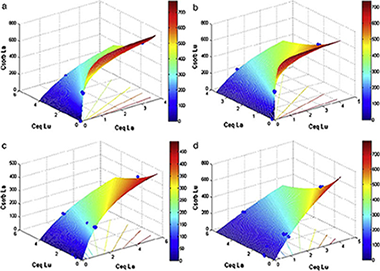
The sorption of La and Lu mixtures was examined in two bentonites after incubation for three months at 20 and 80 °C with Fe(0), as a laboratory approach to evaluate the effects of waste canister corrosion in a deep repository on the performance of clay engineered barriers. The sorption/desorption parameters were determined from batch tests in two ionic media: deionized water and, to consider the additional effect of cement leachates, 0.02 mol L− 1 Ca.
Results from XRD analyses showed the formation of crystalline FeO(OH), goethite, in a few samples and the degradation of the bentonites due to Fe(0) oxidation during incubation. Moreover, the EDX spectra showed that the lanthanides were sorbed primarily at smectite sites, although sorption onto goethite was also observed, whereas Fe(0) particles did not contribute to lanthanide sorption. The formation of goethite could explain the high Kd values measured in a few scenarios (e.g., those with single solutions or mixtures with the lowest initial concentration of the competitive lanthanide in which high affinity sites governed sorption), with up to 3-fold increases over the values obtained without Fe incubation. However, at higher lanthanide concentration, Kd values decreased or remained constant compared to the samples without Fe incubation, which could be explained by bentonite degradation. In the Ca medium, as much as 5 times lower Kd values were obtained, because of the competitive effect of the Ca ions, especially for Lu in the MX80 bentonite. This indicated that the small number of high affinity sites had been diminished.
The sorption data were satisfactorily fitted to a two-solute Langmuir model. In addition, Kd values correlated well with desorption data, which showed that the larger the decrease in Kd, the larger the increase in sorption reversibility. It is suggested that corrosion products from the metal canister might compromise the long-term radionuclide retention of the clay-engineered barriers.
September, 2012 | DOI: 10.1016/j.clay.2012.06.011
Materiales de Diseño para la Energía y Medioambiente
Biomimetic mineralization of calcium phosphate on a functionalized porous silicon carbide biomaterial
Dey, A; van den Hoogen, CJ; Rosso, M; Lousberg, N; Hendrix, MMRM; Friedrich, H; Ramirez-Rico, J; Zuilhof, H; de With, G; Sommerdijk, NAJMChemPlusChem, 77 (2012) 694-699
Show abstract ▽

Porous biomorphic silicon carbide (bioSiC) is a structurally realistic, high-strength, and biocompatible material which is promising for application in load-bearing implants. The deposition of an osteoconductive coating is essential for further improvement of its integration with the surrounding tissue. A new strategy towards biomimetic calcium phosphate coatings on bioSiC is described. X-ray photoelectron spectroscopy (XPS) analysis shows that using 10-undecenoic acid methyl ester a covalently bound monolayer can be synthesized on the surface of the bioSiC. After hydrolysis it exposes carboxylic acid groups that promote the selective nucleation and growth of a very well-defined crystalline layer of calcium phosphate. The resulting calcium phosphate coating is characterized by X-ray diffraction and electron microscopy techniques. Further, ion beam imaging is employed to quantify the mineral deposition meanwhile, three-dimensional dual-beam imaging (FIB/SEM) is used to visualize the bioSiC/mineral interface. The monolayer is show to actively induce the nucleation of a well-defined and highly crystalline mixed octacalcium phosphate/hydroxyapatite (OCP/HAP) coating on implantable bioSiC substrates with complex geometry. The mild biomimetic procedure, in principle, allows for the inclusion of bioactive compounds that aid in tissue regeneration. Moreover, the mixed OCP/HAP phase will have a higher solubility compared to HAP, which, in combination with its porous structure, is expected to render the coating more reabsorbable than standard HAP coatings.
August, 2012 | DOI: http://onlinelibrary.wiley.com/doi/10.1002/cplu.201200118/full
Materiales de Diseño para la Energía y Medioambiente
Thermal conductivity of high-porosity heavily doped biomorphic silicon carbide prepared from sapele wood biocarbon
Parfen'eva, LS; Orlova, TS; Smirnov, BI; Smirnov, IA; Misiorek, H; Mucha, J; Jezowski, A; Cabezas-Rodriguez, R; Ramirez-Rico, JPhysics of the Solid State, 54 (2012) 1732-1739
Show abstract ▽
The electrical resistivity and thermal conductivity of high-porosity (~52 vol %, channel-type pores) bio-SiC samples prepared from sapele wood biocarbon templates have been measured in the temperature range 5-300 K. An analysis has been made of the obtained results in comparison with the data for bio-SiC samples based on beech and eucalyptus, as well as for polycrystalline β-SiC. The conclusion has been drawn that the electrical resistivity and thermal conductivity of bio-SiC samples based on natural wood are typical of heavily doped polycrystalline β-SiC.
August, 2012 | DOI: 10.1134/S1063783412080240
Materiales de Diseño para la Energía y Medioambiente
Synthetic high-charge organomica: Effect of the layer charge and alkyl chain length on the structure of the adsorbed surfactants
Pazos, MC; Castro, MA; Orta, MM; Pavon, E; Rios, JSV; Alba, MDLangmuir, 28 (2012) 7325-7332
Show abstract ▽
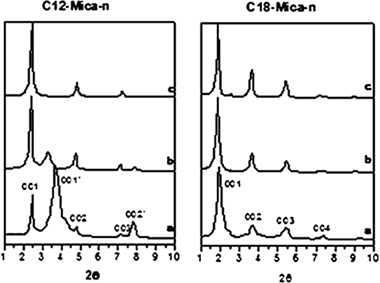
A family of organomicas was synthesized using synthetic swelling micas with high layer charge (NanSi8-nAlnMg6F4O20 center dot XH2O, where n = 2, 3, and 4) exchanged with dodecylammonium and octadecylammonium cations. The molecular arrangement of the surfactant was elucidated on the basis on XRD patterns and DTA. The ordering conformation of the surfactant molecules into the interlayer space of micas was investigated by C-13, Al-27, and Si-29 MAS NMR The arrangement of alkylammonium ions in these high-charge synthetic micas depends on the combined effects of the layer charge of the mica and the chain length of the cation. In the organomicas with dodecylammonium, a transition from a parallel layer to a bilayer-paraffin arrangement is observed when the layer charge of the mica increases. However, when octadecylammonium is the interlayer cation, the molecular arrangement of the surfactant was found to follow the bilayer-paraffin model for all values of layer charge. The amount of ordered conformation all-trans is directly proportional of layer charge.
May, 2012 | DOI: 10.1021/la300153e
Materiales de Diseño para la Energía y Medioambiente
Interfacial characterization of silicon nitride/silicon nitride joints brazed using Cu-base active metal interlayers
Singh, M; Fernandez, JM; Asthana, R; Rico, JRCeramics Intenational, 38 (2012) 2793-2802
Show abstract ▽
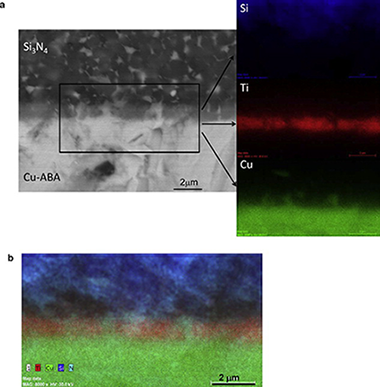
Silicon nitride/silicon nitride joints were vacuum brazed at 1317 K for 5 min and 30 min using ductile Cu-base active metal interlayers. The joints were characterized using scanning electron microscopy (SEM), energy dispersive spectroscopy (EDS), electron back scattered diffraction (EBSD), and transmission electron microscopy (TEM). An inhomogeneous Ti-rich reaction layer (similar to 2-3 mu m thick) formed in 5 min at the Si3N4/braze interface. The inhomogeneity disappeared after brazing for 30 min and was replaced with a compact and featureless reaction zone. TEM studies revealed fine grains in the reaction layer, and larger grains in the inner part of the joint interfaces. The joints were crack-free and presented features associated with plastic deformation, which indicated accommodation of strain associated with CTE mismatch. Electron Backscatter diffraction (EBSD) revealed a highly textured braze alloy interlayer and its crystallographic orientation was determined. The formation of additional phases at the joint interface during brazing is discussed.
May, 2012 | DOI: 10.1016/j.ceramint.2011.11.050
Materiales de Diseño para la Energía y Medioambiente
Remediation of metal-contaminated soils with the addition of materials - Part II: Leaching tests to evaluate the efficiency of materials in the remediation of contaminated soils
Gonzalez-Nunez, R; Alba, MD; Orta, MM; Vidal, M; Rigol, AChemosphere, 87 (2012) 829-837
Show abstract ▽
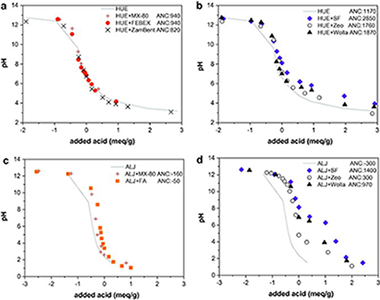
The effect of the addition of materials on the leaching pattern of As and metals (Cu, Zn, Ni, Pb, and Cd) in two contaminated soils was investigated. The examined materials included bentonites, silicates and industrial wastes, such as sugar foam, fly ashes and a material originated from the zeolitization of fly ash. Soil + material mixtures were prepared at 10% doses. Changes in the acid neutralization capacity, crystalline phases and contaminant leaching over a wide range of pHs were examined by using pHstat leaching tests. Sugar foam, the zeolitic material and MX-80 bentonite produced the greatest decrease in the leaching of pollutants due to an increase in the pH and/or the sorption capacity in the resulting mixture. This finding suggests that soil remediation may be a feasible option for the reuse of non-hazardous wastes.
May, 2012 | DOI: 10.1016/j.chemosphere.2012.01.015
Materiales de Diseño para la Energía y Medioambiente
Residual stresses in Al2O3-ZrO 2 (3mol.% Y2O3) directionally solidified eutectic ceramics as a function of temperature
Ramirez-Rico, J; Martinez-Fernandez, J; Pena, JI; Singh, D; Routbort, JMaterials Science and Engineering A, 541 (2012) 61-66
Show abstract ▽
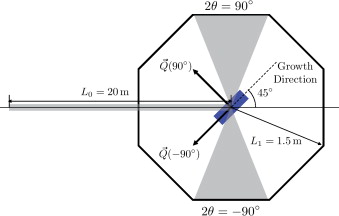
Directionally solidified eutectics are in situ composites grown from the melt. Due to the differences in the thermoelastic properties of the different phases present in the material, these composites often exhibit residual stresses that can affect their mechanical properties. In this work we use neutron diffraction to investigate residual stresses in Al 2O 3-ZrO 2 eutectic composites as a function of temperature, for samples processed at two different growth rates, 10mm/h and 750mm/h. Our results show that the stress-free temperature is in the range of 1200±200°C. We explain the experimental observations based on the thermoelastic properties of the phases in the material and confirm our measurements using a simple, self-consistent model.
April, 2012 | DOI: 10.1016/j.msea.2012.02.001
Materiales de Diseño para la Energía y Medioambiente
Electrostatic Induced Molecular Tilting in Self-Assembled Monolayers of n-Octadecylamine on Mica
Oviedo, J; San-Miguel, MA; Heredia-Guerrero, JA; Benitez, JJJournal of Physical Chemistry C, 116 (2012) 7099-7105
Show abstract ▽
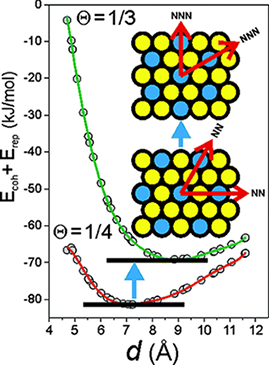
Self-assembled monolayers of n-octadecylamine on mica (ODA/mica SAMs) have been investigated by atomic force microscopy (AFM) and by attenuated total reflectance infrared (ATR-FTIR) and X-ray photoelectron (XPS) spectroscopies. Topographic data characterizes a stable configuration with the alkyl skeleton tilted approximate to 46 degrees from the surface normal that is rationalized according to a well established structural alkyl chain packing model. Extended contact with air increases molecular tilting up to approximate to 58 degrees. ATR-FTIR and XPS reveal the presence of protonated amino groups within the monolayer and its increment upon exposure to air. The transition between both tilted states is explained assuming the protonation reaction as the driving force and introducing a model to evaluate an electrostatic repulsions term in the overall cohesive energy balance of the system. ODA molecules in the self-assembled monolayer respond to their spontaneous protonation by atmospheric water by tilting as a mechanism to relax the repulsions between -NH3+ heads.
March, 2012 | DOI: 10.1021/jp300829g
Materiales de Diseño para la Energía y Medioambiente
Effect of oxidation on the compressive strength of sintered SiC-fiber bonded ceramics
Ramirez-Rico, J; Martinez-Fernandez, J; Singh, MMaterials Science and Engineering A, 534 (2012) 394-399
Show abstract ▽
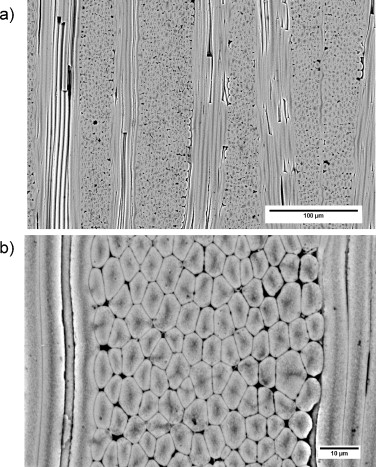
The compressive strength of SiC-fiber bonded ceramics obtained from hot-pressed amorphous Si-Al-C-O fibers and its degradation by high temperature exposure to an oxidizing environment was studied. Compressive strength was measured at room temperature as a function of strain rate, orientation, and oxidation temperature. Weight loss was monitored as a function of exposure time in atmospheric air at temperatures ranging from 800 to 1600°C, for times ranging from 0.5 to 5. h. Room-temperature compressive strength had a moderate decrease after exposures at 800°C associated to carbon burnout; increased for exposures in the range 1000-1500°C due to a defect-blunting action of the silica scale; and decreased significantly at 1600°C due to extensive surface recession.
February, 2012 | DOI: 10.1016/j.msea.2011.11.085
2011
2011
Materiales de Diseño para la Energía y Medioambiente
Structure, Electrical Resistivity, and Thermal Conductivity of Beech Wood Biocarbon Produced at Carbonization Temperatures below 1000 degrees C
Parfen'eva, LS; Orlova, TS; Kartenko, NF; Smirnov, BI; Smirnov, IA; Misiorek, H; Jezowski, A; Muha, J; Vera, MCPhysics of the Solid State, 53 (2011) 2398-2407
Show abstract ▽
This paper reports on measurements of the thermal conductivity. and the electrical resistivity. in the temperature range 5-300 K, and, at 300 K, on X-ray diffraction studies of high-porosity (with a channel pore volume fraction of similar to 47 vol %) of the beech wood biocarbon prepared by pyrolysis (carbonization) of tree wood in an argon flow at the carbonization temperature T(carb) = 800 degrees C. It has been shown that the biocarbon template of the samples studied represents essentially a nanocomposite made up of amorphous carbon and nanocrystallites-"graphite fragments" and graphene layers. The sizes of the nanocrystallites forming these nanocomposites have been determined. The dependences rho(T) and kappa(T) have been measured for the samples cut along and perpendicular to the tree growth direction, thus permitting determination of the magnitude of the anisotropy of these parameters. The dependences rho(T) and kappa(T), which have been obtained for beech biocarbon samples prepared at T(carb) = 800 degrees C, are compared with the data amassed by us earlier for samples fabricated at T(carb) = 1000 and 2400 degrees C. The magnitude and temperature dependence of the phonon thermal conductivity of the nanocomposite making up the beech biocarbon template at T(carb) = 800 degrees C have been found.
November, 2011 | DOI: 10.1134/S1063783411110230
Materiales de Diseño para la Energía y Medioambiente
Application of the solid state NMR to the study of the alcohol/alkane mixtures adsorption onto graphite
María D. Alba, Miguel A. Castro, Stuart M. Clarke, Santiago Medina, Loic Messe, Carmen MillánSolid State Nuclear Magnetic Resonance, 40 (2011) 138-143
Show abstract ▽

The mixing of molecules adsorbed from solution to different interfaces has both industrial and academic relevance and the mixing behaviour at the interface is a key to understanding for example, that the surface tension of a mixture of two surfactants is lower than either of the two pure materials and many other effects. In this paper, we report, for the first time, the application of Solid State NMR to the study of alkane/alcohol mixtures, in a range of relative size ratio between 0 and 0.35, adsorbed onto graphite at high, multilayer coverage. Moreover, this paper evaluated, for the first time, the utility of the combined used of 1H and 2H NMR for: (i) determining the surface composition and (ii) making a theoretical approach to the sorption isotherm. A variety of preferential adsorption behaviour is reported. Preferential adsorption of the longer molecule (decane vs. heptanol) from a mixture has been observed. However, if both components are of similar length, the alcohol is preferentially adsorbed (heptanol vs. octane and octanol vs. octane). Finally, a linear relation between the relative size ratio and the amount of alcohol at monolayer coverage is observed.
November, 2011 | DOI: 10.1016/j.ssnmr.2011.11.002
Materiales de Diseño para la Energía y Medioambiente
Remediation of metal-contaminated soils with the addition of materials – Part I: Characterization and viability studies for the selection of non-hazardous waste materials and silicates
R. González-Núñez, M.D. Alba, M.M. Orta, M. Vidal, A. RigolChemosphere, 85 (2011) 1511-1517
Show abstract ▽
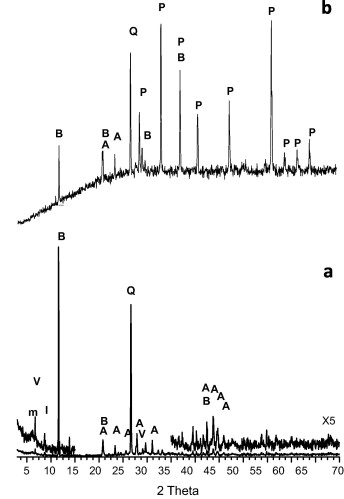
Contamination episodes in soils require interventions to attenuate their impact. These actions are often based on the addition of materials to increase contaminant retention in the soil and to dilute the contaminant concentration. Here, non-hazardous wastes (such as sugar foam, fly ash and a material produced by the zeolitization of fly ash) and silicates (including bentonites) were tested and fully characterized in the laboratory to select suitable materials for remediating metal-contaminated soils. Data from X-ray fluorescence (XRF), N2 adsorption/desorption isotherms, X-ray diffraction (XRD) and scanning electron microscopy/energy-dispersive X-ray spectroscopy (SEM–EDX) analyses revealed the chemical composition, specific surface area and the phases appearing in the materials. A pH titration test allowed the calculation of their acid neutralization capacity (ANC). The metal sorption and desorption capacities of the waste materials and silicates were also estimated. Sugar foam, fly ash and the zeolitic material were the best candidate materials. Sugar foam was selected because of its high ANC (17 000 meq kg−1), and the others were selected because of their larger distribution coefficients and lower sorption reversibilities than those predicted in the contaminated soils.
November, 2011 | DOI: 10.1016/j.chemosphere.2011.09.042
Materiales de Diseño para la Energía y Medioambiente
The effect of polymorphic structure on the structural and chemical stability of yttrium disilicates
Evgeny Galunin, Miquel Vidal and María D. AlbaAmerican Mineralogist, 96 (2011) 1512-1520
Show abstract ▽
Under pressure and temperature conditions like those found in deep geological repositories (DGRs), rare-earth cations may react with silicates to form rare-earth disilicates. This study establishes the stability range of yttrium disilicates in response to changes in pH. The α, β, γ, and δ polymorphs of Y2Si2O7 were synthesized by the sol-gel process at temperatures between 1100 and 1650 °C and subjected to pHstat leaching tests. By measuring the Y and Si leaching rates and monitoring the transformation of the crystalline and amorphous phases, we showed that yttrium disilicates were stable at pH > 5. At pH < 5, the pH stability sequence was consistent with the temperature-dependent stabilities of Y2Si2O7 phases, with the δ polymorph showing the lowest leaching rates. Because rare-earth compounds can be used as a proxy for analogous actinide hosts, the results of this study can be used to predict the performance of engineered barriers in DGR.
October, 2011 | DOI: 10.2138/am.2011.3659
Materiales de Diseño para la Energía y Medioambiente
Structure and Chemical State of Octadecylamine Self-Assembled Monolayers on Mica
Benitez, JJ; San-Miguel, MA; Dominguez-Meister, S; Heredia-Guerrero, JA; Salmeron, MJournal of Physical Chemistry C, 115 (40) (2011) 19716-19723
Show abstract ▽
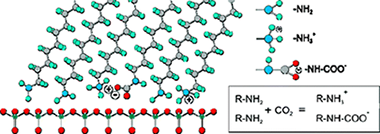
Structural and chemical data on n-octadecylamine self-assembled monolayers on mica (ODA/mica SAMs) have been obtained from ATR-FTIR and XPS spectroscopies. The analysis of the methylene modes concludes that alkylamine molecules are arranged in a rigid and well-ordered packing. Besides, the magnitude of the splitting of the methylene scissoring deflection is consistent with a molecular tilted configuration within the self-assembled layer, as already reported from topographic AFM data. Molecular dynamics simulations have supported this conclusion. XPS has revealed the presence of an important fraction of protonated amino groups (-NH3+) even in freshly prepared ODA/mica SAMs in air at RT. Two sources of protonation are proposed: (i) the acid-base reaction of (-NH2) end groups with the water adlayer on the surface of hydrophilic mica and (ii) the formation of an alkylamonium alkylcarbamate by a fast reaction with the atmospheric CO2 dissolved in such water adlayer. Though the water induced amino protonation is hypothetical, the presence of carbamate is univocally confirmed by ATR-FTIR. Upon extended contact with air (ripening) the conformational ordering in ODA/mica SAMs is slightly improved. Besides, further amino group protonation takes place with no additional carbamate formation. The process is described by a tentative mechanism in which protons are transferred from water molecules at the edges of SAMs islands to the inside. On the other side, carbamation is hindered by the steric effect of CO2 molecules trying to penetrate the close packed structure of octadecylamine molecules.
October, 2011 | DOI: 10.1021/jp203871g
Materiales de Diseño para la Energía y Medioambiente
Evolution of Phases and Al–Si Distribution during Na-4-Mica Synthesis
María D. Alba, Miguel A. Castro, Moisés Naranjo, M. Mar Orta, Esperanza Pavón, and M. Carolina PazosJournal of Physical Chemistry C, 2011, 115 (41), pp 20084–20090
Show abstract ▽
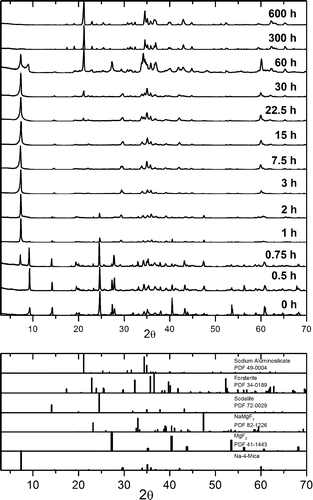
Na-4-mica, a highly charged fluorophlogopite, has recently attracted much attention because of its unique combination of high charge (four charges per unit cell) and its swelling and cation-exchange properties. The ability to improve the properties of this mica depends on gaining knowledge about its phase evolution during the calcination process. For the synthesis, the stoichiometric powder mixture (4SiO 2/2Al 2O 3/6MgF 2/8NaCl) was heated to 900 °C for 0-600 h. The obtained solids were characterized by X-ray fluorescence (XRF); X-ray diffraction (XRD); scanning electron microscopy/energy-dispersive X-ray (SEM/EDX) analysis; 29Si, 27Al, and 23Na magic-angle-spinning MAS NMR spectroscopy; and thermogravimetric/differential thermal analysis (TG/DTA). The results showed that the precursors are rapidly (t < 3 h) transformed into sodalite, Al 6Na 8(SiO 4) 6Cl 2, and a 2:1 phyllosilicate. For t = 7.5 h, the amount of 2:1 phyllosilicate increased as a result of the decomposition of sodalite, with a progressive incorporation of aluminum in the 2:1 phyllosilicate being observed. For t = 7.5 h, synthesis of Na-4-mica was considered to be complete, as the material remained essentially unaltered for the next 15 h. For t = 30 h, the mica started to decompose, and for very long reaction times (t ≥ 300 h), only forsterite and a carnegierite phase were present.
October, 2011 | DOI: 10.1021/jp207408h
Materiales de Diseño para la Energía y Medioambiente
Formation of organo-highly charged mica
Alba, M.D. , Castro, M.A., Orta, M.M., Pavón, E., Pazos, M.C., Valencia Rios, J.S.Langmuir, 16 (2011) 9711-9718
Show abstract ▽

The interlayer space of the highly charged synthetic Na-Mica-4 can be modified by ion-exchange reactions involving the exchange of inorganic Na + cations by surfactant molecules, which results in the formation of an organophilic interlayer space. The swelling and structural properties of this highly charged mica upon intercalation with n-alkylammonium (RNH 3) + cations with varying alkyl chain lengths (R = C12, C14, C16, and C18) have been reported. The stability, fine structure, and evolution of gaseous species from alkylammonium Mica-4 are investigated in detail by conventional thermogravimetric analysis (TGA), Fourier transform infrared spectroscopy (FTIR), in situ X-ray diffraction (XRD), and solid-state nuclear magnetic resonance (MAS NMR) techniques. The results clearly show the total adsorption of n-alkylammonium cations in the interlayer space which expands as needed to accommodate intercalated surfactants. The surfactant packing is quite ordered at room temperature, mainly involving a paraffin-type bilayer with an all-trans conformation, in agreement with the high density of the organic compounds in the interlayer space. At temperatures above 160 °C, the surfactant molecules undergo a transformation that leads to a liquid-like conformation, which results in a more disordered phase and expansion of the interlayer space.
August, 2011 | DOI: 10.1021/la200942u
Materiales de Diseño para la Energía y Medioambiente
Structural elucidation of Β-(Y,Sc)2Si2O 7: Combined use of 89Y MAS NMR and powder diffraction
Allix, M., Alba, M.D., Florian, P., Fernandez-Carrion, A.J., Suchomel, M.R., Escudero, A., Suard, E., Becerro, A.I.Journal of Applied Crystallography, 44 (2011) 846-852
Show abstract ▽
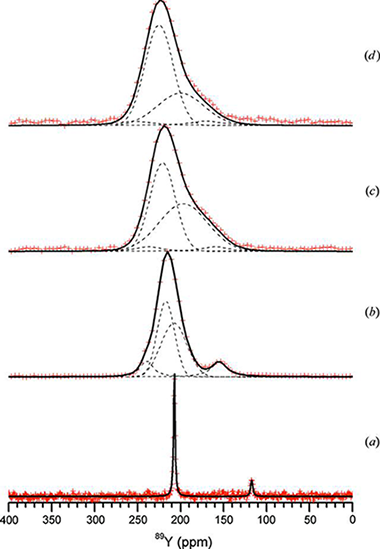
Although the structures of pure Sc2Si2O7 and Β-Y2Si 2O7 have been described in the literature using the C2/m space group, 29Si magic angle spinning (MAS) NMR measurements of the intermediate members of the Sc2Si2O7-Β- Y2Si2O7 system indicate a lowering of the symmetry to the C2 space group. Indeed, these compositions exhibit a unique Si crystallographic site and an Si-O-Si angle lower than 180°, incompatible with the C2/m space group. C2 is the only possible alternative. Space group Cm can be discarded with regard to its two different Si sites per unit cell. Moreover, 89Y MAS NMR data have revealed the existence of two different Y sites in the structure of the intermediate members of the Sc 2Si2O7-Β-Y2Si2O 7 system, confirming the lowering of the symmetry to the C2 space group. The viability of the C2 model has therefore been tested and confirmed by refinement of synchrotron and neutron powder diffraction data for the different members of the system. The structural evolutions across the Sc 2Si2O7-Β-Y2Si2O 7 system are discussed.
August, 2011 | DOI: 10.1107/S0021889811021303
Materiales de Diseño para la Energía y Medioambiente
Solid solubility of Yb2Si2O7 in β-, γ- And δ-Y2Si2O7
Fernández-Carrión, A.J., Alba, M.D., Escudero, A., Becerro, A.I.Journal of Solid State Chemistry, 184 (2011) 1882-1889
Show abstract ▽
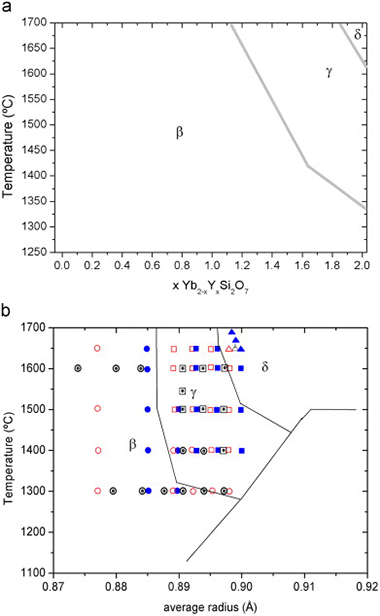
This paper examines the structural changes with temperature and composition in the Yb2Si2O7–Y2Si2O7 system; members of this system are expected to form in the intergranular region of Si3N4 and SiC structural ceramics when sintered with the aid of Yb2O3 and Y2O3 mixtures. A set of different compositions have been synthesised using the sol–gel method to obtain a xerogel, which has been calcined at temperatures between 1300 and 1650 °C during different times. Isotherms at 1300 and 1600 °C have been analysed in detail to evaluate the solid solubility of Yb2Si2O7 in β-Y2Si2O7 and γ-Y2Si2O7. Although Yb2Si2O7 shows a unique stable polymorph (β), Yb3+ is able to replace Y3+ in γ-Y2Si2O7 and δ-Y2Si2O7 at high temperatures and low Yb contents. IR results confirm the total solid solubility in the system and suggest a constant SiOSi angle of 180° in the Si2O7 unit across the system. The temperature–composition diagram of the system, obtained from powder XRD data, is dominated by the β-RE2Si2O7 polymorph, with γ-RE2Si2O7 and δ-RE2Si2O7 showing reduced stability fields. The diagram is in accordance with Felsche's diagram if average ionic radii are assumed for the members of the solid solution at any temperature, as long as the β–γ phase boundary is slightly shifted towards higher radii.
July, 2011 | DOI: 10.1016/j.jssc.2011.05.034
Reactividad de Sólidos - Materiales de Diseño para la Energía y Medioambiente
High-temperature mechanical behavior of polycrystalline yttrium-doped barium cerate perovskite
Vaquero-Aguilar, C; Lopez-Robledo, MJ; Martinez-Fernandez, J; Real, C; Jimenez-Melendo, MJournal of the European Ceramic Society, 31 (2011) 1333-1338
Show abstract ▽
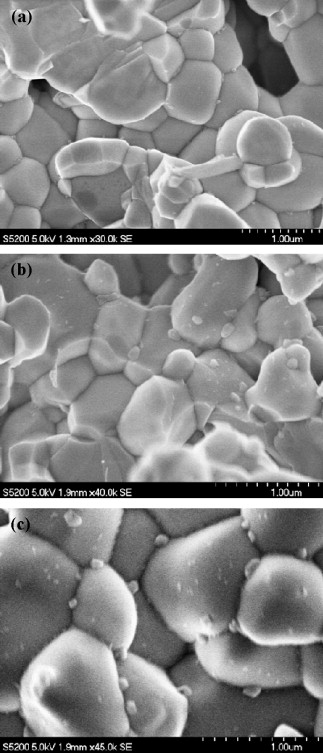
The high-temperature mechanical properties of the mixed ionic-electronic conductor perovskite BaCe0.95Y0.05O3−δ with average grain size of 0.40 μm have been studied in compression between 1100 and 1300 °C in air at different initial strain rates. The true stress–true strain curves display an initial stress drop, followed by an extended steady-state stage. As the temperature decreases and/or the strain rate increases, there is a transition to a damage-tolerant strain-softening stage and eventually to catastrophic failure. Analysis of mechanical and microstructural data revealed that grain boundary sliding is the primary deformation mechanism. The strength drop has been correlated with the growth of ultrafine grains during deformation, already present at grain boundaries and triple grain junctions in the as-fabricated material.
June, 2011 | DOI: 10.1016/j.jeurceramsoc.2010.05.023
Materiales de Diseño para la Energía y Medioambiente
Microstructural and mechanical evaluation of a Cu-based active braze alloy to join silicon nitride ceramics
Singh, M; Asthana, R; Varela, FM; Martinez-Fernandez, JJournal of the European Ceramic Society, 31 (2011) 1309-1316
Show abstract ▽
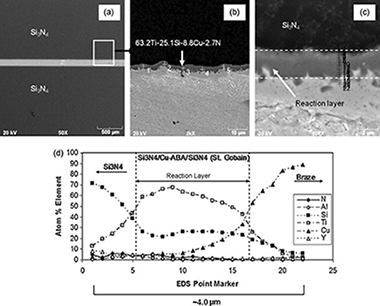
Self-joining of St. Gobain Si3N4 (NT-154) using a ductile Cu–Al–Si–Ti active braze (Cu-ABA) was demonstrated. A reaction zone (∼2.5–3.5 μm thick) developed at the interface after 30 min brazing at 1317 K. The interface was enriched in Ti and Si. The room temperature compressive shear strengths of Si3N4/Si3N4 and Inconel/Inconel joints (the latter created to access baseline data for use with the proposed Si3N4/Inconel joints) were 140 ± 49 MPa and 207 ± 12 MPa, respectively. High-temperature shear tests were performed at 1023 K and 1073 K, and the strength of the Si3N4/Si3N4 and Inconel/Inconel joints were determined. The joints were metallurgically well-bonded for temperatures above 2/3 of the braze solidus. Scanning and transmission electron microscopy studies revealed a fine grain microstructure in the reaction layer, and large grains in the inner part of the joint with interfaces being crack-free. The observed formation of Ti5Si3 and AlN at the joint interface during brazing is discussed.
June, 2011 | DOI: 10.1016/j.jeurceramsoc.2010.07.022
Materiales de Diseño para la Energía y Medioambiente
Microstructural and mechanical evaluation of porous biomorphic silicon carbide for high temperature filtering applications
Bautista, MA; Cancapa, JQ; Fernandez, JM; Rodriguez, MA; Singh, MJournal of the European Ceramic Society, 31 (2011) 1325-1332
Show abstract ▽
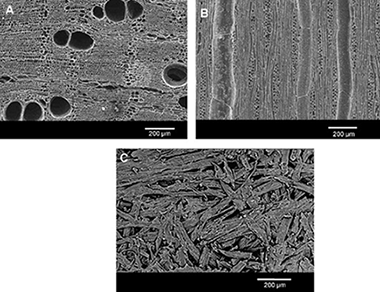
Biomorphic SiC (bioSiC) is a low cost SiC/Si composite obtained by melt infiltration of carbon preforms obtained from the pyrolysis of cellulose precursors. The porosity and pore size distribution of bioSiC can be tailored for specific applications by adequate selection of the wood precursor. Natural and artificial industrial woods were explored as possible bioSiC precursors. Silicon was removed by chemical etching. Relevant microstructural parameters such as pore size distribution, total porosity, and permeability were characterized. Since the filtration process involves large pressure gradients along the material at high temperatures, mechanical properties of porous bioSiC from the different precursors were evaluated at room temperature and 800 °C. The feasibility of porous bioSiC as a filtration material for high temperature gasification processes is discussed in terms of these properties. MDF-bioSiC is shown to be a promising material for such applications because of its good mechanical properties, interconnected porosity, pore sizes, and permeability.
June, 2011 | DOI: 10.1016/j.jeurceramsoc.2010.06.014
Materiales de Diseño para la Energía y Medioambiente
Compressive strength degradation in ZrB2-based ultra-high temperature ceramic composites
Ramirez-Rico, J; Bautista, MA; Martinez-Fernandez, J; Singh, MJournal of the European Ceramic Society, 31 (2011) 1345-1352
Show abstract ▽
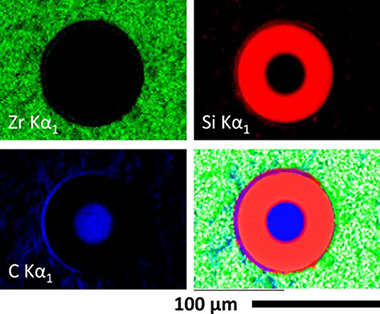
The high temperature compressive strength behavior of zirconium diboride (ZrB2)-silicon carbide (SiC) particulate composites containing either carbon powder or SCS-9a silicon carbide fibers was evaluated in air. Constant strain rate compression tests have been performed on these materials at room temperature, 1400, and 1550°C. The degradation of the mechanical properties as a result of atmospheric air exposure at high temperatures has also been studied as a function of exposure time. The ZrB2-SiC material shows excellent strength of 3.1±0.2GPa at room temperature and 0.9±0.1GPa at 1400°C when external defects are eliminated by surface finishing. The presence of C is detrimental to the compressive strength of the ZrB2-SiC-C material, as carbon burns out at high temperatures in air. As-fabricated SCS-9a SiC fiber reinforced ZrB2-SiC composites contain significant matrix microcracking due to residual thermal stresses, and show poor mechanical properties and oxidation resistance. After exposure to air at high temperatures an external SiO2 layer is formed, beneath which ZrB2 oxidizes to ZrO2. A significant reduction in room temperature strength occurs after 16-24h of exposure to air at 1400°C for the ZrB2-SiC material, while for the ZrB2-SiC-C composition this reduction is observed after less than 16h. The thickness of the oxide layer was measured as a function of exposure time and temperatures and the details of oxidation process has been discussed.
June, 2011 | DOI: 10.1016/j.jeurceramsoc.2010.05.020
Materiales de Diseño para la Energía y Medioambiente
Electrical properties of biomorphic SiC ceramics and SiC/Si composites fabricated from medium density fiberboard
T.S. Orlova, V.V. Popov, J. Quispe Cancapa, D. Hernández Maldonado, E. Enrique Magarino, F.M. Varela Feria, A. Ramírez de Arellano, J. Martínez FernándezJournal of the European Ceramic Society, 31 (2011) 1317-1323
Show abstract ▽
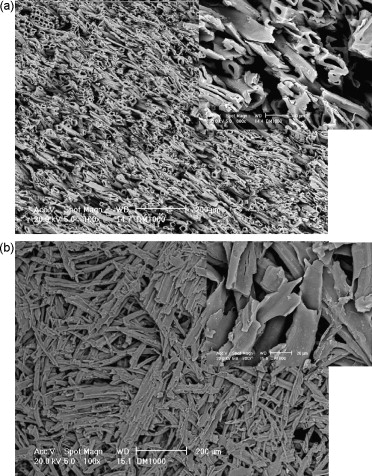
A study has been made of the dependences of the electrical resistivity and the Hall coefficient on the temperature in the range 1.8–1300 K and on magnetic fields of up to 28 kOe for the biomorphic SiC/Si (MDF-SiC/Si) composite and biomorphic porous SiC (MDF-SiC) based upon artificial cellulosic precursor (MDF – medium density fiberboards). It has been shown that electric transport in MDF-SiC is effected by carriers of n-type with a high concentration of ∼1020 cm−3 and a low mobility of ∼0.4 cm2 V−1 s−1. The specific features in the conductivity of MDF-SiC are explained by quantum effects arising in disordered systems and requiring quantum corrections to conductivity. The TEM studies confirmed the presence of disordering structural features (nanocrystalline regions) in MDF-SiC. The conductivity of MDF-SiC/Si composite originates primarily from Si component in the temperature range 1.8–500 K and since ∼500 to 600 K the contribution of MDF-SiC matrix becomes dominant.
June, 2011 | DOI: 10.1016/j.jeurceramsoc.2010.06.015
Materiales de Diseño para la Energía y Medioambiente
Stability of Rare-Earth Disilicates: Ionic Radius Effect
Galunin, E; Alba, MD; Vidal, MJournal of the American Ceramic Society, 94 (2011) 1568–1574
Show abstract ▽
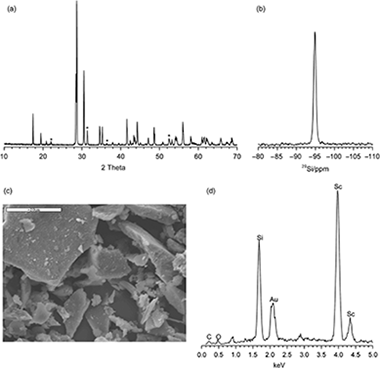
Rare-earth (RE) disilicates, of general formula RE2Si 2O7, are one of the products of the chemical reaction between RE (elements), which are actinide simulators, and the silicates used in the engineered barrier systems of deep geological repositories (DGPs). The aim of this paper is to establish the stability range of the disilicate phase as function of the nature of the RE (RE=Sc, Lu, or Y) and examine whether this phase would permit RE leaching under experimental conditions simulating those of the DGP. The β-polymorphs of the RE disilicates were synthesized by the sol-gel method and subsequently submitted to a pHstat leaching test. The rates of RE and Si leaching were measured and the transformation of the crystalline and amorphous phases was examined by X-ray powder diffraction and nuclear magnetic resonance techniques. The results indicate that the disilicate phases were stable within a wide range of pH, their stability being related to the hydrated ratio of the RE. Disilicate stability increased with the ionic radius of the RE. As a result, the Sc disilicate was stable throughout the pH range tested, whereas Y and Lu disilicate leaching was only observed at pH<4. Thus, it was confirmed that the formation of the disilicate phases could contribute to the confinement of radioactive wastes in engineered barriers.
May, 2011 | DOI: 10.1111/j.1551-2916.2010.04272.x
Materiales de Diseño para la Energía y Medioambiente
Structure and support induced structure disruption of soft nanoparticles obtained from hydroxylated fatty acids
Heredia-Guerrero, JA; San-Miguel, MA; Luna, M; Dominguez, E; Heredia, A; Benitez, JJSoft Matter, 7 (2011) 4357-4363
Show abstract ▽
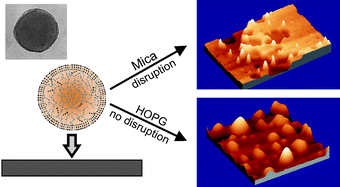
Soft and spherical nanoparticles, named as cutinsomes, have been prepared from concentrated 9(10),16-dihydroxypalmitic acid (diHPA) in aqueous solution. After isolation, cutinsomes have been chemically and structurally characterized by ATR-FTIR, TEM and dynamic atomic force microscopy (dynamic AFM). The nanoparticle can be described as a lipidic, liquid-like and mostly esterified core surrounded by a polar shell of carboxylate/carboxylic acid molecules. Molecular dynamic (MD) simulations have been used to support this model. The structural stability of soft cutinsomes has been tested by deposition on both non-polar (HOPG) and polar (mica) flat substrates. It has been found that the magnitude of the interaction between the polar shell of cutinsomes and the support determines their structure conservation or its spreading or rupture and spill out of the liquid-like content. The structural consistence of these nanoparticles as a function of the polarity of substrate is of interest in elucidating the formation mechanism of cutin, the most abundant biopolyester in nature and a very interesting biomaterial to be mimetized.
May, 2011 | DOI: 10.1039/c0sm01545h
Materiales de Diseño para la Energía y Medioambiente
Interaction of Eu-isotopes with saponite as a component of the engineered barrier
María D. Alba, Miguel A. Castro, P. Chaín, Santiago Hurtado, M. Mar Orta, M. Carolina Pazos and María VillaApplied Clay Science, 52 (2011) 253-257
Show abstract ▽
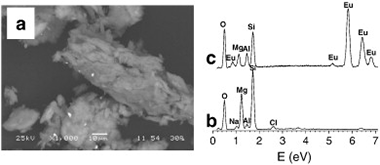
Bentonite is accepted as the best clay material in the engineered barrier of deep geological repositories (DGRs) for radioactive waste disposal. In recent years, the interactions between a wide range of rare-earth (REE) cations and smectites have been studied. A combined study of stable europium and radioactive isotopes is reported here. Saponite was subjected to hydrothermal reactions with stable and radioactive (152Eu) europium ions under subcritical conditions. The structural changes of saponite were evaluated by XRD and SEM. The effect of temperature and reaction time on the changes was quantified by measuring 152Eu through gamma spectrometry. The reaction between europium and saponite was a first-order reaction. The presence of Eu in the precipitate in an amount much higher than the cation exchange capacity of saponite confirmed participation of chemical reactions or surface adsorption in the europium immobilization, even at temperatures as low as 150 °C. The reaction rate constant indicated that an 8- to 9-month period was needed for the completion, without significant changes, of the europium/saponite chemical reaction under the subcritical conditions of 200 °C and 350 °C.
May, 2011 | DOI: 10.1016/j.clay.2011.02.027
Materiales de Diseño para la Energía y Medioambiente
Structural, chemical surface and transport modifications of regenerated cellulose dense membranes due to low-dose γ-radiation
Vazquez, MI; Heredia-Guerrero, JA; Galan, P; Benitez, JJ; Benavente, JMaterials Chemistry and Physics, 126 (2011) 734-740
Show abstract ▽

Modifications caused in commercial dense regenerated cellulose (RC) flat membranes by low-dose γ-irradiation (average photons energy of 1.23 MeV) are studied. Slight structural, chemical and morphological surface changes due to irradiation in three films with different RC content were determined by ATR-FTIR, XRD, XPS and AFM. Also, the alteration of their mechanical elasticity has been studied. Modification of membrane performance was determined from solute diffusion coefficient and effective membrane fixed charge concentration obtained from NaCl diffusion measurements. Induced structural changes defining new and effective fracture propagation directions are considered to be responsible for the increase of fragility of irradiated RC membranes. The same structural changes are proposed to explain the reduction of the membrane ion permeability through a mechanism involving either ion pathways elongation and/or blocking.
April, 2011 | DOI: 10.1016/j.matchemphys.2010.12.051
Materiales de Diseño para la Energía y Medioambiente
Bulk and Adsorbed Monolayer Phase Behavior of Binary Mixtures of Undecanoic Acid and Undecylamine: Catanionic Monolayers
Sun, C; Bojdys, MJ; Clarke, SM; Harper, LD; Jefferson, A; Castro, MA; Medina, SLangmuir, 27 (2011) 3626-3637
Show abstract ▽

Differential scanning calorimetry (DSC) and X-ray powder diffraction (PXRD) have been used to determine the phase behavior of the binary mixtures of undecanoic acid (A) and undecylamine (B) in the bulk. In addition, we report DSC data that indicates very similar behavior for the solid monolayers of these materials adsorbed on the surface of graphite. The two species are found to form a series of stoichiometric complexes of the type AB, A2B, and A 3B on the acid rich side of the phase diagram. Interestingly, no similar series of complexes is evident on the amine rich side. As a result of this complexation, the solid monolayers of the binary mixtures exhibit a very pronounced enhancement in stability relative to the pure adsorbates.
April, 2011 | DOI: 10.1021/la1048198
Materiales de Diseño para la Energía y Medioambiente
The biophysical design of plant cuticles: an overview
Dominguez, E; Heredia-Guerrero, JA; Heredia, ANew Phytologist, 189 (2011) 938-949
Show abstract ▽
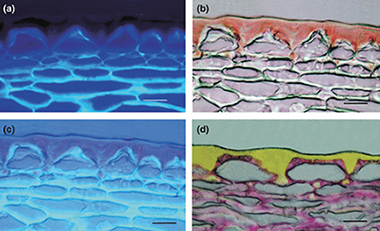
The outer surfaces of epidermal cell walls are impregnated with an extracellular matrix called the cuticle. This composite matrix provides several functions at the interface level that enable plants to thrive in different habitats and withstand adverse environmental conditions. The lipid polymer cutin, which is the main constituent of the plant cuticle, has some unique biophysical properties resulting from its composition and structure. This review summarizes the progress made towards understanding the biophysical significance of this biopolymer with special focus on its structural, thermal, biomechanical, and hydric properties and relationships. The physiological relevance of such biophysical properties is discussed in light of existing knowledge on the plant cuticle.
March, 2011 | DOI: 10.1111/j.1469-8137.2010.03553.x
Materiales de Diseño para la Energía y Medioambiente
Monolayer structures of alkyl aldehydes: Odd-membered homologues
Phillips, TK; Clarke, SM; Bhinde, T; Castro, MA; Millan, C; Medina, SThin Solid Films, 519 (2011) 3123-3127
Show abstract ▽

Crystalline monolayers of three aldehydes with an odd number of carbon atoms in the alkyl chain (C7, C9 and C11) at low coverages are observed by a combination of X-ray and neutron diffraction. Analysis of the diffraction data is discussed and possible monolayer crystal structures are proposed; although unique structures could not be ascertained for all molecules. We conclude that the structures are flat on the surface, with the molecules lying in the plane of the layer. The C11 homologue is determined to have a plane group of either p2, pgb or pgg, and for the C7 homologue the p2 plane group is preferred.
March, 2011 | DOI: 10.1016/j.tsf.2010.12.084
Materiales de Diseño para la Energía y Medioambiente
Blocking of grain reorientation in self-doped alumina materials
Suarez, M; Fernandez, A; Menendez, JL; Ramirez-Rico, J; Torrecillas, RScripta Materialia, 64 (2011) 517-520
Show abstract ▽
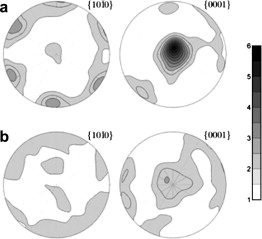
Alumina nanoparticles 10-20 nm in diameter were nucleated on alumina particles, 150 nm average diameter, by a colloidal route followed by calcination. It is shown that after sintering, the final grain size is up to 20% smaller due to the addition of the alumina nanoparticles. Electron backscattered diffraction analysis shows that whereas a correlation in the relative crystalline orientations between neighbouring grains exists in the pure materials, the addition of alumina nanoparticles results in a random crystalline orientation.
March, 2011 | DOI: 10.1016/j.scriptamat.2010.11.031
Materiales de Diseño para la Energía y Medioambiente
Examination of competitive lanthanide sorption onto smectites and its significance in the management of radioactive waste
Galunin, E; Alba, MD; Santos, MJ; Abrao, T; Vidal, MJournal of Hazardous Materials, 186 (2011) 1930-1941
Show abstract ▽
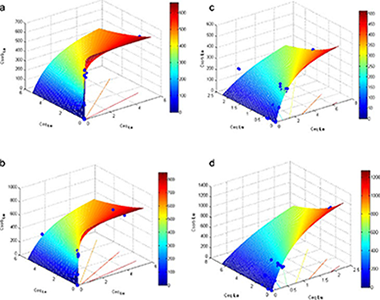
The competitive effect of La and Lu (analogues of radionuclides appearing in radioactive waste) in the sorption in four smectites was examined. Sorption and desorption distribution coefficients (Kd; Kd,des), and desorption rates (Rdes) were determined from batch tests in two media: deionized water and, to consider the influence of cement leachates, 0.02molL-1 Ca. The competitive effect was lower when high-affinity sites were available, as in the water medium at the lowest range of initial lanthanide concentration, with high Kd for La and for Lu (5-63×104Lkg-1). Lower Kd was measured at higher initial concentrations and in the Ca medium, where Lu showed a stronger competitive effect. This was confirmed by fitting the sorption data to a two-solute Langmuir isotherm. The desorption data indicated that sorption was virtually irreversible for the scenarios with high sorption, with an excellent correlation between Kd and Kd,des (R2 around 0.9 for the two lanthanides). Assuming that radioactive waste is a mixture of radionuclides, and that Ca ions will be provided by the cement leachates, this would reduce the retention capacity of clay engineered barriers.
February, 2011 | DOI: 10.1016/j.jhazmat.2010.12.098
2010
2010
Materiales de Diseño para la Energía y Medioambiente
Bioactivation of biomorphous silicon carbide bone implants
Will J, Hoppe A, Muller FA, Raya CT, Fernandez JM, Greil PActa Biomaterialia, 6 (2010) 448-4494
Show abstract ▽
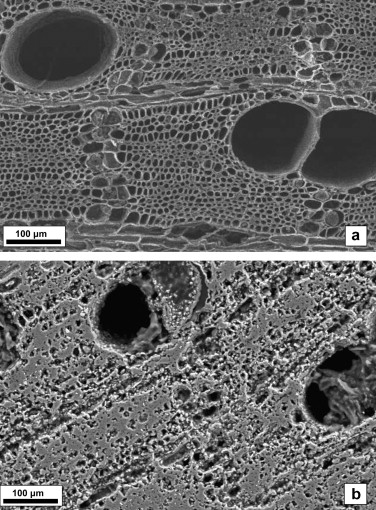
Wood-derived silicon carbide (SiC) offers a specific biomorphous microstructure similar to the cellular pore microstructure of bone. Compared with bioactive ceramics such as calcium phosphate, however, silicon carbide is considered not to induce spontaneous interface bonding to living bone. Bioactivation by chemical treatment of biomorphous silicon carbide was investigated in order to accelerate osseointegration and improve bone bonding ability. Biomorphous SiC was processed from sipo (Entrandrophragma utile) wood by heating in an inert atmosphere and infiltrating the resulting carbon replica with liquid silicon melt at 1450 °C. After removing excess silicon by leaching in HF/HNO3 the biomorphous preform consisted of β-SiC with a small amount (approximately 6 wt.%) of unreacted carbon. The preform was again leached in HCl/HNO3 and finally exposed to CaCl2 solution. X-ray photoelectron spectroscopy (XPS) and Fourier transform infrared analyses proved that oxidation of the residual carbon at the surface induced formation of carboxyl [COO-] groups, which triggered adsorption of Ca2+, as confirmed by XPS and inductively coupled plasma optical emission spectroscopy measurements. A local increase in Ca2+ concentration stimulated in vitro precipitation of Ca5(PO 4)3OH (HAP) on the silicon carbide preform surface during exposure to simulated body fluid, which indicates a significantly increased bone bonding activity compared with SiC.
December, 2010 | DOI: 10.1016/j.actbio.2010.06.036
Materiales de Diseño para la Energía y Medioambiente
Aleuritic (9,10,16-trihydroxypalmitic) acid self-assembly on mica
Heredia-Guerrero, JA; San-Miguel, MA; Sansom, MSP; Heredia, A; Benitez, JJPhysical Chemistry Chemical Physics, 12 (2010) 10423-10428
Show abstract ▽
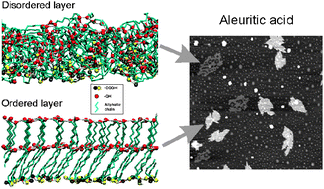
Aleuritic (9,10,16-trihydroxypalmitic) acid self-assembly on mica from solution has been studied using AFM, ATR-FTIR and MD simulations. The goal of this study is to define the role of hydroxyl groups in the interaction between molecules as reference data to understand the mechanism of formation of synthetic and natural biopolyesters from polyhydroxylated long chain carboxylic acids. In a confined structure, such as the one imposed by a vertically self-assembled layer on mica, aleuritic acid has a tendency to adopt a monolayer configuration ruled by the lateral interactions between molecules via the two secondary hydroxyl groups. This (2D) growth competes with the multilayer formation (3D), which is conditioned by the terminal primary hydroxyl group. As the self-assembly spatial constraint is relaxed, MD has shown that the structure tends to become an amorphous and crosslinked phase that can be characterized by topographic and friction force AFM data.
September, 2010 | DOI: 10.1039/c0cp00163e
Materiales de Diseño para la Energía y Medioambiente
Steering the Self-Assembly of Octadecylamine Monolayers on Mica by Controlled Mechanical Energy Transfer from the AFM Tip
Benitez, JJ; Heredia-Guerrero, JA; Salmeron, MJournal of Physical Chemistry C, 114 (2010) 12630-12634
Show abstract ▽
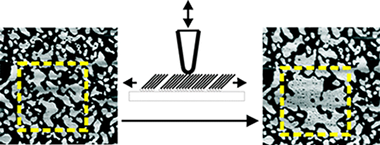
We have studied the effect of mechanical energy transfer from the tip of an atomic force microscope on the dynamics of self-assembly of monolayer films of octadecylamine on mica. The formation of the self-assembled film proceeds in two successive stages, the first being a fast adsorption from solution that follows a Langmuir isotherm. The second is a slower process of island growth by aggregation of the molecules dispersed on the surface. We found that the dynamics of aggregation can be altered substantially by the addition of mechanical energy into the system through controlled tip surface interactions. This leads to both the creation of pinholes in existing islands as a consequence of vacancy concentration and to the assembly of residual molecules into more compact islands.
July, 2010 | DOI: 10.1021/jp102813s
Materiales de Diseño para la Energía y Medioambiente
Sc-45 Spectroscopy of Solids: Interpretation of Quadrupole Interaction Parameters and Chemical Shifts
Alba, MD; Chain, P; Florian, P; Massiot, DJournal of Physical Chemistry C, 114 (2010) 12125-12132
Show abstract ▽
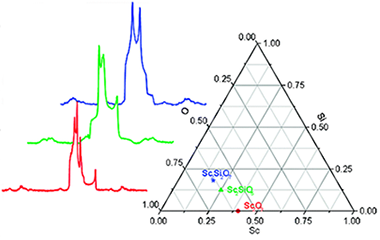
The aims of the present study is to describe for the first time the Sc-45 MAS NMR spectra of X-2-Sc2SiO5 and C-Sc2Si2O7, to combine the spectroscopic information with the structures published from diffraction data, and to propose a rational interpretation of the chemical shifts and quadrupolar parameters. For that purposed, we have correlated the experimental quadrupole coupling parameters of Sc-45 determined for a number of scandium compounds to those found by a simple electrostatic calculation and we have found that the isotropic chemical shift of the Sc-45 is linearly correlated to the shift parameter, calculated by bond-valence theory. We also show that a simple point charge calculation can approximate the electric field gradient to a sufficiently good approximation that it provides a valuable mean to assign the NMR spectra.
July, 2010 | DOI: 10.1021/jp1036525
Materiales de Diseño para la Energía y Medioambiente
Self-assembly of supramolecular lipid nanoparticles in the formation of plant biopolyester cutin
Dominguez, E; Heredia-Guerrero, JA; Benitez, JJ; Heredia, AMolecular Biosystems, 6 (2010) 948-950
Show abstract ▽
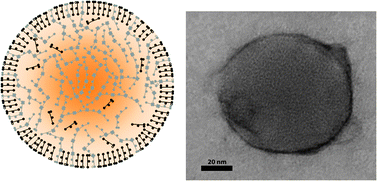
The implication of a self-assembly process in the early stages of cutin biosynthesis has been shown by means of antibodies raised against polyhydroxy fatty acid nanoparticles (cutinsomes).
June, 2010 | DOI: 10.1039/b927186d
Materiales de Diseño para la Energía y Medioambiente
Application of Micro-X-ray Fluorescence Analysis for the Characterization of Industrial Wastes
Alba, MD; Aparicio, P; Benitez, JM; Castro, MA; Diaz, M; Orta, MMIndustrial & Engineering Chemistry Research, 49 (2010) 2348-2352
Show abstract ▽
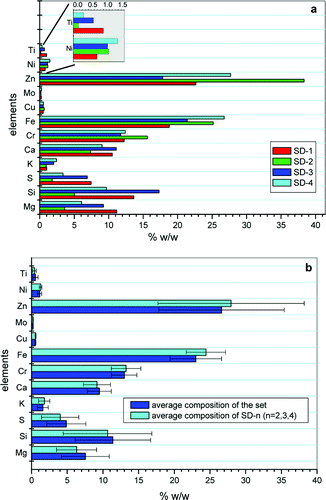
The issue of how to improve product quality and product yield in a short period of time is becoming more critical in many industries. Thus, shorter delay times between laboratory analysis and process correction are important in process control. Elimination of sample handling and operator Manipulation is desirable. The present article proposes micro-X-ray fluorescence (mu XRF) as an economical control method for industrial product quality with a minimum time cost. Samples from different industrial processes have been chosen and analyzed by XRF and mu XRF, The results show that the two techniques give similar results and that mu XRF allows the waste to be classified and is able to detect problems in the production process.
March, 2010 | DOI: 10.1021/ie901716w
Materiales de Diseño para la Energía y Medioambiente
Structural characterization of polyhydroxy fatty acid nanoparticles related to plant lipid biopolyesters
Heredia-Guerrero, JA; Dominguez, E; Luna, M; Benitez, JJ; Heredia, AChemistry and Physics of Lipids, 163 (2010) 329-333
Show abstract ▽
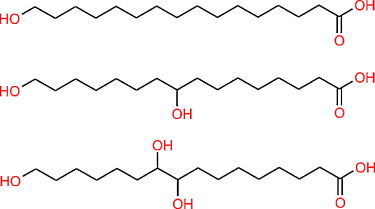
In the present work, we report the physico-chemical properties and structural characteristics of special polyhydroxy fatty acid nanoparticles after their fusion by means of attenuated total reflection-Fourier transform infrared spectroscopy (ATR-FTIR), X-ray diffraction (XRD), differential scanning calorimetry (DSC), scanning electronic microscopy (SEM), atomic force microscopy (AFM), and light microscopy. All the characteristics and properties investigated have an important degree of similarity to the native plant cutin, the main biopolymer present in the plant cuticles. The supramolecular organization of these polymerized prime nanoparticles after their interaction on cellulose substrate and isolated cuticle samples, simulating the in vivo conditions in epidermal plant cells, strongly suggests a growth of these nanoparticles after a self-assembly process.
March, 2010 | DOI: 10.1016/j.chemphyslip.2010.01.006
Materiales de Diseño para la Energía y Medioambiente
Lanthanide sorption on smectitic clays in presence of cement leachates
Galunin, E; Alba, MD; Santos, MJ; Abrao, T; Vidal, MGeochimica et Cosmochimica Acta, 74 (2010) 862-875
Show abstract ▽
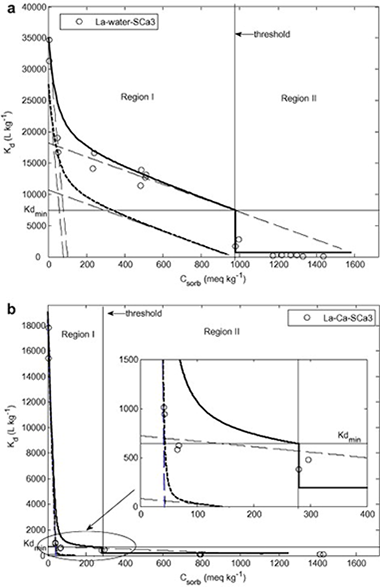
Due to their potential retention capacity, clay minerals have been proposed for use in the engineered barriers for the storage of high-level radioactive actinides in deep geological waste repositories. However, there is still a lack of data on the sorption of actinides in clays in conditions simulating those of the repositories. The present article examines the sorption of two lanthanides (actinide analogues) in a set of smectitic clays (FEBEX bentonite, MX80 bentonite, hectorite, saponite, Otay montmorillonite, and Texas montmorillonite). Distribution coefficients (K-d) were determined in two media: water and 0.02 mol L-1 Ca, the latter representing the cement leachates that may modify the chemical composition of the water in contact with the clay. The K-d values of the lanthanides used in the experiments (La and Lu) varied greatly (25-50 000 L kg(-1)) depending on the ionic medium (higher values in water than in the Ca medium), the initial lanthanide concentration (up to three orders of magnitude decrease inversely with lanthanide concentration), and the examined clay (up to one order of magnitude for the same lanthanide and sorption medium). Freundlich and Langmuir isotherms were used to fit sorption data to allow comparison of the sorption parameters among smectites. The model based on the two-site Langmuir isotherms provided the best fit of the sorption data, confirming the existence of sorption sites with different binding energies. The sites with higher sorption affinity were about 6% of the total sorption capacity in the water medium, and up to 17% in the Ca medium, although in this latter site sorption selectivity was lower. The wide range of K-d values obtained regarding the factors examined indicated that the retention properties of the clays should also be considered when selecting a suitable clay for engineered barriers.
February, 2010 | DOI: 10.1016/j.gca.2009.11.003
2009
2009
Materiales de Diseño para la Energía y Medioambiente
Reversibility of La and Lu sorption onto smectites: Implications for the design of engineered barriers in deep geological repositories
Galunin, E; Alba, MD; Aviles, MA; Santos, MJ; Vidal, MJournal of Hazardous Materials, 172 (2009) 1198-1205
Show abstract ▽
The sorption reversibility of La and Lu (considered as actinide analogues) onto a set of smectites (bentonite FEBEX; hectorite, HEC; MX80; saponite, SAP; Otay montmorillonite, SCa-3; and Texas montmorillonite, STx-1) was studied to estimate actinide retention by smectites that are candidates for use as engineered barriers in deep geological repositories. The sorption distribution coefficients (K d) and the reversibility parameters (desorption distribution coefficients (K d,des), adjusted distribution coefficients (K d,adj), and desorption rates (R des)) were determined from batch tests in two ionic media: deionized water and Ca 0.02 mol L -1. The latter simulates possible conditions due to the presence of concrete leachates. The results varied greatly depending on the ionic medium, the lanthanide concentration and the clay structure. The high values of K d,des obtained (up to 1.1 × 10 5 and 9.2 × 10 4 L kg -1 for La and Lu in water, and 2.8 × 10 4 and 4.1 × 10 4 L kg -1 for La and Lu in the Ca medium) indicate the suitability of the tested smectites for lanthanide (and therefore, actinide) retention. Based on all the data, SCa-3, HEC and FEBEX clays are considered the best choices for water environments, whereas in Ca environments the suitable clays depended on the lanthanide considered.
December, 2009 | DOI: 10.1016/j.jhazmat.2009.07.124
Materiales de Diseño para la Energía y Medioambiente
Synthesis and characterization of a plant cutin mimetic polymer
Heredia-Guerrero, JA; Heredia, A; Garcia-Segura, R; Benitez, JJPolymer, 50 (2009) 5633-5637
Show abstract ▽
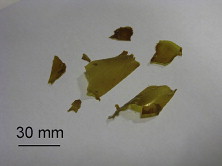
A mimetic polymer of plant cutin have been synthesized from 9,10,16-trihydroxyhexadecanoic (aleuritic) acid through a low temperature polycondensation reaction. Reaction conditions (solvent, catalyst, temperature, etc…) were studied and modified to optimize yield and product characteristics. The resulting polyaleurate polymer was characterized by Attenuated Total Reflection-Fourier Transform Infrared Spectroscopy (ATR-FTIR), Differential Scanning Calorimetry (DSC), X-ray Diffraction (XRD) and solid state 13C-Cross Polarization/Magic Angle Spinning Nuclear Magnetic Resonance (13C-CP/MAS NMR). Mechanical and hydrodynamic properties were also investigated. In the average, the product obtained is physically and chemically very similar to plant cutin (a hydrophobic polyester). However, a more detailed analysis of results reveals that polyaleurate framework is more rigid than natural cutin and with additional larger short-range ordered domains. Also, the synthetic polymer displays slightly different mechanical properties with respect to natural cutin. Additional hydrogen bonding within the framework of polyaleurate is considered to be responsible for such experimental observations.
November, 2009 | DOI: 10.1016/j.polymer.2009.10.018
Materiales de Diseño para la Energía y Medioambiente
The hydrothermal conversion of kaolinite to kalsilite: Influence of time, temperature, and pH
Becerro, AI; Escudero, A; Mantovani, MAmerican Mineralogist, 94 (2009) 11-12
Show abstract ▽
Kalsilite (the low-temperature form of KAlSiO4) is used as the precursor of leucite, an important component in porcelain-fused-to-metal and ceramic-restoration systems, and it has also been proposed as a high-thermal expansion ceramic for bonding to metals. The present study reports the hydrothermal synthesis and characterization of pure kalsilite from kaolinite in subcritical conditions, as well as the characterization of the intermediate products by means of XRD, 29Si and 27Al MAS NMR, IR, SEM, and TEM. Effects of time, temperature, and pH on the reaction products are analyzed. The experimental data indicate that pure kalsilite is obtained after hydrothermal treatment of kaolinite at 300 °C for 12 h in 0.5 M KOH solution. Longer reaction times increase the crystallinity of the structure, whereas lower reaction times give rise to the metastable ABW-type KAlSiO4 polymorph. Lower temperatures are not sufficient to produce kalsilite, but zeolite W is obtained instead as the unique reaction product. Finally, the pH of the aqueous solution in contact with kaolinite is an important parameter for the synthesis of kalsilite, which must be ≥13.70.
November, 2009 | DOI: 10.2138/am.2009.3284
Materiales de Diseño para la Energía y Medioambiente
Hydrothermal Synthesis of Kalsilite: A Simple and Economical Method
Becerro, AI; Mantovani, M; Escudero, AJournal of the American Ceramic Society, 92 (2009) 2204-2206
Show abstract ▽
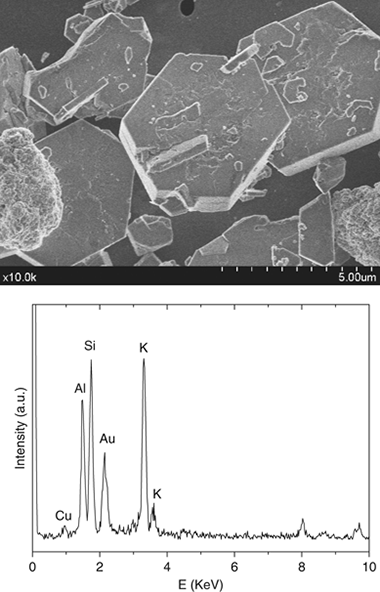
This study reports a simple method to synthesize pure kalsilite (KAlSiO4) using readily available precursors, kaolinite and KOH solution, after only 12 h of hydrothermal treatment in mild conditions. A structural refinement has been carried out using the Rietveld method to obtain unit cell parameters, and the 29Si and 27Al magic angle spinning nuclear magnetic resonance spectra have shown the purity and complete Si/Al ordering of the kalsilite structure obtained. Finally, the morphology of the particles has been analyzed by scanning electron microscopy.
October, 2009 | DOI: 10.1111/j.1551-2916.2009.03232.x
Materiales de Diseño para la Energía y Medioambiente
Rare-earth disilicate formation under Deep Geological Repository approach conditions
Alba, MD; Chain, P; Orta, MMApplied Clay Science, 46 (2009) 63-68
Show abstract ▽
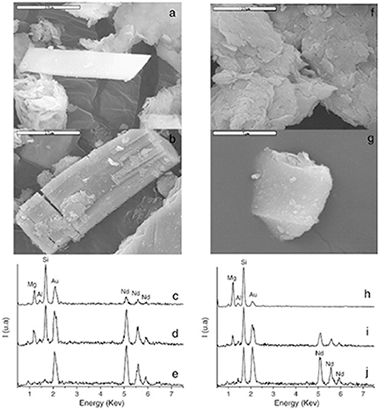
The Deep Geological Repository (DGR) concept involves the placement of long-lived radioactive waste in rooms excavated deep. The major responsibility of the disposal safety falls on the Engineered Barrier System (EBS). The main constituent of EBS is bentonite that prevents the release of radiactive nuclei by physical and chemical mechanisms. The physical mechanism is expected to fault with the weathering of the bentonite while the chemical mechanisms have been only proved at 300 °C. It is the aim of this paper to explore the feasibility of the chemical mechanism at temperatures closer to the DGP conditions and to shed light on the mechanism of transformation of the argillaceous materials of the EBS in rare-earth disilicate phases. Saponite was submitted to hydrothermal reaction at 175 °C and 150 °C with different solutions of REE3+ cations (REE = Sc, Lu, Y, Sm, Nd and La). The products were analyzed by XRD, NMR and electron microscopy. At conditions close to the DGP, the saponite was able to form rare-earth silicates. The formation of the disilicate phase, as final product, needs a set of stages and oxyorthosilicate as precursor.
September, 2009 | DOI: 10.1016/j.clay.2009.07.012
Materiales de Diseño para la Energía y Medioambiente
Mineralogical stability of phyllosilicates in hyperalkaline fluids: Influence of layer nature, octahedral occupation and presence of tetrahedral Al
Becerro, AI; Mantovani, M; Escudero, AAmerican Mineralogist, 94 (2009) 1187-1197
Show abstract ▽
Mineralogical changes in a set of phyllosilicates, differing in their layer nature, chemical composition, octahedral character, and Al content of the tetrahedral sheet, were analyzed after hydrothermal reaction in an alkaline solution. The composition of the alkaline solution was selected to simulate the first stage of cement degradation [NaOH-KOH-Ca(OH)2]. The reaction products have been analyzed by XRD, 29Si and 27Al MAS NMR spectroscopy, SEM/EDX, and TEM. The results indicate that the main factor influencing the stability of the clays is the occupation of the octahedral sheet such that all trioctahedral members withstand the alkaline attack, whereas most of the dioctahedral clays suffer a complete dissolution and crystallization of new phases. Second, clays with Al in the tetrahedral sheet of their layers are shown to be less stable than those with a pure Si tetrahedral sheet.
August, 2009 | DOI: 10.2138/am.2009.3164
Materiales de Diseño para la Energía y Medioambiente
Stability of phyllosilicates in Ca(OH)2 solution: Influence of layer nature, octahedral occupation, presence of tetrahedral Al and degree of crystallinity
Mantovani, M; Escudero, A; Alba, MD; Becerro, AIApplied Geochemistry, 24 (2009) 1251-1260
Show abstract ▽
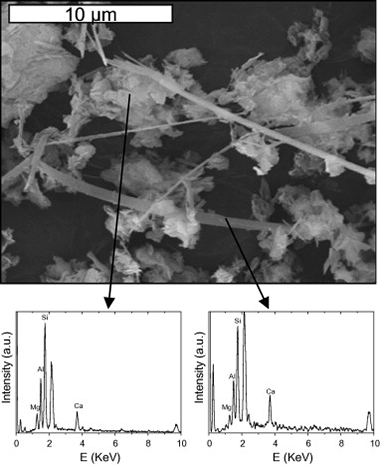
This paper presents the results of a comprehensive investigation of the interaction of layered silicates with Ca(OH)2 in hydrothermal conditions. The study is intended to evaluate the stability of the clay buffer in radioactive waste repositories, at the intermediate stages of concrete leaching, when the pH is controlled by the dissolution of portlandite. The influence of layer nature, octahedral occupation, presence of tetrahedral Al and degree of crystallinity will be assessed by analysing the behaviour of a set of well-selected phyllosilicates and using the combined capabilities of 29Si and 27Al MAS-NMR spectroscopy, powder X-ray diffraction and SEM/EDX. The results show that the main factor affecting the stability of the clay is the octahedral occupation, so that trioctahedral phyllosilicates are much more stable than dioctahedral ones. The nature and expandability of the layer does not seem to much influence the stability of the clay, so that a 2:1 expandable phyllosilicate shows the same stability as a chemically analogous 1:1 non-expandable phyllosilicate. However other factors like the poor crystallinity of the starting material or the presence of Al in the tetrahedral sheet of trioctahedral phyllosilicates weaken the clay structure in alkaline conditions and favour the transformation towards other phases.
July, 2009 | DOI: 10.1016/j.apgeochem.2009.03.012
Materiales de Diseño para la Energía y Medioambiente
Chemical Reactions in 2D: Self-Assembly and Self-Esterification of 9(10),16-Dihydroxypalmitic Acid on Mica Surface
Heredia-Guerrero, JA; San-Miguel, MA; Sansom, MSP; Heredia, A; Benitez, JJLangmuir, 25 (2009) 6869-6874
Show abstract ▽
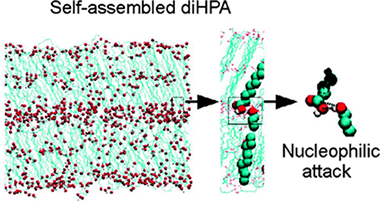
9(10),16-Dihydroxypalmitic acid (diHPA) is a particularly interesting polyhydroxylated fatty acid (1) because it is the main monomer of cutin, the most abundant biopolyester in nature, and (2) because the presence of a terminal and a secondary hydroxyl group in midchain positions provides an excellent model to study their intermolecular interactions in a confined phase such as self-assembled layers. In this study we have combined atomic force microscopy (AFM), X-ray photoelectron spectroscopy (XPS), attenuated total reflection Fourier transform infrared (ATR-FT-IR) spectroscopy, as well as molecular dynamics (MD) simulations to conclude that the self-assembling of diHPA molecules on mica is a layer by layer process following a Brunauer−Emmett−Teller (BET) type isotherm and with the first layer growing much faster than the rest. Interactions between secondary hydroxyls reinforce the cohesive energy of the monolayer, while the presence of the terminal hydroxyl group is necessary to trigger the multilayered growth. Besides, XPS and ATR-FT-IR spectroscopies clearly indicate that spontaneous self-esterification occurs upon self-assembling. The esterification reaction is a prerequisite to propose a self-assembly route for the biosynthesis of cutin in nature. Molecular dynamics simulations have shown that internal molecular reorganization within the self-assembled layers provides the appropriate intermolecular orientation to facilitate the nucleophilic attack and the release of a water molecule required by the esterification reaction.
June, 2009 | DOI: 10.1021/la9001412
Materiales de Diseño para la Energía y Medioambiente
Cutin synthesis: A slippery paradigm
Heredia, A; Heredia-Guerrero, JA; Dominguez, E; Benitez, JJBiointerphases, 4 (2009) P1-P3
Show abstract ▽
Despite its biological importance, the mechanism of construction of cutin, the polymer matrix of plant cuticles, has not yet been elucidated. Recently, progress on lipid barrier formation of polymers such as cutin and suberin has been recently reviewed by Pollard et al. In their review the authors state that the ubiquitous cutin is the least understood of the plant extracellular polymers and that major questions about cutin structure and its macromolecular assembly remain to be resolved. At the time this paper was being published our research group has developed a new hypothesis on plant cutin synthesis.
March, 2009 | DOI: 10.1116/1.3063816
Materiales de Diseño para la Energía y Medioambiente
Preferential Adsorption from Binary Mixtures on Graphite: The n-Decane−n-Heptan-1-ol System
Alba, MD; Castro, MA; Clarke, S; Medina, S; Messe, L; Millan, C; Orta, MM; Perdigon, ACJournal of Physical Chemistry C, 113 (2009) 3176-3180
Show abstract ▽
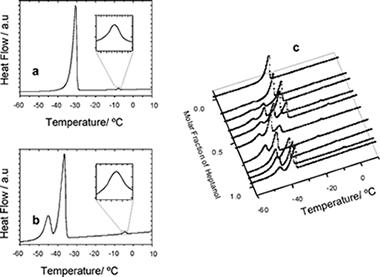
The competitive adsorption of n-decane and n-heptan-1-ol adsorbed from the binary liquid mixture onto graphite has been studied using differential scanning calorimetry, incoherent quasielastic neutron scattering, and 1H and 2H nuclear magnetic resonance. A solid monolayer is identified at all bulk solution compositions with a melting temperature that varies with bulk composition in a manner resembling the bulk behavior. Incoherent elastic neutron scattering, IQNS, and nuclear magnetic resonance, NMR, data indicate that decane is preferentially adsorbed onto the surface over most of the composition range, heptanol being the principal surface component only at very high heptanol concentrations. NMR is proved, for the first time, to be an efficient tool to provide independent information on each component of the system.
February, 2009 | DOI: 10.1021/jp8072014
Materiales de Diseño para la Energía y Medioambiente
Phase separation of carboxylic acids on graphite surface at submonolayer regime
Alba, MD; Bickerstaffe, AK; Castro, MA; Clarke, SM; Medina, S; Millan, C; Orta, MM; Pavon, E; Perdigon, ACThe European Physical Journal Special Topics, 167 (2009) 151-156
Show abstract ▽
Mixing behaviour of solid crystalline monolayers adsorbed onto graphite from different mixtures of undecanoic and dodecanoic acids at submonolayer coverage has been investigated. X-ray diffraction measurements have been collected from a variety of compositions as a function of temperature. An extensive phase separation is found for all the compositions – the scattering patterns characteristic of the pure material crystalline structures being preserved across the entire composition range. The temperature dependence of the monolayer melting points and their depression is also clearly indicative of separation of the two surface components, in clear contrast to that expected if the two carboxylic acids mixed ideally in the monolayer.
February, 2009 | DOI: 10.1140/epjst/e2009-00951-6
Materiales de Diseño para la Energía y Medioambiente
Synthesis of MCM-22 zeolites of different Si/Al ratio and their structural, morphological and textural characterisation
Delitala, C; Alba, MD; Becerro, AI; Delpiano, D; Meloni, D; Musu, E; Ferino, IMicroporous and Mesoporous Materials, 118 (2009) 1-10
Show abstract ▽
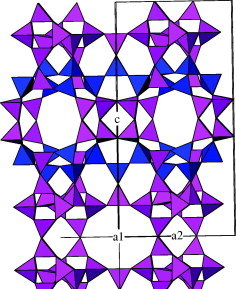
MCM-22 zeolites with Si/Al in the 9–46 range were synthesised in rotating autoclave and characterised by X-ray diffraction, 1H, 29Si and 27Al magic angle spinning nuclear magnetic resonance, scanning electron microscopy and nitrogen physisorption. For the Si/Al = 21, 30 and 46 samples both X-ray diffraction and scanning electron microscopy revealed the crystallisation of pure MCM-22. Besides the latter, crystals of ferrierite also formed during the synthesis of the Si/Al = 9 sample. Based on the 1H MAS NMR spectra of dehydrated samples, the different proton species present on the MCM-22 samples were determined and quantified. Information about the incorporation of Al ions into the zeolite framework, as well as on the preferential crystallographic sites occupied in dependence on the Si/Al ratio of the sample, was obtained by 27Al MAS NMR spectroscopy. From 29Si MAS NMR spectra, differences in the degree of crystallinity of the samples were assessed, the results being in agreement with the diffraction data. Nitrogen physisorption runs revealed the microporous nature of the adsorbents, with a supermicropore to ultramicropore volume ratio in good agreement, for the best crystallised samples, with the porous structure with supercages and sinusoidal channels of the ideal MCM-22 crystal.
February, 2009 | DOI: 10.1016/j.micromeso.2008.07.047
Materiales de Diseño para la Energía y Medioambiente
Liquid-phase thiophene adsorption on MCM-22 zeolites. Acidity, adsorption behaviour and nature of the adsorbed products
Delitala, C; Cadoni, E; Delpiano, D; Meloni, D; Alba, MD; Becerro, AI; Ferino, IMicroporous and Mesoporous Materials, 118 (2009) 11-20
Show abstract ▽
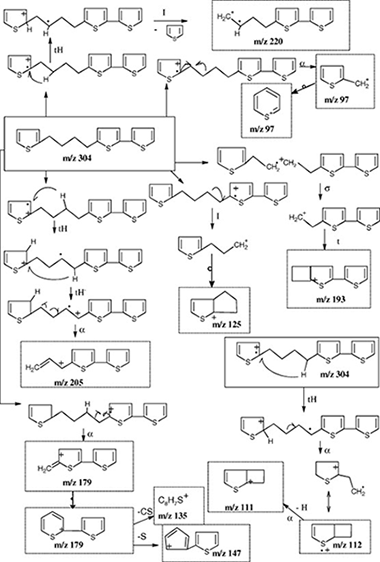
The liquid-phase adsorption of thiophene from thiophene/iso-octane solutions has been investigated in batch conditions at room temperature and atmospheric pressure on MCM-22 zeolites with Si/Al in the 9–46 range. Thiophene adsorption was found to occur in two steps whatever the Si/Al ratio of the adsorbent. The presence of ferrierite besides the MCM-22 phase caused a significant loss of the adsorption performance. For pure MCM-22 samples, the Si/Al ratio influenced the adsorption performance. Based on the acid properties of the samples, investigated by adsorption microcalorimetry of ammonia, the adsorption features were interpreted by assuming that positively charged species were originated during the first step; these species underwent successive reaction with weakly adsorbed species formed in the second step, leading to heavy molecular weight organosulphur compounds. Direct evidence for the occurrence of reactive adsorption of thiophene involving its transformation into heavy molecular weight organosulphur compounds was obtained by GC/MS investigation of the nature of the adsorbed material recovered after the adsorption experiments. The peculiar structure of MCM-22 zeolites made possible the formation of long-sized organosulphur compounds. Due to the mechanism by which thiophene is transformed (i.e. progressive addition of other thiophene molecules), the size of the resulting products was found to depend also on the concentration of the weakly adsorbed thiophene molecules able to interact with those already activated through protonation.
February, 2009 | DOI: 10.1016/j.micromeso.2008.08.008
Materiales de Diseño para la Energía y Medioambiente
Synthesis, Rietveld Analysis, and Solid State Nuclear Magnetic Resonance of X2-Sc2SiO5
Alba, MD; Chain, P; Gonzalez-Carrascosa, TJournal of the American Ceramic Society, 92 (2009) 487-490
Show abstract ▽
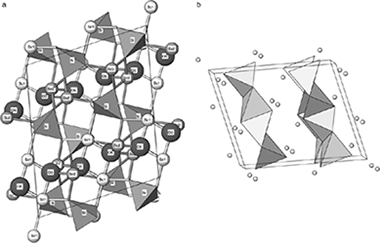
Compounds containing rare earths are of increasing technological interest especially because of their unique mechanical, magnetic, electrical, and optical properties. Among them, rare earth oxyorthosilicates are attractive scintillators for γ- and X-ray spectroscopy and detection. However, there are many structural aspects of those compounds that are not clear. In this research, the structure parameters for Sc2Si2O5, X2-polymorph, have been refined from powder X-ray diffraction (XRD) data and the 29Si MAS NMR spectrum is reported for the first time. X2-Sc2SiO5 polymorph was synthesized by the sol–gel method and characterized by XRD and 29Si MAS NMR. The XRD pattern was indexed in a monoclinic unit cell with space group I2/c; the resulting unit cell parameters were a=9.9674(2) Å, b=6.4264(9) Å, c=12.0636(2) Å, and β=103.938(1)°. The 29Si MAS NMR spectrum showed a unique signal at −79.5 ppm, compatible with the unique Si crystallographic site in the unit cell. Finally, the band valence method has been applied to the calculation of a “shift parameter,” which is correlated with the NMR chemical shift.
February, 2009 | DOI: 10.1111/j.1551-2916.2008.02877.x
2008
2008
Materiales de Diseño para la Energía y Medioambiente
Fabrication, chemical etching, and compressive strength of porous biomimetic SiC for medical implants
Torres-Raya, C; Hernandez-Maldonado, D; Ramirez-Rico, J; Garcia-Ganan, C; de Arellano-Lopez, AR; Martinez-Fernandez, JJournal of Materials Research, 23 (2008) 3247-3254
Show abstract ▽
BioSiC is a biomimetic SiC-based ceramic material fabricated by Si melt infiltration of carbon preforms obtained from wood. The microstructure of bioSiC mimics that of the wood precursor. which can be chosen for tailored properties. When the remaining g unreacted Si is removed. a SiC Material with interconnected porosity is obtained. This porous bioSiC is Under study for its use as a medical Implant material. We have successfully fabricated bioSiC from Sipo wood and Studied the kinetics of Si removal by wet etching. The results suggest that the reaction is diffusion-limited, and the etch rate follows a t(-0.5) law. The etching rate is found to be anisotropic, which can be explained attending to the anisotropy of the pore distribution. The compressive strength was studied as a function of etching, time. and the results show a quadratic dependence with density. In the attainable ran-e of densities, the strength is similar or better than that of human bone.
December, 2008 | DOI: 10.1557/JMR.2008.0392
Materiales de Diseño para la Energía y Medioambiente
The Role of Hydroxyl Groups in the Self-Assembly of Long Chain Alkylhydroxyl Carboxylic Acids on Mica
Benitez, JJ; Heredia-Guerrero, JA; Serrano, FM; Heredia, AJournal of Physical Chemistry C, 124 (2008) 16391-16401
Show abstract ▽
The adsorption and self-assembly of hydroxylated long chain fatty acids on mica has been studied by AFM. The presence of secondary midchain hydroxyl groups is found to strongly affect the self-assembly process via the reinforcement of lateral interactions between molecules by -OH center dot center dot center dot HO- hydrogen bonding. On the other side, the availability of an exposed terminal hydroxyl group in the acid molecule triggers the formation of a second layer due to the strength of tile -OH center dot center dot center dot HOOC- tail-to-head interaction. Surface coverage (theta) data follow a Langmuir-type relationship vs solution concentration (c). The analysis of the slope of 1/theta vs 1/c plots provides a relative estimation of the adsorption enthalpy for the formation of the first and second monolayers. Based on that, both the contribution of molecule-substrate and lateral molecule-molecule energy terms are found to be relevant in the self-assembly of this type of molecule oil mica.
October, 2008 | DOI: 10.1021/jp805445z
Materiales de Diseño para la Energía y Medioambiente
Crystallographic texture in Al2O3-ZrO2 (Y2O3) directionally solidified eutectics
Ramirez-Rico, J; de Arellano-Lopez, AR; Martinez-Fernandez, J; Pena, JI; Larrea, AJournal of The European Ceramic Society, 28 (2008) 2681-2686
Show abstract ▽
Directionally solidified Al2O3-based eutectics are in situ composites grown from the melt. The directional nature of the solidification process makes these materials highly anisotropic and therefore the measurement and quantification of their crystallographic texture is necessary to understand their physical properties. We studied the texture of Al2O3-ZrO2 (12 mol% Y2O3) eutectic rods by means of X-ray and electron backscattering diffraction. The phases grow according to the relationship (10 (1) over bar2}(Al2O3) //{110}(ZrO2) and Al2O3 is oriented with its c-axis approximately parallel to the growth direction. We observed that the c-axis orientation is not constant throughout the sample, but instead changes according to the distance from the growth axis. The c-axis orientation spread was found to be 10 degrees. This spread is a consequence of the curvature of the liquid-solid interface during solidification, whose shape we reconstructed using EBSD data.
October, 2008 | DOI: 10.1016/j.jeurceramsoc.2008.04.015
Materiales de Diseño para la Energía y Medioambiente
High-temperature mechanical properties of porous NaMgF3 derived from directionally solidified NaMgF3-NaF eutectics
Ramirez-Rico, J; de Arellano-Lopez, AR; Martinez-Fernandez, J; Larrea, A; Orera, VMJournal of The European Ceramic Society, 28 (2008) 2451-2457
Show abstract ▽
Porous NaMgF3 ceramics have been fabricated by leaching a NaF-NaMgF3 eutectic in distilled water, producing NaMgF3 with 53% of connected porosity. The eutectic was fabricated using the Bridgman technique at growth rates of 8, 10 and 15 mm/h. The microstructure and composition of the resulting material has been studied by means of X-ray diffraction and SEM. Compression mechanical tests have been performed at different temperatures up to 750 degrees C, both in constant strain rate and constant stress loading. The microstructure consists of plate-like grains with cylindrical pores in approximately hexagonal packing. Pores are perpendicular in adjacent grains. The compressive strength is found to be rather independent of growth rate, in the range studied. Small differences can be explained using a minimum solid area (MSA) model and differences in the microstructure. In creep experiments, no steady-state regime was observed. Instead, the strain exhibited a series of accelerations that could be associated with damage propagation.
September, 2008 | DOI: 10.1016/j.jeurceramsoc.2008.04.002
Materiales de Diseño para la Energía y Medioambiente
Self-assembled polyhydroxy fatty acids vesicles: a mechanism for plant cutin synthesis
Heredia-Guerrero, JA; Benitez, JJ; Heredia, ABioessays, 30 (2008) 273-277
Show abstract ▽
Despite its biological importance, the mechanism of formation of cutin, the polymeric matrix of plant cuticles, has not yet been fully clarified. Here, for the first time, we show the participation in the process of lipid vesicles formed by the self-assembly of endogenous polyhydroxy fatty acids. The accumulation and fusion of these vesicles (cutinsomes) at the outer part of epidermal cell wall is proposed as the mechanism for early cuticle formation.
March, 2008 | DOI: 10.1002/bies.20716
Materiales de Diseño para la Energía y Medioambiente
Reaction-formation mechanisms and microstructure evolution of biomorphic SiC
Varela-Feria, FM; Ramirez-Rico, J; de Arellano-Lopez, AR; Martinez-Fernandez, J; Singh, MJournal of Materials Science, 43 (2008) 933-941
Show abstract ▽
Biomorphic SiC is fabricated by liquid Si infiltration of a carbon preform obtained from pyrolized wood that can be selected for tailored properties. The microstructure and reaction kinetics of biomorphic SiC have been investigated by means of TEM, SEM, EBSD, and partial infiltration experiments. The microstructure of the material consists of SiC and Si and a small fraction of unreacted C. The SiC follows a bimodal size distribution of grains in the micrometer and the nanometer range with no preferential orientation. The infiltration-reaction constant has been determined as 18 x 10(-3) s(-1). These observations suggest that the main mechanism for SiC formation is solution-precipitation in the first stage of growth. If the pores in the wood are small enough they can be choked by SiC grains that act as a diffusion barrier between Si and C. If that is the case, Si will diffuse through SiC forming SiC grains in the nanometer range.
February, 2008 | DOI: 10.1007/s10853-007-2207-4
Materiales de Diseño para la Energía y Medioambiente
Getting more out of X2T2O7 compounds with thortveltite structure: The bond-valence model
Alba, MD; Becerro, AI; Chain, P; Escudero, A; Gonzalez-Carrascosa, TJournal of Solid State Chemistry, 181 (2008) 340-344
Show abstract ▽
C-M2Si2O7 (M = RE and In) and crystals of composition X2T2O7 (T = P, As, Ge) with ionic radius of X less than 0.97 angstrom (X = Ni, Cd, Mg, Zn, Cu, Ca) are isostructural with the natural-occurring mineral thortveitite. In those compounds, the T-O bridging distance values vary considerably and there is no explanation to this fact in the literature. This paper will bring their structural characteristics out by the bond-valence model. It has been concluded that T-O bridging distance and mean T-O distance are linearly correlated to the total atomic valence of the bridging oxygen and the T atom (T = Si, P, As, Ge), respectively, and they are a function of the principal quantum number (n) in the valence shell of the atom T. Finally, we have applied successfully the model for the prediction of Ge-O distances of (In,A)(2)Ge2O7 (A = Fe,Y,Gd) compounds.
February, 2008 | DOI: 10.1016/j.jssc.2007.11.027

Francisco Javier Osuna Barroso
Director/es: María Dolores Alba Carranza y Esperanza Pavón González Universidad de Sevilla 25 November 2019
José Vicente Barbosa García
Director/es: Alfonso Bravo León Universidad de Sevilla 30 June 2016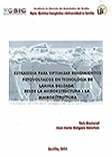
José María Delgado Sánchez
Director/es: María Dolores Alba Carranza Universidad de Sevilla 18 February 2015
Miguel Antonio Bautista
Director/es: Alfonso Bravo León Universidad de Sevilla 27 February 2014
Santiago Medina Carrasco
Director/es: Dra. María Dolores Alba Carranza, Dr. Miguel Angel Castro Arroyo Universidad de Sevilla 1 June 2012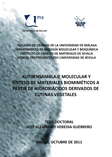
José Alejandro Heredia Guerrero
Director/es: José Jesús Benítez Jiménez y Antonio Heredia Bayona Universidad de Málaga 28 October 2011
Moisés Naranjo Muñoz
Director/es: Miguel Angel Castro Arroyo Universidad de Sevilla 25 June 2010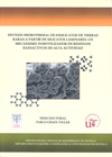
Pablo Chain Villar
Director/es: María Dolores Alba Carranza Universidad de Sevilla 18 December 2007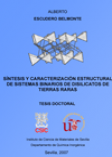
Alberto Escudero Belmonte
Director/es: Ana Isabel Becerro Nieto Universidad de Sevilla 9 July 2007icms











